

What Do The Mountain Categories Mean in The Tour de France?
Alpha ninja explains how mountains are categorized in the tour de france.
12 July, 2016 Alpha Ninja Ask Alpha Ninja

Tim: Hey Alpha Ninja! What are all the categorizations of the mountains in the Tour de France? I keep seeing numbers thrown around, but I don’t quite understand what they mean.
Hey Tim: Welcome to the world’s most confusing question. OK, not that the basic classifications are confusing, but when the asphalt of the Tour de France heads skyward, things get a little air-headed.
How Are Tour de France Climbs Classified?
Each of the mountain categories get increasingly more difficult from 4 to HC. The peeps in charge determine classifications based on gradient, distance, and max elevation:

Category 4:
The easiest climbs. Like pretty much a descent for the peloton. Usually needs to be at least 4km and 4% gradient (or a steeper gradient and shorter distance)
Category 3:
Getting a little tougher here. The pros are probably having a tough time holding the high note to “Let It Go.” As a rule, around a 6% gradient for 4km or so. Sometimes shorter distances at around 8% gradient.
Category 2:
Longer climbs that are sometimes steeper. Heavier breathing for the peloton, but they’re probably still humming whatever tune keeps their minds off the men in devil costumes (or worse) running alongside them up the climbs. Generally more than 5km at 7% gradient or longer than 10km at around 5%.
Category 1:
This one has Froome studying his handlebars pretty closely as he concentrates on the glory of things like how well yellow jerseys go with his eyes. Roughly 5-10km at 8% gradient or 15km+ at 6%.
HC or “Hors Category”:
This is a slick French term that means the climb is above categorization. These are the days that sprinters buy streamers for . . . as decorations for their pity party. Long climbs. 15km, 20km, 30km. Steep, long, brutal. At least 15km above 8%.
Subjectivity of Tour de France Climbs
So all those numbers I listed above only kind of matter. Because there’s another word that also matters: subjectivity. For instance, if organizers feel like a climb is harder, it’ll get a higher rating. Or if a Cat 1 comes near the end of a stage, it turns into an HC. So I’m happy to have sort of answered your question as it kind of applies.
Well, that’s what I’ve got. Hope it helps, Tim. You can be cool like Tim too, just send me whatever questions you’ve got , and get answers.
- ask alpha ninja
- category climbs
- mountain classifications
- polka dot jersey
- questions and lists
- tour de france
I read once that the classifications were based on what gear your car need to be in to climb the hill.
I think that was an old classification used decades now. You have better cars these days, so it wouldn’t be needed now
Leave a Reply Cancel reply
Your email address will not be published.
Sign me up to get new articles via email!
Notify me of follow-up comments by email.
This site uses Akismet to reduce spam. Learn how your comment data is processed .
Copyright © 2019 | SLO Cyclist
Climb categorization explained
In 1933, the Tour de France introduced the mountain classification. Riders received points when they were first to reach the summit, but at that time, there was only one category. Over the years, additional categories have been introduced, ranging from the most challenging Hors Catégorie ('beyond categorization') down to the 4th category. These categories have been adopted by other prominent cycling races such as the Giro d'Italia and the Vuelta a España. However, a significant issue persists: the subjective nature of categorizing climbs.

Unfortunately, the mountain classification of the grand tours is not designed to set a standard for recreational cyclists. For example, the categorization of a climb can change due to its location on the course, or simply because it suits the organizer better (€). Regrettably, there is no exact science behind determining the mountain categories. To establish a standard on climbfinder, we have tried to introduce a logical and consistent formula, which in fact aligns very well with most categories in professional cycling races.
Categorization based on difficulty points
Strava and other GPS services use a simple formula based on the average ascent and length of the climb. We believe this approach is too simplistic, because the (sometimes undulating) course of the climb has a huge influence on how much effort it costs to reach the top of the climb. That's why we spent a lot of time accurately calculating the difficulty level of climbs . In fact, we are so convinced of the accuracy of the difficulty points that we also use them to determine the mountain categories.
The sole subjective aspect of our standard lies in the transitions between the categories. However, in this regard, we conducted extensive research. We analyzed hundreds of climbs and compared them with the classifications they received in the grand tours. Through this process, we arrived at the scale outlined below.
From Super Hors Catégorie down to the 5th category
- Super Hors Catégorie (SHC) . These are the most difficult climbs in Europe. Because the list of Hors Catégorie became too large and we have several real monsters in Europe, we added this extra category. These are the most terrible, challenging, and often absurdly steep climbs! Brace yourself. These are the climbs above 1500 climbing points. A notable example is the Angliru .
- Hors Catégorie (HC) . Ascents on climbfinder only get the famous "HC" classification if the climb scores more than 900 difficulty points. The Mont Ventoux and the Stelvio are proud owners of the "Hors Catégorie" classification. The Hors Catégorie was introduced in the Tour de France as recent as 1979. It's a category that appeals to many cyclists' imaginations.
- 1st category . Climbs of the first category are certainly not to be underestimated. For example, nothing less than the famous Col d'Izoard is a category 1 climb, to the great disappointment of some cycling tourists. Climbs with 600+ difficulty points will be in this category.
- 2nd category . The somewhat shorter climbs often do not exceed a "Category 2" label. The Ballon d’Alsace is a good example of the type of climbs you can expect to find in this category. Climbs must have a minimum of 300 difficulty points to fit in this category.
- 3rd category . In the Alps these are the easy options, but in the lower mountain ranges or highlands these can be the highlights of the day. A climb needs at least 150 difficulty points to fit in this category.
- 4th category . With 75 difficulty points a climb falls into the fourth category. Don't think you can just sprint up these hills, it's still going to hurt.
- 5th category . The fifth category includes all climbs from 25 climbing points onwards. Although these are certainly not very difficult climbs, they can be quite steep walls (albeit short) or climbs that you definitely feel, albeit secretly. In lower hill areas, these are often the toughest climbs. Great for training.
- No category . Everything below 25 climbing points has no category. These are the easiest climbs in Europe. To be listed on climbfinder, a climb must have at least 5 climbing points, or be very special.

Comments (2)

I started road biking shortly before retiring but only seriously post retirement. I am now fitter pro rata than I have been at any age pro rata and believe that cycling and stretching are the key. Add in the fact that I have lots of interests, stay really busy and plan to live to 114 has made life more enjoyable than at any other time. I am 65. as of late 2023 Increased interest in living as long as possible as taken this wine drinking lover of poor food onto a better diet, better hydration, better sleep and less stress. Of course, only working if I want to and being financially comfortable has helped but all of this is within the grasp of most people if they want to take control of their life. Don't expect handouts, do what you can and become more self reliant. most importantly develop the mantra that worry is a wasted emotion..

Thanks for the wonderful explanation. I will now look at all the climbs I've done in the past and see how you treated them!
Add my review/story
If you want to share something you need to create an account. It only takes 1 minute and it's completely free.
- Add photos of your conquered climbs.
- Share your experience on all ascents you've climbed
- Submit your favorite climbs
Already have an account?
You have 50 climbs on your lists, if you want to add more you can do so with climbfinder+.
No more boring rides with climbfinder+
Your cart is empty

How are the Tour de France climbs classified?
The Tour's race director explains to Rouleur exactly how the category of each of the race's climbs is determined
Words: Tom Davidson
The climbs of the Tour de France are inscribed in cycling’s mythology. Over the decades, the mountains have played host to some of the sport’s most memorable moments, with the race often won and lost on their slopes. From the Alpine passes to the slight bumps in the road, each ascent is assigned a category that denotes its difficulty: fourth, third, second, first, and for the toughest of them all, hors catégorie (HC) – quite literally unclassifiable.
For aspirants to the King of the Mountains throne, the climbs are a hunting ground. Each ascent is ranked in order to allocate points to those vying for the polka dot jersey. Be the first over a fourth category climb and you’ll claim a single point. But beat your rivals to the summit of an HC mountain and you’ll add 20 points to your tally, double if the climb marks the stage finish.
Legend has it that the classifications were originally decided with a Citroën 2CV car, with the climb’s category judged to be the same as the gear necessary to motor up it. For Thierry Gouvenou , the Tour’s race director and the person responsible for designing the race route, that’s all nonsense.
“Perhaps the story came from a drunken night between journalists,” Gouvenou tells Rouleur . “In cycling we have so many stories like that that have been embellished over time. Maybe there’s some truth in it somewhere, but I’m not convinced.”
The formula
When it comes to classifying climbs, Gouvenou and his team at ASO rely on a simple mathematical formula. “Essentially, if we have a climb that isn’t so well known, we multiply the distance by the average gradient squared,” he says. “That gives us a number which then gives us a score.”
Let’s take, for example, Alpe d’Huez. With its 21 hairpins, the mountain stretches out 13.8km in length, at an average pitch of 8.1%. The sum therefore is 13.8 x (8.1 x 8.1), giving a score of 905.
Gouvenou and his team found that the following scores correspond to the long-established categories:
600+ points – hors catégorie
300-600 points – 1 st category
150-300 points – 2 nd category
75-150 points – 3 rd category
Up to 75 points – 4 th category
“I applied this [formula] to the Tour de France and went back over all the climbs about 15 years ago,” says Gouvenou. “As it turned out, most of what had been done over the years fit within this framework. There are exceptions of course, but for the most part, it matched up.”
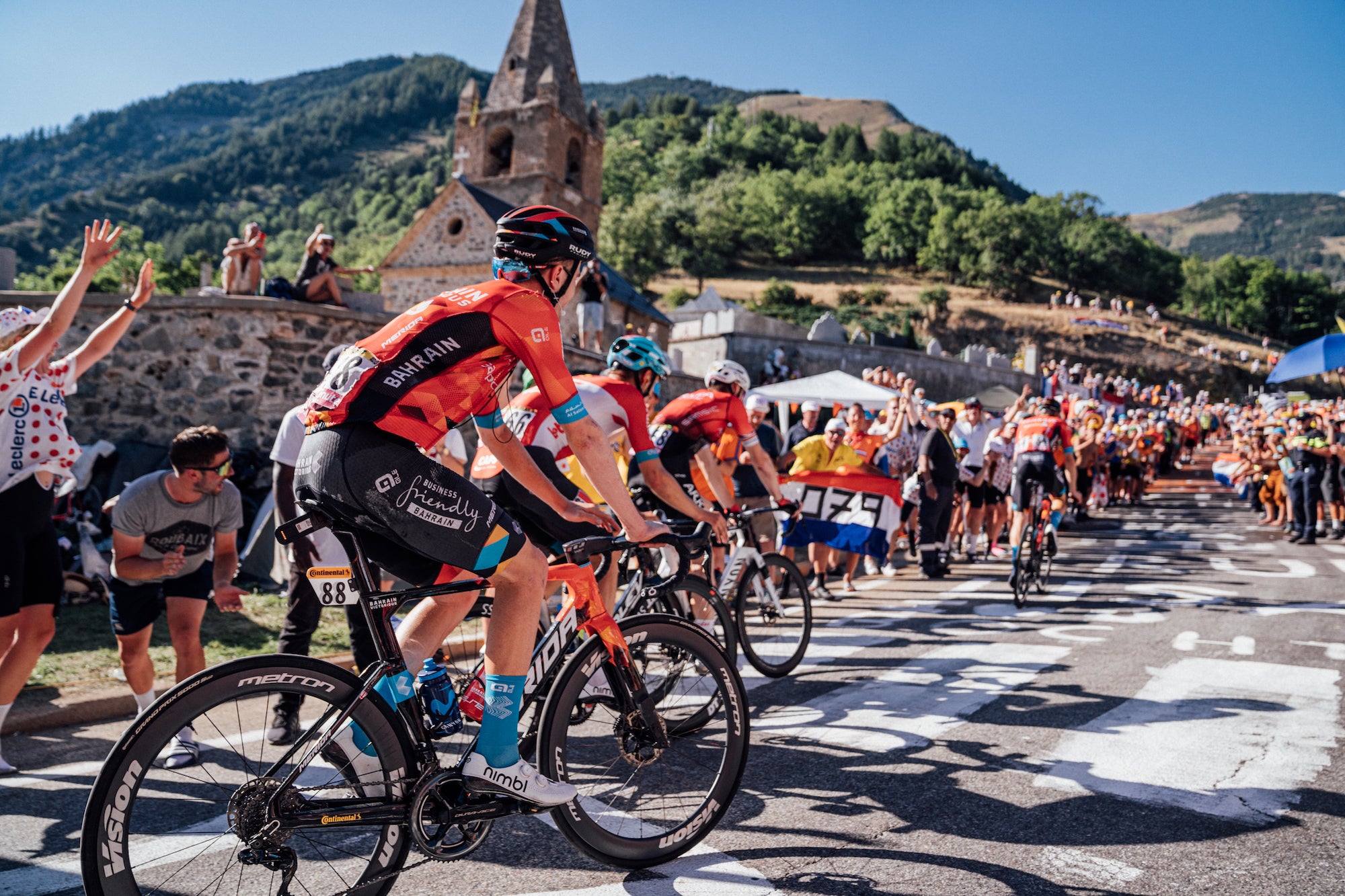
When faced with a new ascent, Gouvenou and a handful of fellow former professional cyclists travel out to the climb to make an assessment with their own eyes. This is what happened in 2019, when the team headed to the Alps to see the newly paved Col de la Loze, which was set to make its Tour debut the following year.
Read more: The toughest climbs of the 2023 Tour de France
“When we did the recon [of the Col de la Loze] in the car, we realised we had something exceptional in front of us,” Gouvenou says. Using his formula, the race director punched the numbers into his calculator and found that the climb scored a jaw-dropping 1,300 points, more than twice the amount required for HC classification.
Today, the Col de la Loze stands as one of the highest ranking mountains the peloton has ever tackled, alongside the Col du Portet, Mont Ventoux, the Col de la Madeleine, and the Plateau de Beille.
Other factors to consider
It’s not all about mathematics, though. For climbs that aren’t as clear-cut as these towering peaks, Gouvenou and his team take a host of other details into account. One factor that helps them decide is the ascent’s placement within a stage. “The closer the climb is to the finish line, the greater the chance it will be bumped up a category,” says Gouvenou. “This doesn’t tend to happen with the big climbs, though. It’s mostly for the lesser-known ones.”
History plays a part, too. In fact, for Gouvenou, this is where the “subjective side” of climb classification really comes into play. “Climbs where there have been great battles, big cycling moments. That helps us to rank them.”
The iconic Col du Galibier is one such climb. First introduced to the Tour de France in 1911, the Galibier has two ascents, both of which were tackled in the 2022 Tour. On stage 11, the riders climbed the tougher route heading south from Valloire, before taking the easier road up from Briançon in the following stage. Using ASO’s formula, the first ascent scores 843 points, while the second comes in at 598, two points shy of HC classification. Still, given the Galibier’s century-long love affair with the race and its dizzying height of 2,642m, the climb keeps its HC status in both directions.
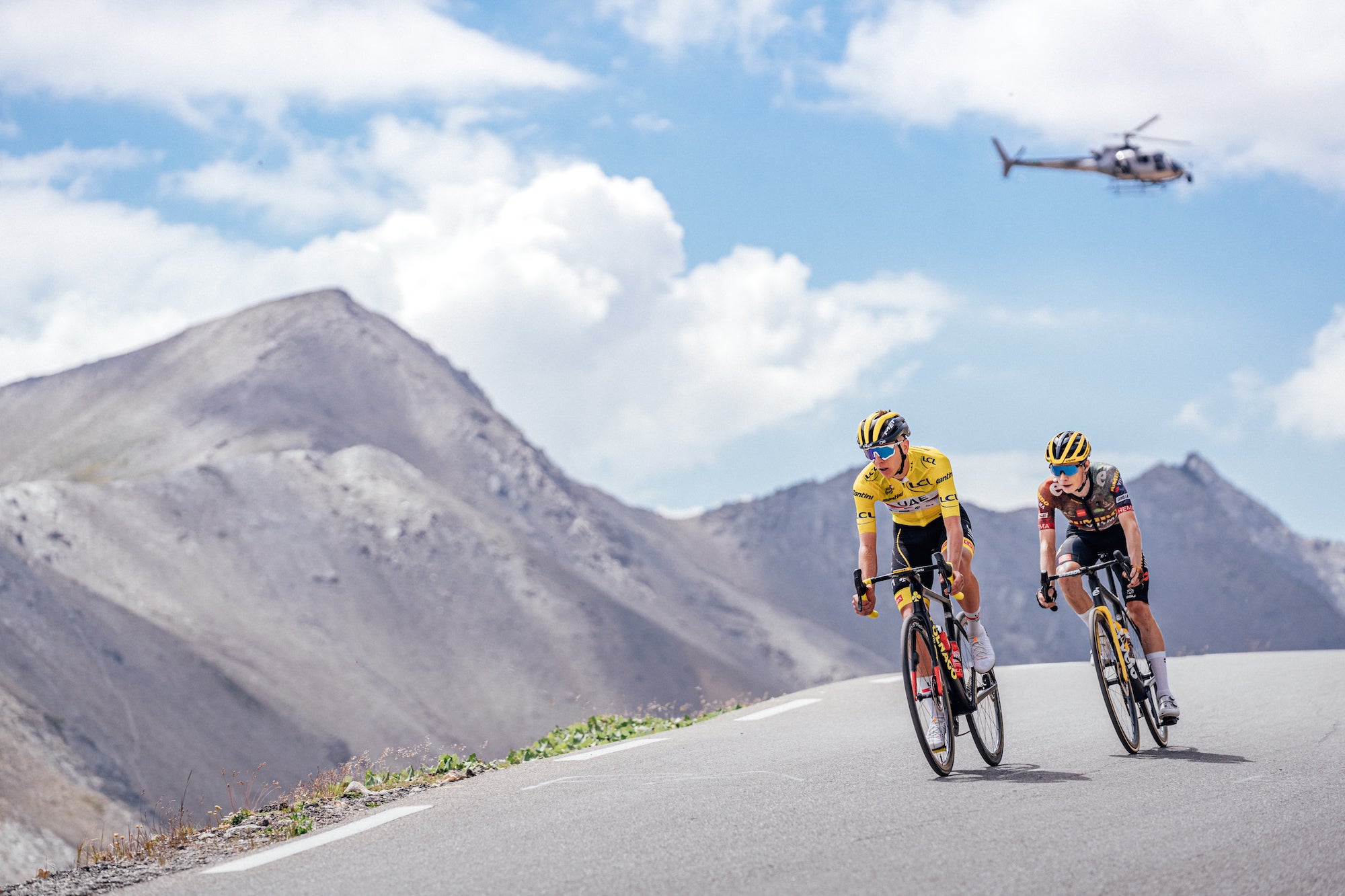
There’s also a lot of consideration given to the smaller foothills. “We sometimes classify climbs as fourth category that don’t really merit it,” says Gouvenou. “That’s a bit what happened in Denmark [with this last year's route].”
Read more: How Thierry Gouvenou designs every kilometre
The 2022 Grand Départ took place in the flatlands of Scandinavia, where the riders rolled over six category four climbs before they entered France for the first time. These short ascents barely met the threshold for classification according to ASO’s formula, but, Gouvenou explained, they were classified to kickstart the polka dot jersey competition in the opening days of the race.
What’s clear is that, despite having a formula to rely on, the old-school approach has not been lost when categorising climbs. “We’re not strictly rigid with the classifications,” says Gouvenou. “The maths is really just to verify.”
*Cover image by Alex Whitehead/SWPix.com

Team Cars | Service Des Courses - Organic Unisex T-shirt

Rouleur Team Cars Bone China Mugs

Rouleur ELITE Jet Water Bottle Bidon - 550ml

Rouleur Logo Organic Unisex T-Shirt - Black/White

Team Cars | Campagnolo - Organic Cotton Unisex T-Shirt

Rouleur Logo Organic Unisex T-Shirt – White

Rouleur Logo - Organic Sweatshirt - Unisex - Burgundy

Team Cars | Peugeot - Organic Cotton Unisex T-Shirt

Colours of the Peloton - Short Sleeve Base Layer - Men's

Rouleur Logo Organic Unisex T-Shirt – Tonal Grey

Team Cars | Raleigh - Organic Cotton Unisex T-Shirt

Rouleur Logo Organic Sweatshirt - Unisex - Grey

Coppi - Rouleur Notebook

Rouleur Logo - Organic Sweatshirt - Unisex - French Navy

Rouleur Logo - Organic Hooded Sweatshirt - Unisex - Heather Blue

Rouleur Logo - Organic Jogger Pants - Unisex - French Navy

Rouleur x Kaweco Rollerball Pen - Black + Gold foil logo

Allez - Organic Cotton Unisex T-Shirt

Tours Issue - Rouleur Tote Bag

Dai! - Organic Cotton Unisex T-Shirt

True Grit - Rouleur Notebook

Rouleur Water Bottle Bidon - Ride Fast, Read Slow - Cream + Green

Rouleur Water Bottle Bidon - Green + Pink

Rouleur x Kaweco Rollerball Pen - Brass + Black etched logo

Rouleur Embroidered Organic Cotton Unisex T-Shirt - Natural Cotton + Green

!Vamos! - Organic Cotton Unisex T-Shirt

Colours of the Peloton - Short Sleeve Jersey - Women's

Rouleur Logo Women's T-Shirt - Navy

Rouleur x Kaweco Aluminium Rollerball Pen - Silver + Engraved logo

Rouleur Logo - Organic Jogger Pants - Unisex - Heather Grey
Cookie banner
We use cookies and other tracking technologies to improve your browsing experience on our site, show personalized content and targeted ads, analyze site traffic, and understand where our audiences come from. To learn more or opt-out, read our Cookie Policy . Please also read our Privacy Notice and Terms of Use , which became effective December 20, 2019.
By choosing I Accept , you consent to our use of cookies and other tracking technologies.

Podium Cafe, for Cycling fans
- Race Previews
- Tour de France
2022 Tour de France Mountains Preview - Let's Rank the Mountains
By _Will_ @cyclingalps on Jul 2, 2022, 4:45am EDT +

Col du Galibier will be climbed twice
Bonjour, bienvenue en France. La Grande Boucle is more of a half circle this year. With a start in Copenhagen, the peloton will then evacuate to Dunkerque and ride down the east side of France eventually reaching the Pyrénées mountains. Along the way, the route visits the five largest mountain ranges in France (Vosges, Juras, Alps, Massif Central, and Pyrénées).
There are six mountain stages. Vosges (1), Alps (3), Pyrénées (2). Five of these stages (arguably all six) are mountain-top finishes.

Strangely the ever present Col du Tourmalet is not in this year's Tour. But don't worry we have Alpe d'Huez for Jens and all the other fanboys. At 2 642 metres, Col du Galibier will be the highest point of the race. For our UK readers that is 8 668 feet. In fact both the north and the south side of Galibier will be climbed. It will be the first ascent (north side) when the Prix Henri Desgrange will be awarded to the first rider to reach the summit of the highest point of the race.
By my count there are 59 classified climbs:
hors categorie = 7 category 1 = 10 category 2 = 6 category 3 = 14 category 4 = 22
This will be a long article.
I’ll add pictures for those that hate reading. But below we will:
- Rank all the Hors Categorie, Cat 1, and Cat 2 climbs by difficulty
- Take a look at all six mountain stages.
- Give a few brief recommendations for visiting cyclo-tourists.
- Let you, dear readers , vote to decide the Queen Stage. Allons-y (let’s go)! Below are the statistics for the twenty-three Hors-Categorie, Category 1, and Category 2 climbs including a difficulty rating.
DIFFICULTY RATING METHODOLOGY - To rate the climbs I have used the difficulty index from www.climbbybike.com that we have used previously. I know, I know, it’s a slightly flawed formula. But it’s easy to calculate and useful as a starting point for discussion. I am using the official Tour de France lengths and average grades for each climb, so rankings may differ slightly with those at climbbybike.com.

According to our methodology Col du Granon is the toughest climb in the 2022 Tour de France. Surprisingly, this is only its second Tour appearance - in part because it is a dead-end at least as a paved road. Its first appearance in 1986 was the highest mountain-top finish in Tour de France history (2413m), now only surpassed by the 2011 mountain-top finish on Galibier (2642m).

Col du Granon
You will see Col du Granon referred to as "Col du Granon Serre Chevalier" in official Tour de France literature. This is just marketing. Serre Chevalier is a nearby ski station that is clearly paying some marketing €'s. There are no ski lifts nearby. Most of Serre Chevalier skiing is in the mountain massif across the valley from Granon
The eight toughest climbs appear in just three stage (11,12, 18), all with mountain top finishes. Keep this in mind when voting for the Queen stage.
You likely know that the Tour starts in Denmark. But did you also know that the peloton will visit another country? The 9th toughest climb (Col de la Croix) and the 20th toughest climb (Col des Mosses) are in Switzerland as our cycling overlords have organised Stage 9 starting from UCI headquarters in Aigle. The stage finishes in France after crossing the border at Pas de Morgins the 11th toughest climb.
Before we discuss the 6 official mountain stages, here are the same twenty-three climbs grouped by stage:

Let’s walk through the six mountain stages:
Stage 7: vosges mountains.

La Planche des Belles Filles is a small ski station in the Vosges. This is its 6th Tour debuting in 2012. I sometimes call it one of the least charming major climbs I know. It is quite contrived: an extremely steep, modern road without much view. But for a pro bike race? Fantastic. It is deviously evil. Ouch!

The name La Planche des Belle Filles comes from an episode in the 30 years war in 1635 when according to legend the young girls of a neighbouring village hid themselves up this mountain to escape the cruel Swedish mercenaries who were stationed nearby at Plancher-les-mines. To escape abuse and probable massacre they preferred to commit suicide by jumping from a plank into the black waters of a lake on the plateau. A wood statue by a local artist commemorates this legend.

"Super" was added to the name in 2019 when the "super" steep final ramp was extended moving the finish to an altitude of 1140m versus the previous 1035m. Chris Froome won the inaugural 2012 stage with a time 16'11" . My time was closer to Etienne's 43 minutes.

The final kilometre: Steep modern road.

Stage 9: Swiss Alps
This stage not only starts in Aigle, the UCI folks will also get to cheer the peloton when it passes them again 150 kms into the stage.
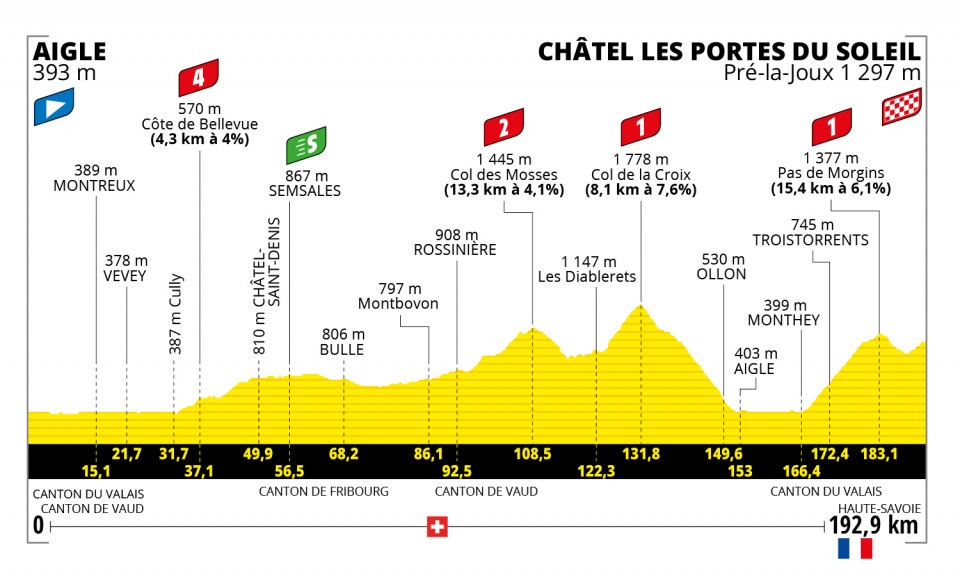
As the bottom of the chart above shows this stage is primarily in (the French-speaking) part of Switzerland or Suisse Romande. Not surprisingly, Col des Mosses and Col de la Croix often feature in the Tour de Romandie. But both cols have previously appeared in the Tour (Mosses 6 times, 1947 debut. Croix twice).
I endeavour to give you the best photographs of climbs I can. So ...... here is Col des Mosses:

My editor had demanded I do better. So here is a Col de la Croix several years ago freshly cleared of snow for a Romandie stage. Podium Cafe kit!!

Snow plough almost in view. High above nearby is glacier skiing at Diablerets ski station. It's a beautiful climb

Is this stage a mountain-top finish? Sort of. It climbs the 11th toughest climb, Pas de Morgins.This is the border between Switzerland and France - "Pas" is an old word occasionally used instead of col, for a mountain pass. The route briefly descends into France and then there is a brief, not too steep, uphill finish in Châtel.

The finish town is Châtel. Les Portes du Soleil is more Tour marketing. It is the name of a gigantic ski domain uniting 13 resorts some Swiss, some French (eg. Avoriaz and Morzine). Yes, you can ski between countries quite easily all day long without your passport.
For the Cyclo-tourists:
What's the steepest % grade sign I have ever seen while biking. Exactly on the France/Swiss border in the heart of the Portes du Soleil ski domain is the Le Mur Suisse (The Swiss Wall), a famous ski piste.
I had cycled up on ski slopes on the French side and after checking my brakes decided 90% was too steep a descent for me. Châtel is in the distance, off to the left, out of the photo.

Stage 11: French Alps
What a stage! Wow.
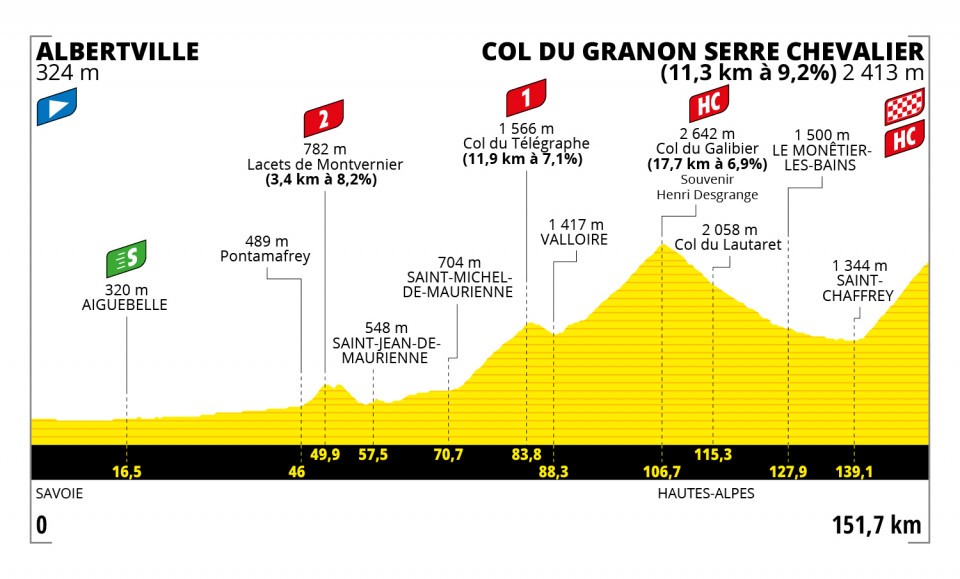
As an appetiser stage 11 will start with a visit to the amazing Lacets de Montvernier.
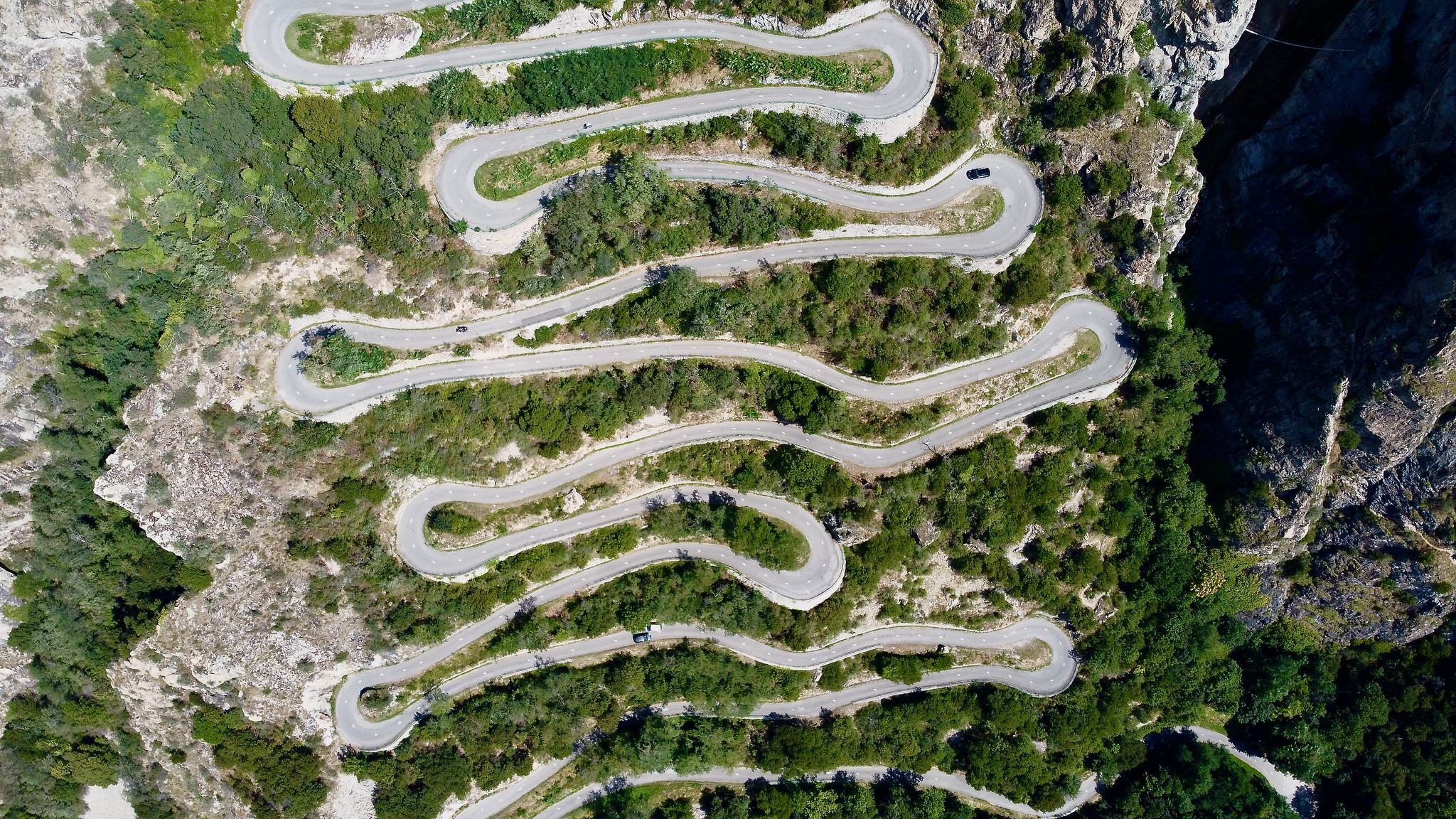
For the cyclo-tourists : The only way without a helicopter or drone to get a clear view of the hairpins: A few hundred metres beyond the summit on right is a trail through a farm road that leads to cliff look-out:
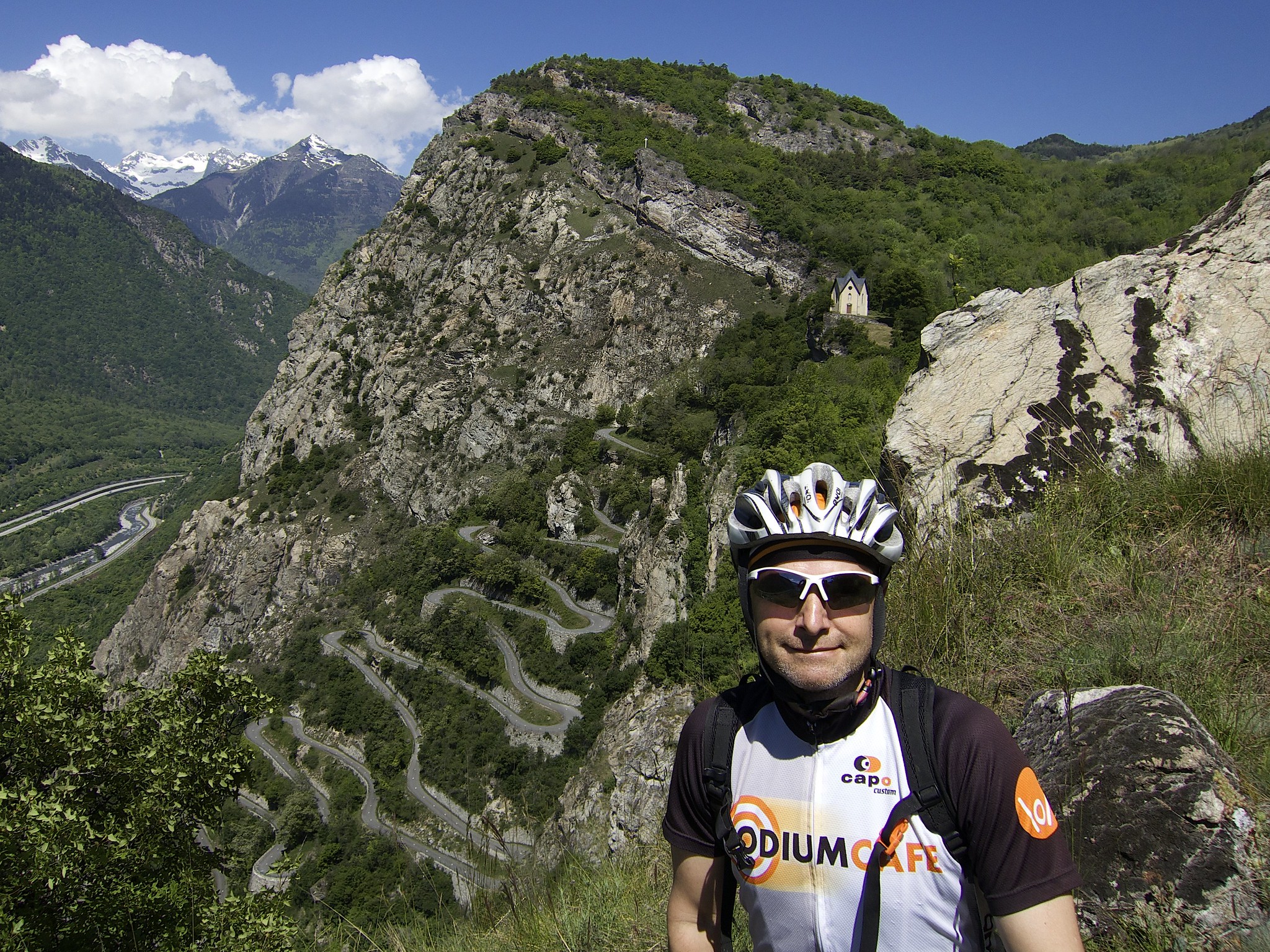
Next, the stage climbs the legendary north side of Col du Galibier via Col du Télégraphe.

Just off the main road at Col du Télégraphe is the Fort du Télégraphe perched on a cliff overlooking the valley below.
Fort du Télégraphe "previously accommodated a telegraph of the Chappe system using articulating arms to send messages between Lyon and Milan, and after 1809, Venice."

Often when climbing Galibier there will be strange straw art. I'll avoid posting the bizarre nude stuff and just post this excellent polka-dot cyclist exactly at the summit of Télégraphe.

The first ascension of Galibier in the Tour was the year following the 1910 high mountain experiment in the Pyrénées. Think Tourmalet, Aubisque, "assassins," etc. But Galibier was an order of magnitude bigger – a half vertical kilometre higher than Tourmalet.
Years ago I wrote an article "Col du Galibier - A Brief History" - see here .
Oh ! Sappey ! Oh ! Laffrey ! Oh ! Col Bayard ! Oh ! Tourmalet ! je ne faillirai pas à mon devoir en proclamant qu’à côté du Galibier vous êtes de la pâle et vulgaire bibine : devant ce géant, il n’y a plus qu’à tirer son bonnet et à saluer bien bas !" Translation: A list of famous mountain passes then " I will not fail in my work in proclaiming that beside Galibier you are but pale and vulgar beers. There is nothing more to do but tip your hat and salute from well below!" Henri Desgranges 1911 – Tour Director and publicist extraordinaire
Galibier is beautiful, epic, amazing. The col is named after the mountain peak in the centre of this photo: Le Grand Galibier (the col is 6 kilometres higher up to the right).

Our boy Jens (!!) in Podium Café kit climbing Galibier north side:

A kilometre down the far (south) side of Galibier the peloton will pass the Henri Desgranges monument. Oh, yes, there is a Galibier brand beer brewed in Valloire on the north side, Cheers!

Finally, the stage will climb Col du Granon. Steep, not easy:

I believe this will be the 3rd highest stage finish in TOUR history after Granon in 1986 and Galibier in 2011. The Spanish rider Eduardo Chozas won the 1986 Granon stage. I believe the main road was constructed to serve some military positions built in the 1930s. But there is nothing at the top now and it is apparently a popular place for local star-gazing groups. In other words it gets very dark, no light pollution.
For the Cyclo-tourists
The paved road ends exactly at Col du Granon but there are trails and superb gravel routes that lead to a bunch of higher cols and two well preserved old forts from the 19th century. Here is a link to a map and report visiting the two forts and five gravel cols.
(in photo below you can see some of the Serre Chevalier ski slopes across the valley)

Stage 12: French Alps
Another truly gigantic and beautiful stage, and also Alpe d'Huez.

The stage begins by climbing the south side of Galibier. The early part of the climb is on a not-too-steep busy-ish through road to Bourg d'Oisans but at Col du Lautaret, the route turns right and gets steeper and more interesting. The next 8 kms are superb.

From the same 12% sign - just a few metres from the col - are great views of the climb below:

I watched the 2008 Tour up here disguised as Lance Armstrong. Sorry!
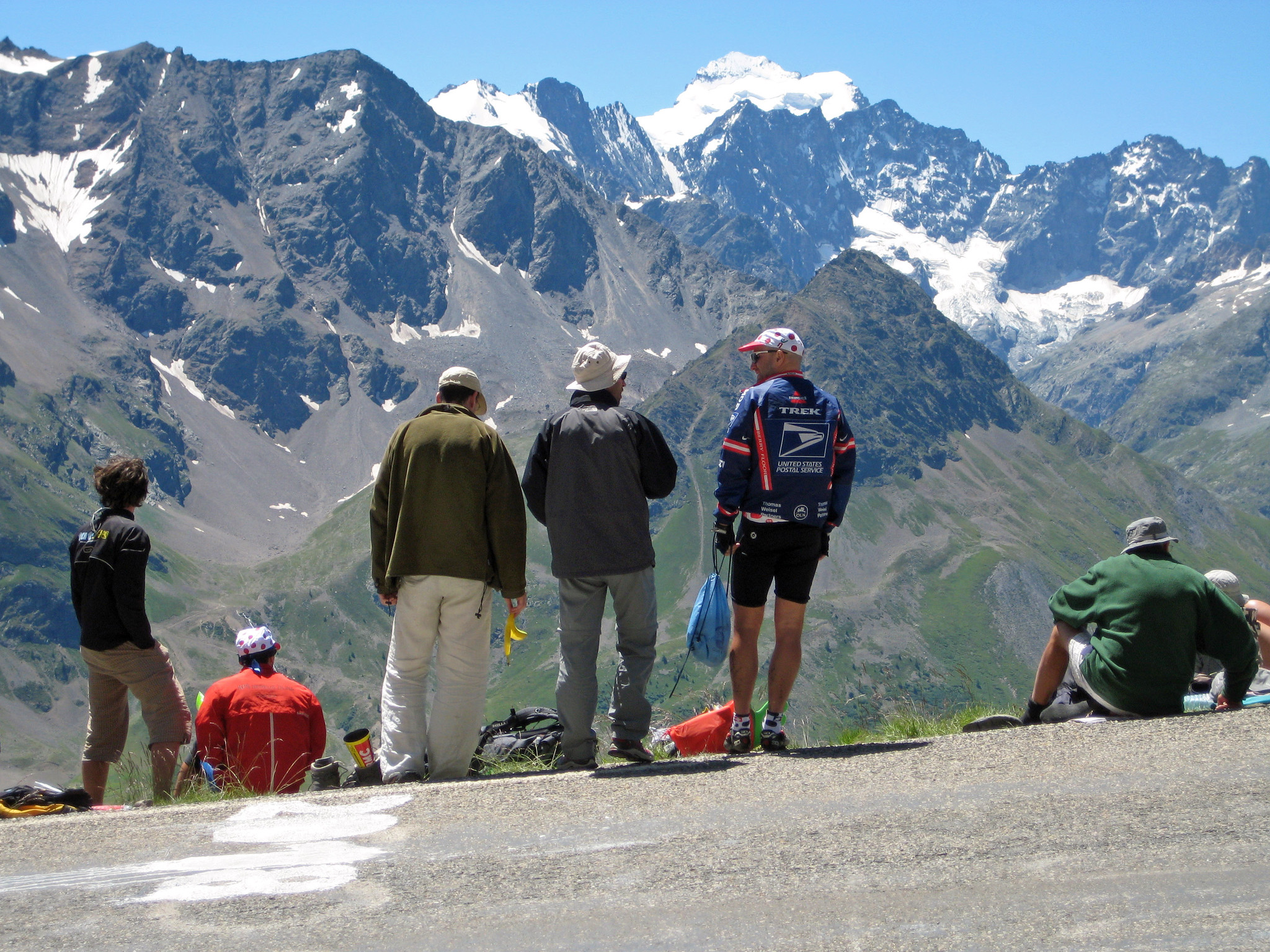
Tip : The little flat area at the summit will probably be closed to fans as it was in 2008. And the gendarmes won't appreciate "people" taking photos there. Sorry!

After summiting Galibier, the route descends the same north side that they climbed on the previous stage. A few kilometres down they will pass the Marco Pantini monument, commemorating the Italian cyclist for his epic stage victory in the 1998 Tour finishing up Les Deux Alpes (which included Galibier).

I can't imagine how fast the peloton will descend the 35 kms from the Galibier summit to the base of Télégraphe, but yikes. They will then glide through the Maurienne valley and begin the ascent of Col de la Croix de Fer.
This is a long, gigantic climb.
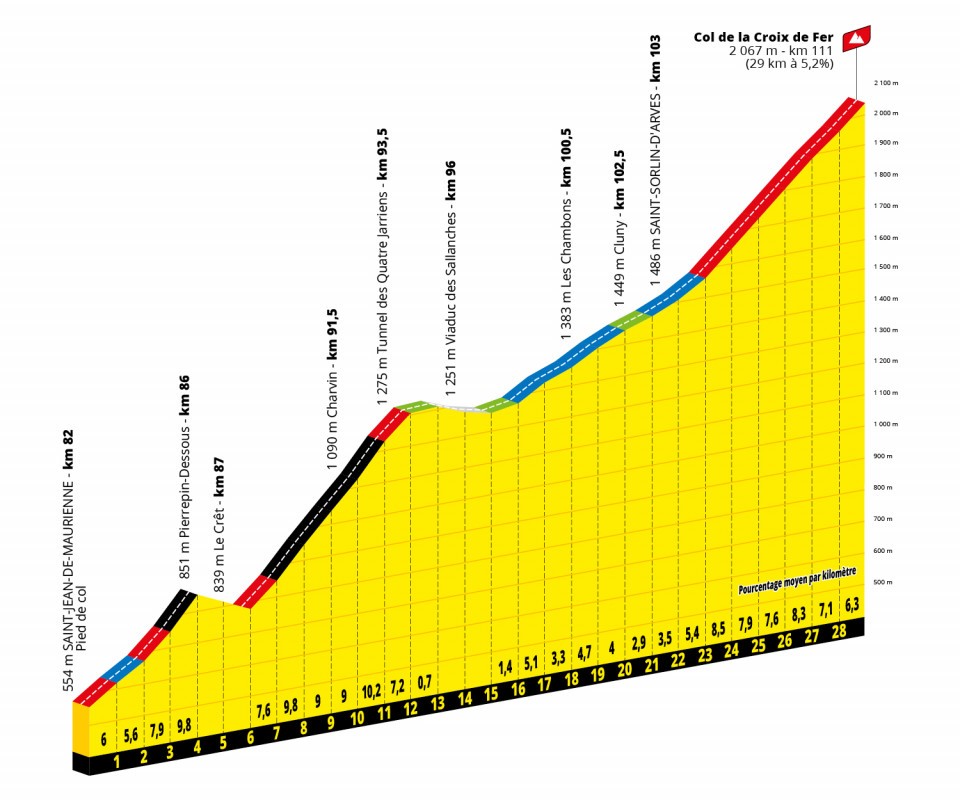
The final six kilometres of the climb are pure hairpin heaven. I can't wait to see the helicopter shots.
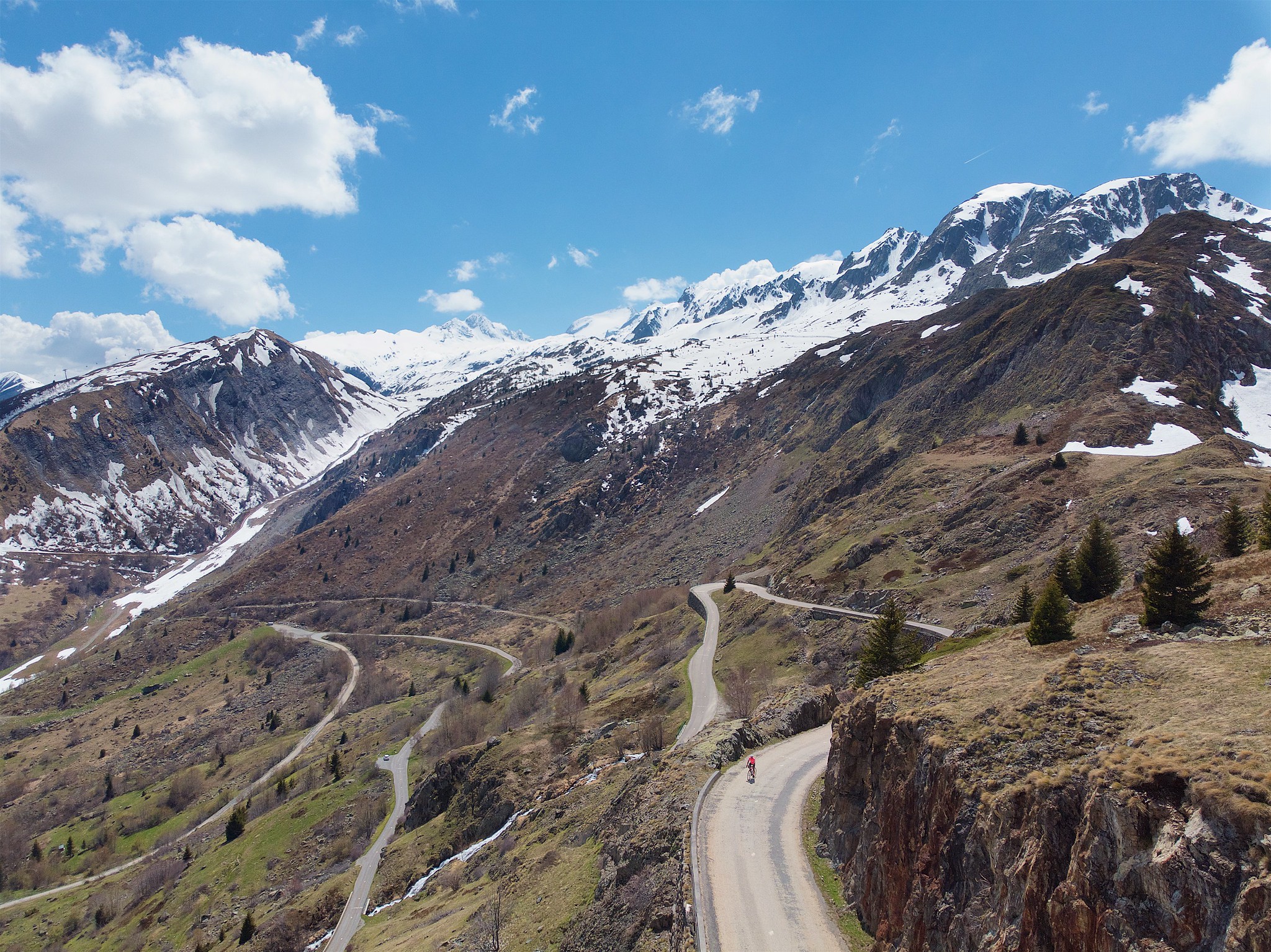
Tip: The French TV coverage will certainly point out the distinctive three peaks named Les Aiguilles d'Arve (below). Scream at your TV if your broadcasters don't know its name when the helicopters show them.
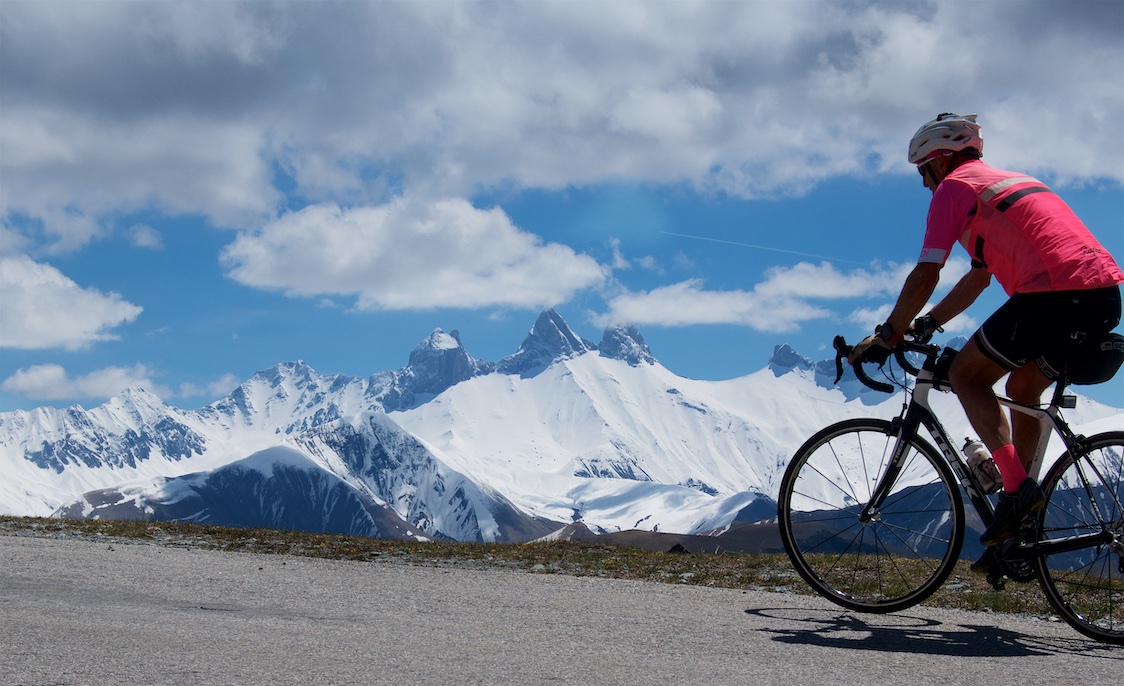
From the summit is another gigantic and generally not-technical 30 kilometre descent. At this point you can turn off the TV and go for a ride because the only thing remaining ......... is ALPE d'HUEZ and its 21 hairpins.

Tip : The hairpins count down as you climb. So the first hairpin is #21, Each hairpin has a sign with its number and the name of a stage winner (or two). The Italian legend Fausto Coppi won the first Tour stage here in 1952. And then some other fella. Also, remember, despite some bars/restaurants drawing lines on the road as you approach the village, the official finish line is through town.

Note, Podium Cafe was once many years ago painted on these hallowed hairpins. But someone defaced it!

I'll let you guys discuss in the comments who you think will win atop this legendary climb. As you know, I know nothing about pro cycling.
1. Did you know the old road up the south side of Col du Galibier still exists? First built in the 1880’s, this was the only way up the south side until 1938. As best I can tell it was abandoned/closed in 1947. This means that between 1911 and 1938 the Tour de France would have climbed or descended this road over twenty times. It is far to the east of the modern road and except near the beginning the two routes don’t intersect until the top near the Desgranges monument at the entrance of the tunnel (2556 metres). Here is a blog post where I cycled from Briançon to Galibier using this old road.

2. Exactly at the Col de la Croix de Fer summit, behind the col sign begins a little gravel road that goes far higher to a couple of alpine lakes and the Glacier de St. Sorlin. Truly spectacular. Details in this link.

3. I'll keep my Alpe d'Huez tip simple. After a victory photo at the top. Keep going. One can follow the paved road higher for 4 kilometres past Col de Poutran and reach Lac de Besson and Lac de Noir. Simple, quiet, and beautiful.

Stage 17: The Pyrénées

The very pretty Col d'Aspin has been in the Tour somewhere around 70 times, often used as a link between Tourmalet and Peyresourde. Hourquette d'Ancizan only made its Tour debut in 2012 as a sort of Aspin alternative. But now they are combined.
In between Aspin and Ancizan is the road that leads to St. Marie-de-Campan and Tourmalet. I am betting 10 beers that some announcer will still find a way to tell the Eugène Christophe forge story even without Tourmalet appearing in this year's Tour. Drink!
This is a scenic, medium difficulty stage.
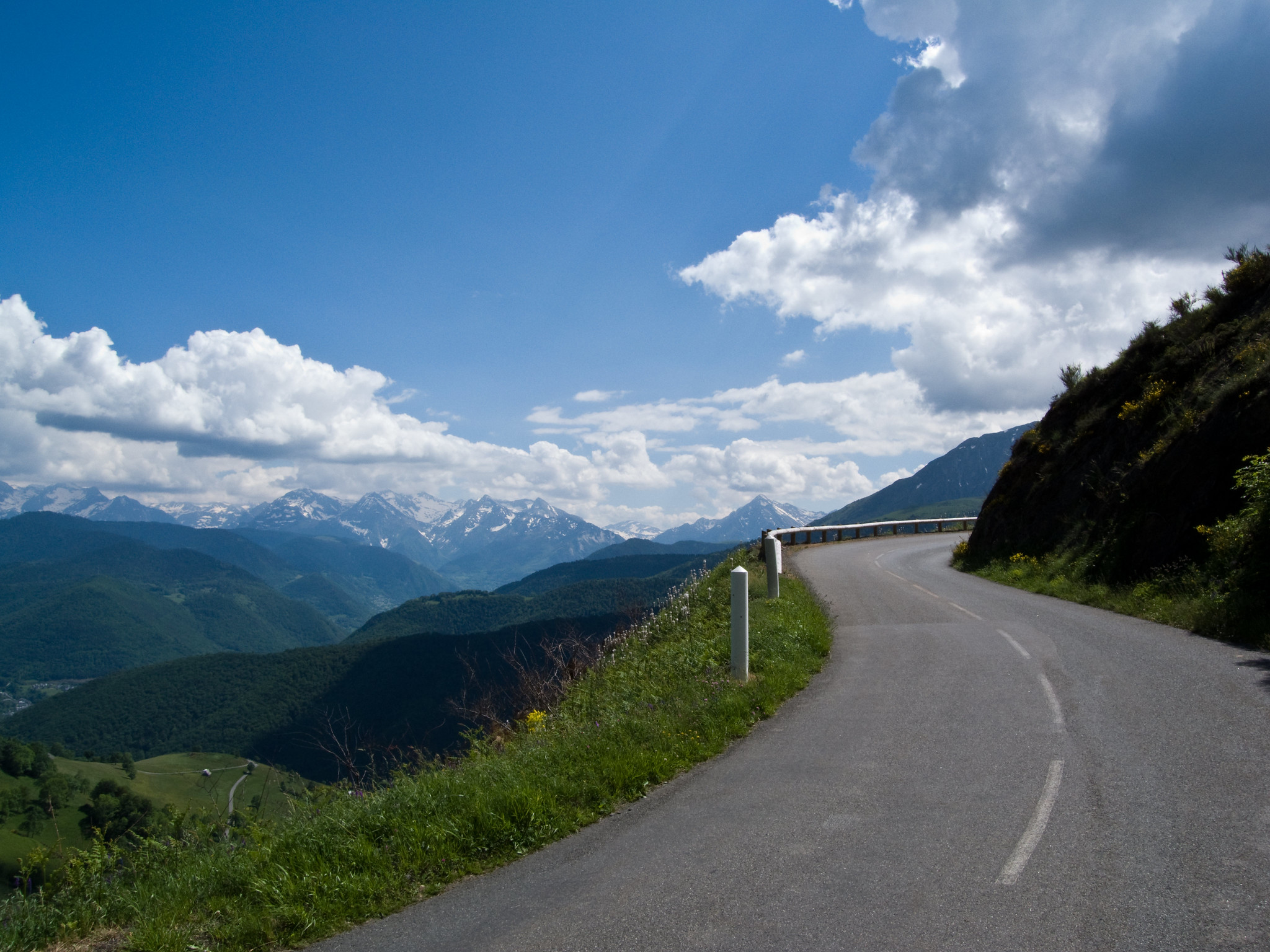
Hmm, do I have anything interesting or original to add. OK, I promise that people will confirm this as absolutely true:
Col d'Aspin is a cow col.

Hourquette d'Ancizan is a donkey col. I promise, but sorry I don't have a donkey photo. But it's a scenic, peaceful road.
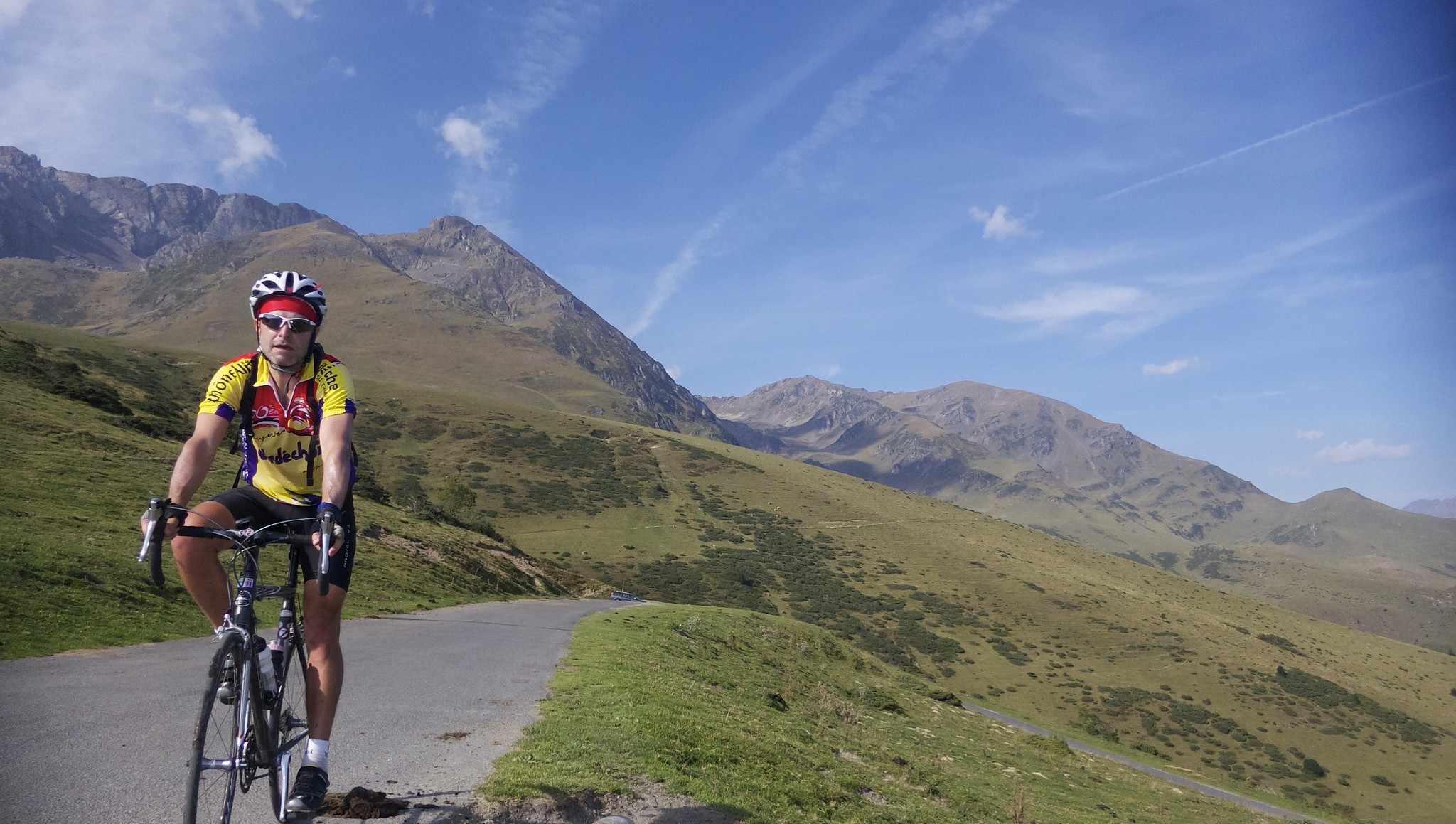
Col de Val Louron-Azet is formerly Col d'Azet but it was renamed because of the nearby Val Louron ski station. It is a cow col.

I've never ridden to the final climb at Peyragudes ski station, so please post a comment of you know its animal. Marmotte? :-)
Stage 19: The Pyrénées
This final mountain stage could decide the entire 2022 Tour de France with a challenging final climb up to Hautacam ski station. It's also a beautiful stage.

After an easy start the stage will attack the legendary Col d'Aubisque from the west side. The top of the descent is the famous cliff stretch of the Cirque du Litor.

Aubisque is a cow col. I once saw a dead cow a couple of kms from summit that had just fallen from above. I will NOT post the photo. So sad. But here's the toll collector for the Cirque du Litor.

The descent will pass Col du Soulor .... a sheep col.

The route will descend the less often used north side of Soulor. The views of this descent from Cirque du Litor are great. This will be another very good "helicopter" stage.
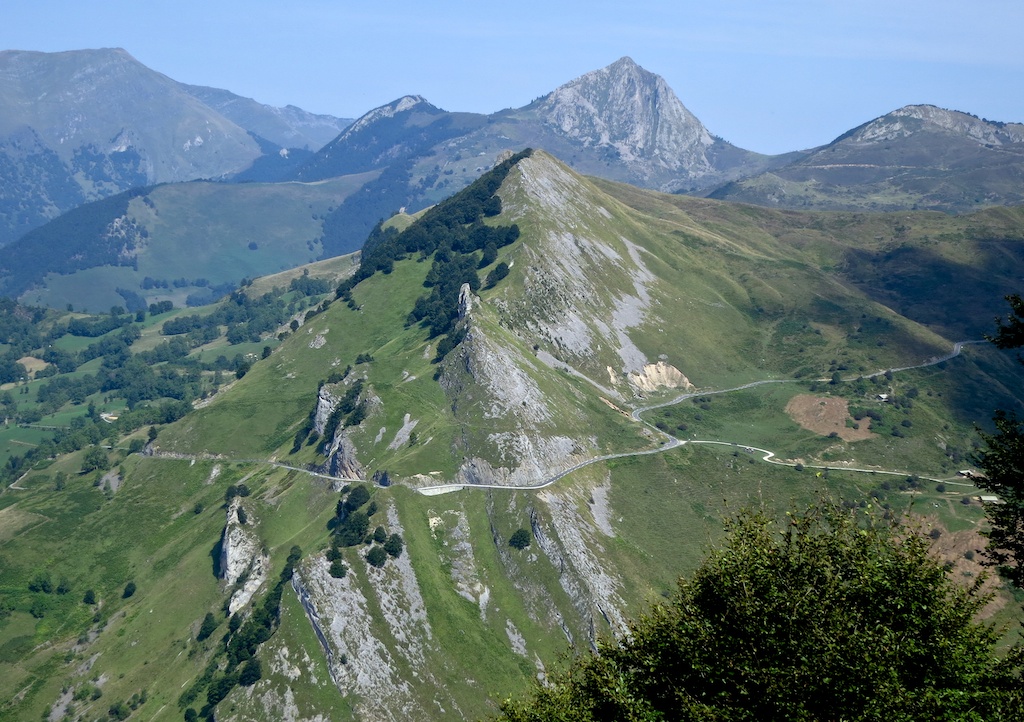
Amazingly, 2022 will be the Tour de France debut for Col de Spandelles. Wow. I will wager it has nice new tarmac as a reward. It's a fun, quiet climb, mostly forested on the descent side but very scenic on the side the Tour will climb.

Tip : Avoid the start town Lourdes. Although the Sanctuary of Our Lady of Lourdes is interesting. The town is unbelievably touristy tacky. It receives several million tourists every year and has more hotels per square kilometre than anywhere in France except Paris. The good cycling is further into the mountains.
Finally, the stage will climb Hautacam. Occasionally very steep, this will be a tough finish to the final mountain stage of the Tour.
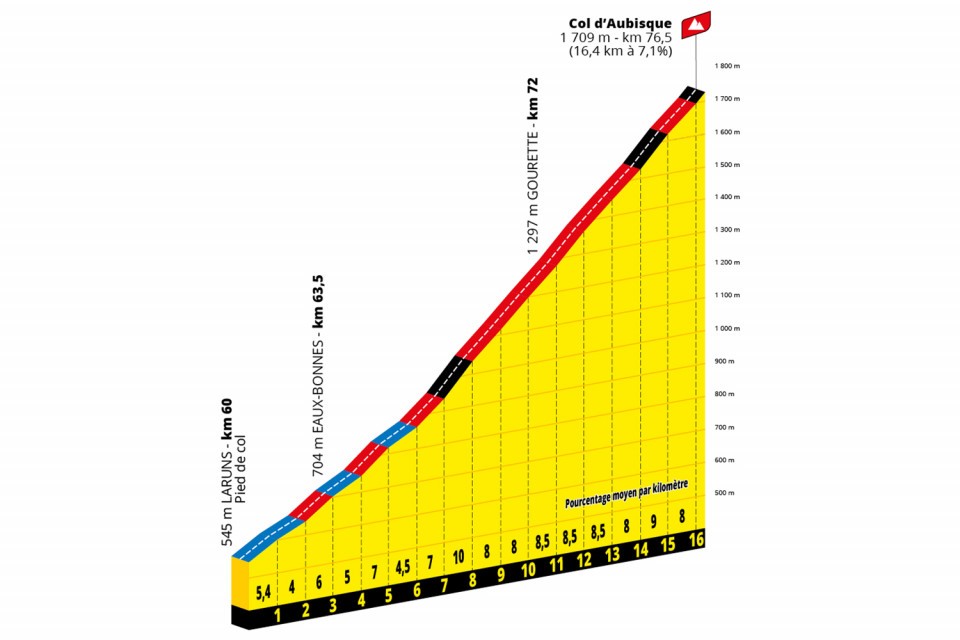
This will be the 6th Tour appearance for Hautacam. the first was in 1994 (Luc Leblanc). It is always a mountain-top finish as not a through road - although (cyclo-tourists please note) the paved road does continue 1.2 kilometres higher to Col de Tramassel. Hautacam is a horse climb:

When I visited Hautacam a house near the start of the climb has some wonderful artwork. Virenque gained weight after retiring?

Hautacam starts in a long valley that is at the base of so many brilliant cycling climbs: Tourmalet, Hautacam, Aubisque/Soulor, Spandelles, etc. And less well known, well down to the south are two truly stunning and very high paved climbs both over 2000 metres that cyclo-tourists seem to ignore.
Col des Tentes (2207m) is a hundred metres higher than Tourmalet and Cirque de Troumouse is just a touch lower. Highly, highly recommended.
Col des Tentes:
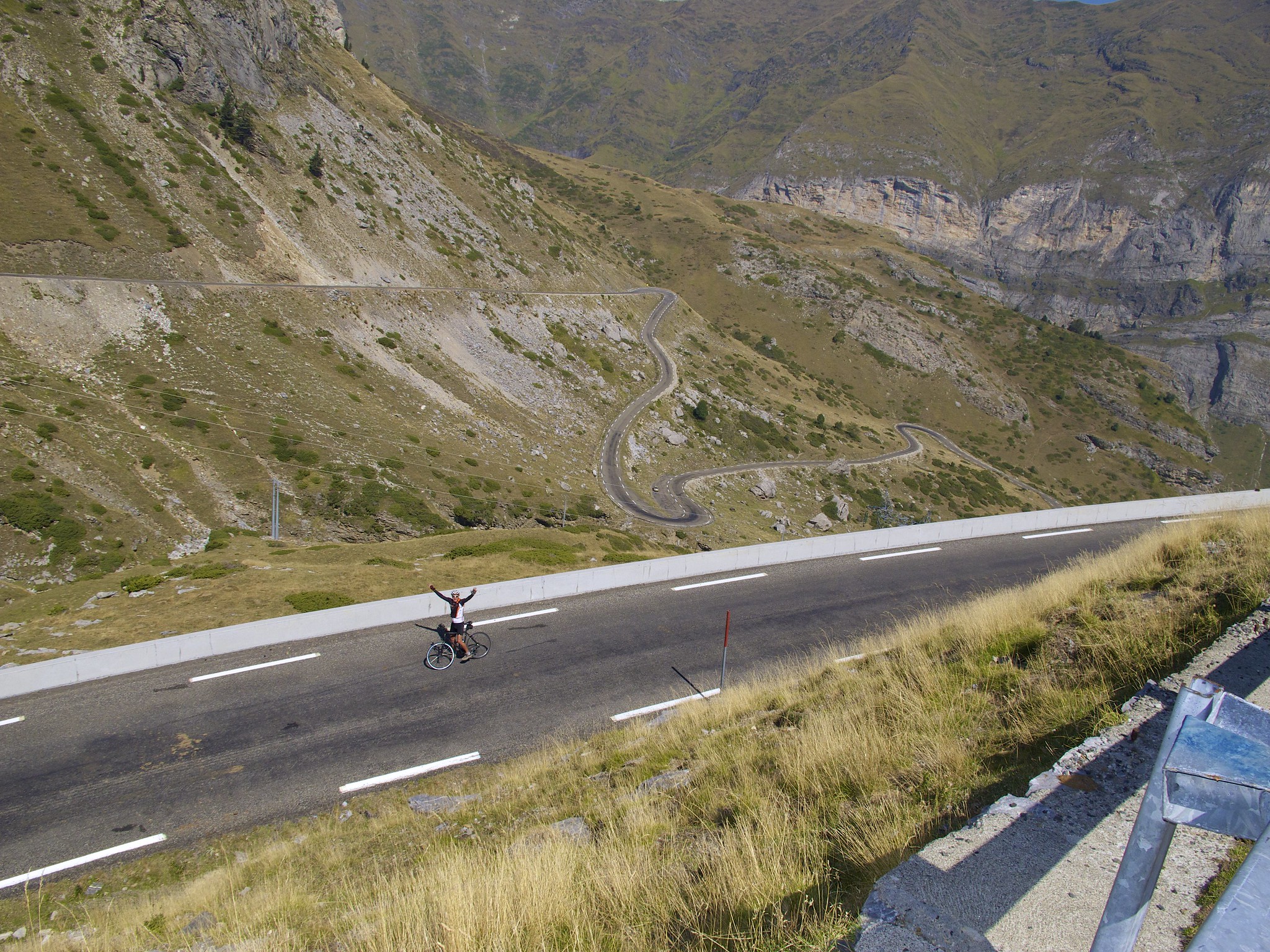
Cirque de Troumouse:
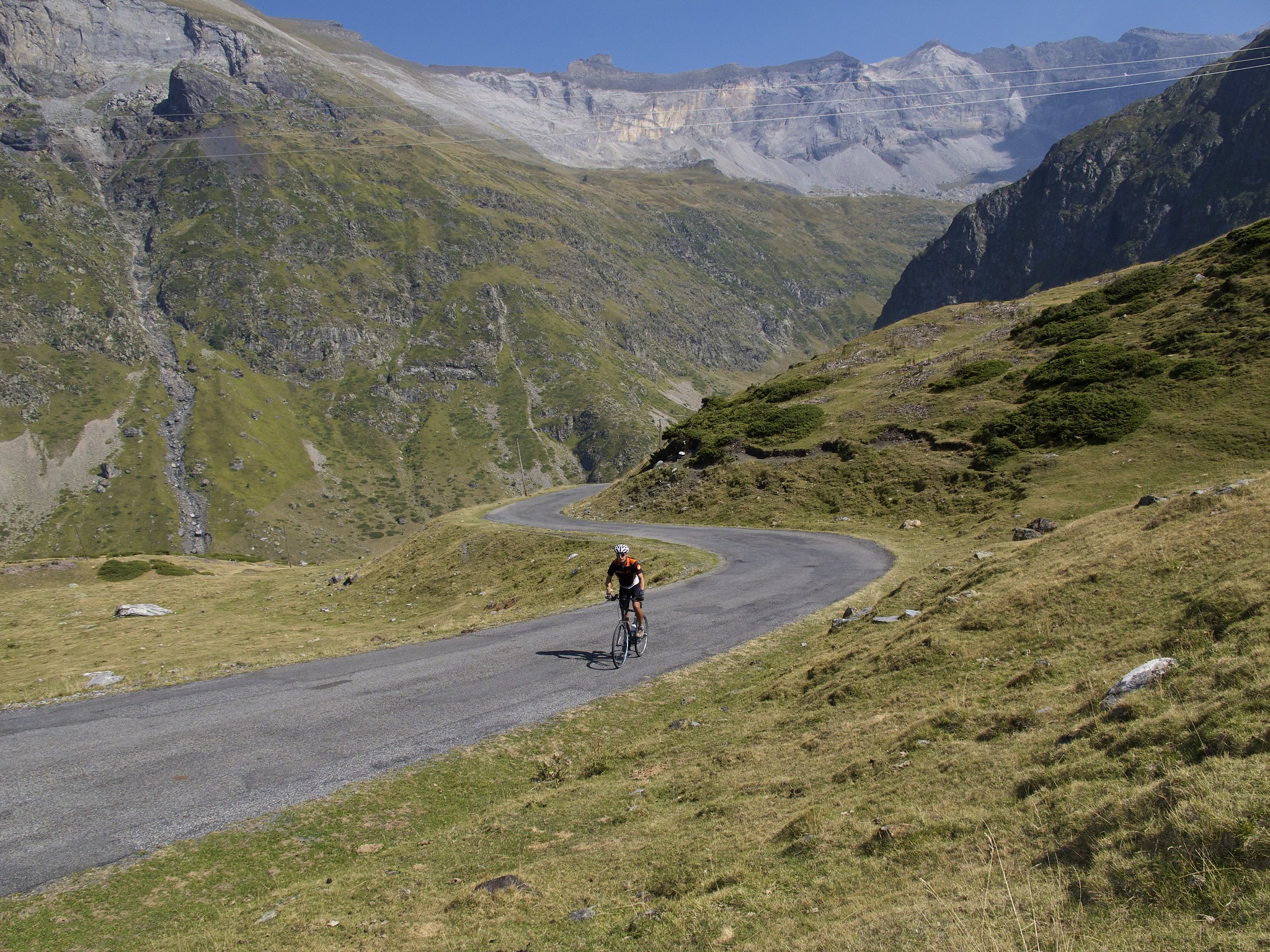
Cirque de Troumouse is a cow climb:

Final Thoughts
Hopefully, I have given a useful overview of the 6 mountain stages. I apologise for offering no insight as to which riders will enjoy these stages. I have no idea. But I have faith in you that you can use the comments to discuss,
Hmm, apparently I can no longer add polls. So please also use the comments to vote on which stage is the queen stage. I think there are only three possibilities. Either of the Galibier stages or the final Hautacam stage.
I hope you aren't angry with me but instead now proud experts of which animal belongs to the various Pyrénées climbs. So as a final note: not only is Col des Tentes a cow climb, the cow second from left is giving birth.
Thanks for reading,

More from Podium Cafe
- Will Sagan Be Dancing In France?
- At the Edge, by Danny MacAskill
- Richie Porte - Tour de France Favourite?
- Help Patrick Lefevre Spend His Money!
- Underreacting to the Critérium du Dauphiné
- Tour de Suisse Preview
- Knowing the Score, by David Papineau
Recent FanPosts
- PG - Giro d'Italia 2024 - Stage 2
- PG - Giro d'Italia 2024 - Stage 1
- Eschborn-Frankfurt Live Thread
- Packing for the Giro d'Italia 2024
- PG Spring Classics - Liège - Bastogne - Liège - General George S. Patton Edition
- PG Spring Classics - Flèche Wallonne - Too Busy Edition Edition
- PG Spring Classics - Amstel Gold Race - MvdP Edition
- LIVE thread - Besançon Doubs - Jura - Doubs
- PG Classics - Amstel Gold Race 2024
- Why Didn't You Just Drive Him Right Off The Road?
Loading comments...
Trending discussions.
- Giro d’Italia Stage 1: Narváez Overcomes Pogačar Aggression for Opening Victory
- Classics Wrap: What’s In a Record?
- La Vuelta Femenina LIVE

Pogačar Starts With All-Time Great Puncheur Effort | Giro d’Italia Stage 1 2024
- Race Recaps

Ivan Basso And The Most Dominant Grand Tour Of All Time: Il Giro d’Italia 2006.
- Uncategorized

Muzic Survives Vollering’s Fierce Tempo | La Vuelta Femenina 2024 Stage 6

Vollering’s Incredible Performance on Fuerte Rapitan | La Vuelta Femenina Stage 5 2024
- wout van aert
- WorldTour Ranking
- WorldTour Calendar
- world tour relegation
- women cycling power
- watts analysis
- warren barguil
The Ultimate Guide to the Tour de France 2022 King of the Mountains Competition

The mountains classification is always a great attraction of the Tour de France, especially when the fight for the general classification is not entertaining or exciting deep into the race. In this article, we will take a closer look at 2022 edition’s scoring system, the tactics for winning it and who are the favourites.
This year’s route is quite mountainous, with mythical passes such as Galibier, Alpe d’Huez or Hautacam. In this article , we analysed all these climbs featuring in the 2022 Tour de France, including projected climbing times and watts. In total, there will be:
- 61 categorised climbs;
- 7 Hors Catégorie climbs;
- 10 category 1 climbs;
- 6 category 2 climbs;
- 16 category 3 climbs; and
- 22 category 4 climbs,
for 985 available points.
Logically, the Hors Catégorie climbs are the most important, with a big difference over the rest. Not only does the first rider score twice as much as a first category climb, but there are points up to the eighth position, as you can see in the following graph.

Moreover, according to the rules, “in the event of two riders being equal on points in the best climber classification, the rider with the most first places at the summit of Hors Catégorie passes or climbs or summit finishes will be declared the winner”.
If a rider’s goal is the final mountain classification, there is little point in expending valuable energy racing for the points available on Category 3 or 4 climbs, and instead they should focus on the Hors Catégorie and Category 1 climbs. In any case, modest teams will compete for the points on these small hills in the first week to wear the jersey until the arrival of the high mountains and thus maximise their visibility and publicity impact on the race, as was the case last year when Perez and Schelling battled throughout the Grand Depart on the short hills in Brittany last year.
In addition, although they have almost no impact on the classification, topping a fourth category climb is rewarded with 200 euros, which is welcome among the cyclists with lower salaries.

As we can see in the graph, the Hors Catégorie and Category 1 climbs share 86% of the total points for the mountain classification. Five of the seven Hors Catégorie are in the two big Alpine stages, with finishes at Col du Granon and Alpe d’Huez. Those two stages will be key, as if a rider passes all the climbs first he can score 55 and 60 points respectively. However even in the event of the GC group eventually catching the breakaway on the four major climbing stages (11, 12, 17 and 18), four of the seven Hors Catégorie climbs are during the middle of the stage where it is much more likely that a breakaway will still be up the road to take maximum points.
Below you can see the exact distribution of points on each stage, with the heavy weighting in the Alps and Pyrenees.

As the key stages come in the first block of mountain stages, it is possible that many good climbers will not have given up on the general classification and will find it difficult to get into the breakaway. Therefore, contenders for the mountain classification who are not thinking about the general classification will have a competitive advantage, and may even score some points on stage 9, with two first category mountain passes, where a breakaway is expected to win. In these Alpine stages, the mountains jersey could also be a good target for riders who drop out of the general classification in the traps of the first week, such as the windy stages, the pavé or the finish at La Planche des Belles Filles.
It is clear that riders with ambitions for the KOM should not leave their homework for the Pyrenees, because the classification is likely to be very clear after Alpe d’Huez on stage 12 and with the GC group likely to be motivated on stage 18 to pace on Spandelles and Hautacam, reducing the likelihood of a breakaway winnig.
An anti-Pogacar system
Unlike in recent editions, this year there will be no climbs with double points, which will favour the KOM to be won by a climber who enters the breakaways in the high mountain stages. The sponsor of the mountains classification is probably interested in having its jersey worn by one of the best riders in the world, but last year’s scoring system was very distorting. In the last two editions of the Tour de France, Tadej Pogacar has won the KOM classification without it being a main objective for him, as he was busy fighting for the yellow jersey.

For example, last year there were double points for the second pass of Mont Ventoux and the finishes of Col du Portet and Luz Ardiden. These passes were already categorised as Hors Catégorie, but the organisers decided that they would distribute twice as many points as the other Hors Catégorie climbs (40 points for the first rider instead of 20). Poels, Woods and Quintana were fighting for several stages in this classification, but finally Pogacar won it “unintentionally” by winning in the Pyrenees on Col du Portet and Luz Ardiden, scoring 40 points on each climb. With the current scoring system, Wout Poels would have won the mountains classification in 2021 and Richard Carapaz in 2020, so it will be very difficult for Pogacar to repeat in 2022, particularly if he faces stiffer competition from his GC competitors on the mountain top finishes compared to last year.
The contenders
Pogacar (or whoever is the best climber in the race) will concentrate most of his points on the top finishes: La Planche des Belles Filles, Col du Granon, Alpe d’Huez, Peyragudes and Hautacam. In the best case scenario, assuming he wins those 5 stages, he would score 80 points, which might not even be enough to win the mountains classification given the amount of Hors Catégorie and Category 1 passes in the middle of the stages. Therefore, the chances of Pogacar winning the mountains classification for the third year in a row are very low.
The two riders who can set their sights on the mountains classification right from the start are local stars Thibaut Pinot and Romain Bardet (KOM at the 2019 Tour). Neither of them have the general classification as a target and they do have enough level to get over the big Alpine passes at the head of the race as shown by Pinot in his recent Tour de Suisse stage win and Bardet on Blockhaus in the Giro d’Italia.

Other French climbers like Warren Barguil (KOM at the 2017 Tour), Guillaume Martin (KOM at the 2020 Vuelta) or Pierre Rolland always go on the attack, but perhaps they lack the climbing level to win the Tour’s mountains classification if riders like Pinot and Bardet focus on the classification. After his display on Mont Ventoux and the Dauphiné, we also cannot forget Ruben Guerreiro (KOM at the Giro 2020), who in principle comes to the Tour with the objective of winning stages but may inadvertently pick up points by being in breakaways and fall into the KOM fight.
The final tier of favourites is made up of the general classification contenders who will change their objective after the complicated first week. Nairo Quintana and Michael Woods already tried in 2021 and could rethink this objective, but my outsider is Adam Yates. The Englishman comes to the Tour after passing Covid and it would be logical for him to suffer in the chaotic first week filled with wind and cobbles. With Thomas and Martínez for the general classification, Ineos could think about Adam Yates for the mountains classification and breakaway stages in the mountains, racing the Tour in a more offensive way without an outright GC favourite.
We hope you enjoyed this breakdown of the King of the Mountains classification at the Tour de France 2022. If you want to follow Raúl’s thoughts during the Tour, follow him on twitter @raulbanqueri .
What about Ruben Guerreiro? I see him as an outsider to the jersey as well after his performances the last month or so
Great read, thanks. Some time ago, with friends we were talking about this same issue, that KOM competition has kind of lost it’s identity and GC winner takes KOM as well. Would love to see a return of full on battle for polka dot jersey once again.
I may have jumped the gun on that one
Literally in the article: “After his display on Mont Ventoux and the Dauphiné, we also cannot forget Ruben Guerreiro (KOM at the Giro 2020), who in principle comes to the Tour with the objective of winning stages but may inadvertently pick up points by being in breakaways and fall into the KOM fight.”
Wonderful article. Really detailed and helpful to understand the differences between previous editions
Great article and that pie chart works wonders – why the hell doesn’t ASO present the points available like that! Thank you.
another stunning work. thanks Raül.
Best assessment I’ve read. Even as we enter stage 18 tomorrow this analysis still holds up. Thank you for making the KOM competition so much more clear and so much more interesting!
Leave a Reply Cancel reply
Your email address will not be published. Required fields are marked *
Save my name, email, and website in this browser for the next time I comment.
Notify me of new posts by email.
La Vuelta España Femenina
Giro d'italia, lagrange cycling classic, uci mtb fort william, tro bro leon (coupe de france), spin the district: college park, tour de hongrie, circuit de wallonie (exterioo cycling c, uci bmx freestyle wcup - fise, 4 jours de dunkerque, vuelta a burgos féminas, veenendaal classic (exterioo cycling cup, uci mtb bielsko bialia poland, uci bmx racing world championships, usa cycling pro road nationals, everything you need to know about the climbs of the 2022 tour de france, the most iconic climb in cycling, the alpe d'huez will be featured in this year's tour de france, but that's not the only climb to look forward to..
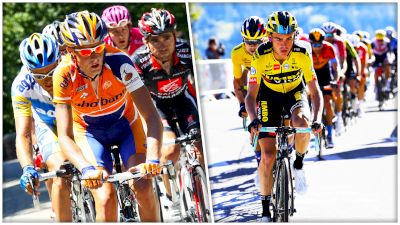
The mountains return to the forefront during the 109th edition of the Tour de France, celebrating its grand départ on Friday, July 1st. The 176 riders taking the starting line will face six mountain stages, with 5 summit finishes throughout the 3,329 km trek around France. FloBikes break each mountain stage down, looking at the historic battles fought and the expectations of what is to come.
Stage 7: Tomblaine – La Super Planche Des Belles Filles, 176 KM
After its debut in 2012, Tomblaine will be welcoming the Tour for the third time as the riders embark to reach the first summit finish of the 2022 Tour. The first half of the stage is relatively flat, allowing the legs to warm up and recover from the first week of racing. The first categorized climb occurs after the one and only intermediate sprint of the day. They hit the 3.1km Col de Grosse Pierre soon after, a category 3 climb that reaches 955m in altitude and peaks at 6.4% gradient.
Following a quick descent and a few bumps along the way, the next climb is another category 3. The 3.2 km climb peaks near the same gradient at 6.3%. These two climbs will act as a warm up for the final 7 kilometer-long climb of La Super Planche Des Belles Filles.
This summit finish, nicknamed, “the little Alpe d’Huez,” was made famous in 2020, when Tadej Pogačar overturned the GC lead in a dramatic time trial battle against Primoz Roglič. He would go on to celebrate becoming the youngest champion to ever win the yellow jersey in Paris. Other notable riders in the peloton will be Thibaut Pinot, who calls the town home and Chris Froome, remembering when he celebrated his first Tour stage win here in 2012, one year before his first overall victory.
The 8.7% gradient climb is not expected to create much gaps this time around, but rather show racing fans who are in form and prepared to tackle the big feats ahead.
Stage 9: Aigle – Châtel Les Portes Du Soleil, 192.9 KM
After a brief respite on stage 8, the mountains will call once again, for the first major test of the mountain goats in the peloton. After starting in Aigle, the capital of cycling where the UCI calls home, the course will begin its upward trajectory with a category 4 climb. Following an intermediate sprint, allowing the fast men some points before establishing the grupetto, the climbing continues on the category 2, 13.3km Col des Mosses. Following a quick dipping descent, it is back up again, this time for 8.1km Col de la Croix, a category 1 mountain.
If the first two climbs hadn't shocked the legs enough, the Tour organizers threw in one last category 1 about 10km before the finish – the 15.4km Pas de Morgins at 1,377m in altitude. The Tour first stopped here in 1975, when Lucien Van Impe won the stage wearing the mountains jersey. The finish would become widely known after numerous appearances in cycling from the Critérium du Dauphiné, to the Tour de Romandie and the Tour de l’Avenir.
Stage 11: Albertville – Col Du Granon Serre Cheva, 152 KM
The GC contenders will need to be ready to focus after the first rest day and rolling hills in stage 10. Stage 11 will hit them again and again with three cols that are tightly packed as they enter the Alps. The day will get started with the Montvernier switchbacks. If Geraint Thomas has maintained the form he displayed recently at the Tour de Suisse, all eyes will be upon him. Albertville is where Thomas took the yellow jersey back in 2018 and held it through to Paris.
The summit finish atop Col du Granon held the grand esteem of being the highest point in the Tour for 25 years before the title was taken by the Galibier in 2011. It made its debut in 1986, when Eduardo Chozas soared to victory after an astonishing 170 km solo breakaway. That same finish marked the end of the yellow jersey reign of Bernard Hinault, when he surrendered his 79th maillot jaune to American Greg Lemond.
This first major test in the Alps will determine if Pogačar is ready to defend for a record third time in hopes of joining the legends - Louison Bobet, Jacques Anquetil, and the Cannibal himself, Eddy Merckx - in winning 3 consecutive Tours.
Stage 12: Briançon – Alpe d’Huez, 165.5 KM
A historic favorite is set for stage 12 as the battle in the Alps comes to a close on the infamous Alpe d’Huez. The route is an exact replica of the stage in 1986. Racing fans should expect to see a lot of trainers out and riders warming up before the start of this stage. The grand Col du Galibier awaits them only 33 km into the stage. After a fast and technical descent, the Col de la Croix de Fer will be up next before the crowds and Dutch corner explode with excitement, willing each rider up the 21 switchbacks with their screams of “Allez!!” at every turn.
This will be the 31st appearance by the Alpe d’Huez, 70 years after summit finishes were first introduced. Both Pierre Rolland and Thibaut Pinot have enjoyed victories here for the host nation. Time will tell who will be next to add their name to the history book atop this legendary mountain.
Stage 17: Saint-Gaudens – Peyragudes, 130 KM
Tour de France Race Director, Christian Prudhomme, says this penultimate climbing stage will be the third runway to success in the 2022 Tour. The start in Saint-Gaudens has a dramatic history, from Gino Bartoli’s protest that triggered a feud between France and Italy, to the multiple riders who have stolen the maillot jaune. Tour leaders will have to put on their best poker face if they hope to defend their positions.
The first of 3 category 1 climbs launches midway into the stage in the heart of the Pyrenees. The last time the Tour finished here was in 2017, when Romain Bardet (now racing for Team DSM) emerged solo on the steep run-in to the finish, ahead of Italian Fabio Aru, and Colombian star, Rigoberto Uran. Alejandro Valverde was the first victor here in 2012. While the Tour has passed through Peyragudes dozens of times, 2022 will be only the third time they will host a stage finish.

Stage 18: Lourdes – Hautacam, 143 KM
This final test in the mountains of the Pyrenees, will give no respite for the weary. No matter what the gaps are between the leaders, expect fireworks on the stage. Organizers were able to link the first Hors Catégorie Col d’Aubisque with the Col de Spandelles for the first time in Tour history, with not a moment to breathe in between the two.
The final Hautacam ascent was where Cadel Evans’ made his move in 2008, stealing the lead by a mere second from Frank Schleck. Vincenzo Nibali took his fourth stage victory here in 2014 and the yellow jersey before celebrating on the Champs-Elysées. Racing fans will miss him as he is set to retire at the end of the season.
The final stage in the Pyrenees should not disappoint, whether it is Tadej Pogačar fighting for a hat trick or coming from behind Primoz Roglič or an upset by Michael Woods or Geraint Thomas. The riders will surely put on a spectacular show as the curtain closes on the 2022 battle in the mountains.
Related Content
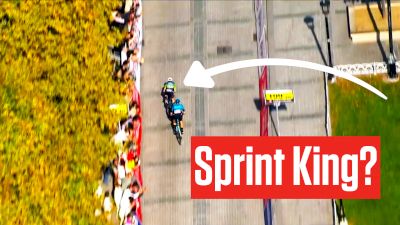
Oct 15, 2023
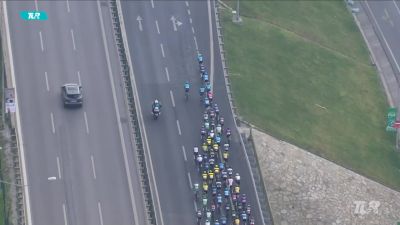
Oct 14, 2023
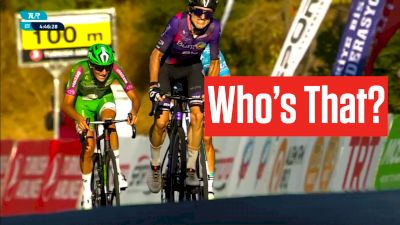
Oct 13, 2023
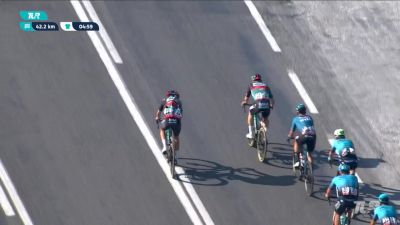
Oct 12, 2023
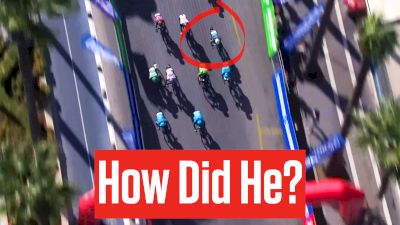
Oct 11, 2023

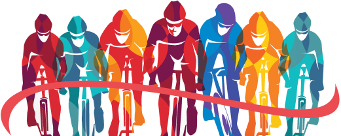
Tour de France 2019 Stages and Elevation
It has been quite a while since the last analysis and by now we are more than half way the Tour de France 2019. One of the most interesting Tour in years if you ask me. Julian Alaphilippe in yellow, no truly dominant team and many surprising stages. The past four stages took place in the Pyrenees. In this post we will take a look at the past mountain stages and their relative difficulties. For this we use Strava data from Thibaut Pinot and Sébastien Reichenbach.
Don’t forget to check out our Tour de France race page with a lot of race statistics
The first problem that we encounter is that the actual stage data from Strava does not include the Tour de France climb categorizations. All climb information is collected from the official Tour de France website. However, it appears that the climb location (kilometers since the start/beginning) does not really match with the Strava information. This is actually solved by manually aligning the official Tour de France profiles with the Strava profile that results from combining the gradient adjusted distance and elevation information. When aligning we always stuck to the official climb length from the Tour website. You can see the result of this exercise in Figure 1 . In this figure you can see the Stava profile in black and the categorized climbs as shaded yellow regions. In the subplot title you can also find the Tour stage label. Here FLA, HIL and MNT indicate, respectively, a flat, hilly and mountain stage. The abbreviations ITT and TTT are the Individual and Team Time Trials.

Figure 1: Tour de France 2019 profiles based on Thibaut Pinot and Sébastien Reichenbach Strava rides aligned with official Tour de France profiles.
As you can see stage 2 and stage 13 have no categorized climbs, since these were (team) time trials. Sometimes the alignment just took a few hundred meters, in other stages it was more than a few kilometers. When aligning we really tried to capture the most elevation within the official climb length. Note that the axis on all figures are different, so elevation differences between e.g. stage 1 and stage 1 are very substantial. Now we have the actual race elevation and categorized climb elevation aligned we can calculate stage-by-stage the total elevation and the part of this total elevation that is actually categorized. This is shown in Figure 2 .
The first noteworthy observations is that flat stages are definitely not that flat at all. The ‘flattest’ stages (stages 1, 4 and 11) still have close to 2000 meters of total elevation. Stages 7 and 10 are also classified as flat, but contain more elevation than some hilly stages. The only difference is that the categorized elevation is of a lower category. The same holds for the hilly stages. Take for example stage 8 - hilly according to the Tour de France organization. With nearly 4000 meters of total elevation it is comparable with mountain stages 6 and 15. The only difference is that this elevation is of a lower category.
This leaves us with the mountain stages 6, 12, 14 and 15. The first thing that distinguishes them is the percentage of climbing meters that is classified with category 1 or ‘H’. The second important aspect is stage length. In Figure 3 is identical to Figure 2 , except that we scaled total stage elevation by the stage length. So on the vertical axis you now see total elevation in meters per stage kilometer. Now the mountain stages really stand out. They pack a lot of climbing intensity in relatively few kilometers.
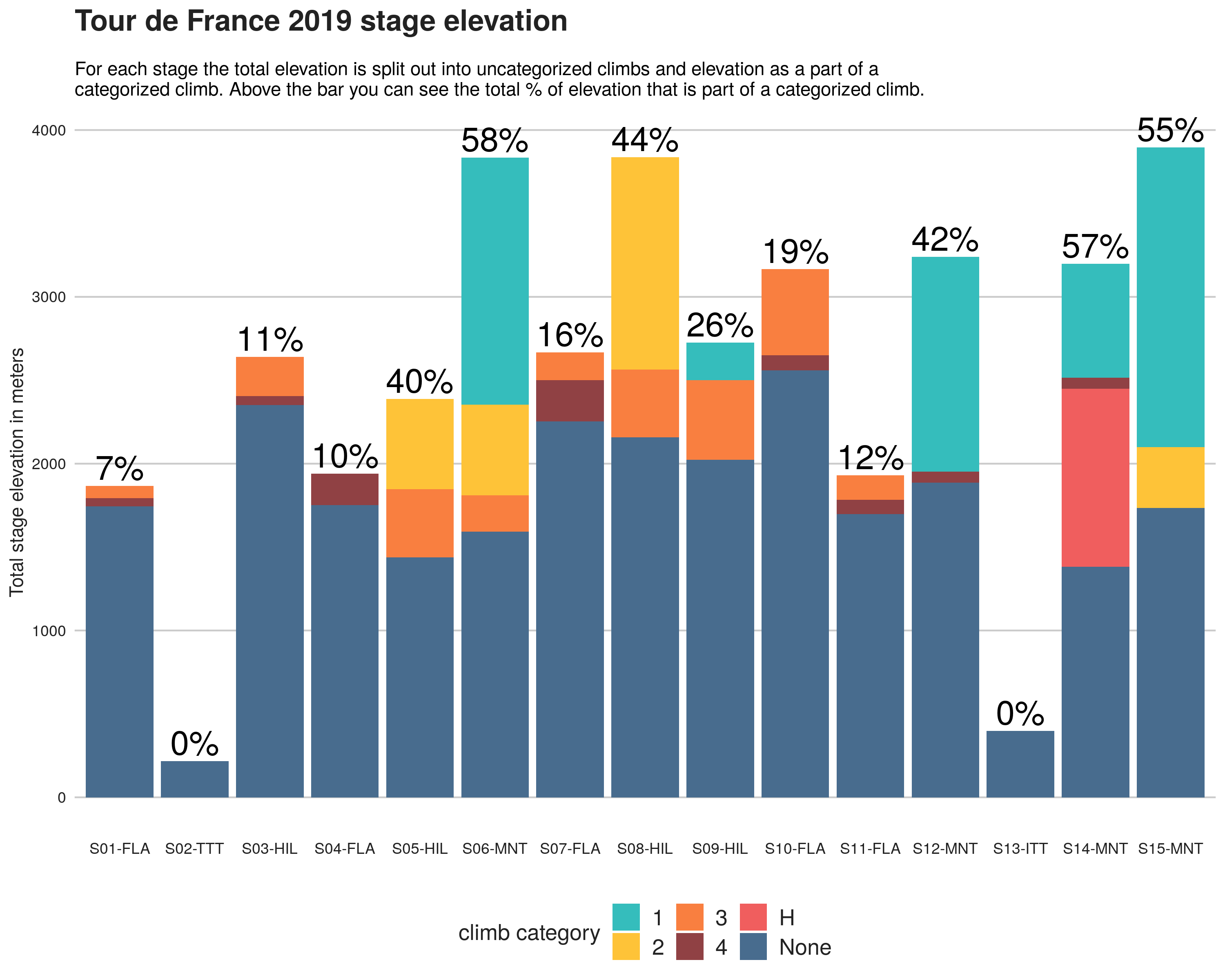
Figure 2: Tour de France 2019 total actual stage elevation based on Thibaut Pinot and Sébastien Reichenbach Strava rides split out for uncategorized and categorized climbing meters.
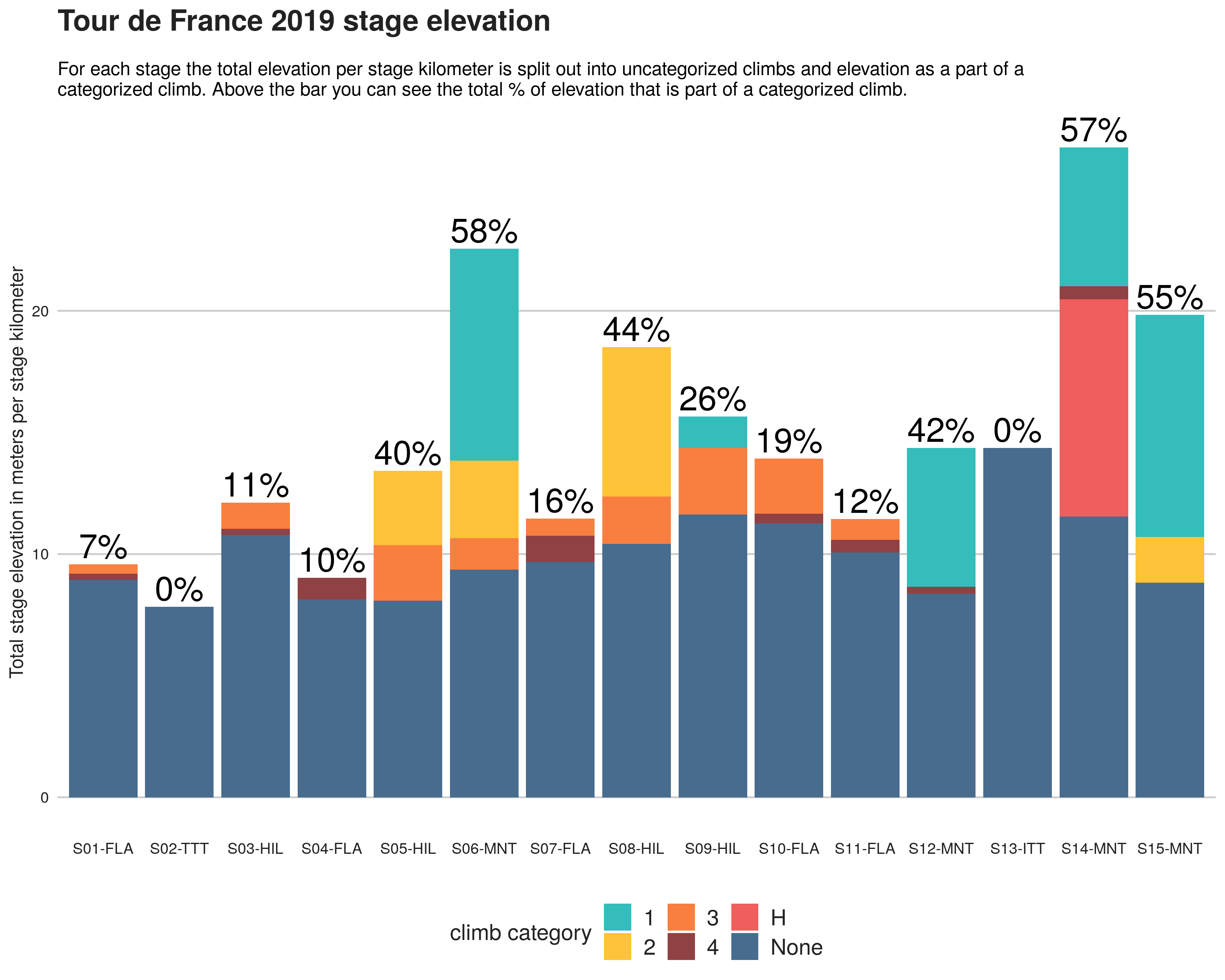
Figure 3: Tour de France 2019 total actual stage elevation per stage kilometer based on Thibaut Pinot and Sébastien Reichenbach Strava rides split out for uncategorized and categorized climbing meters.
The last thing we will take a look at is the total cumulative elevation over the Tour de France until now. This is shown in Figure 4 . In this figure you can see the total Tour de France distance covered on the horizontal axis and the cumulative total elevation on the vertical axis. The odd stage numbers are shaded yellow to increase the readability of the figure. So far the Tour de France had about 40 kilometers of climbing up to and including stage 15! You can also see that:
- Some stages start off with quite some elevation in the beginning, afterwards it flattens off. Take for example the flat stages 4, 7 and 10.
- Although stage 6 and 8 are packed with climbs and tough you see that in the Pyrenees (stages 12 up to 15) climb length increased and, consequently, climb categories got heavier.
- The slope of the line increased in the Pyrenees, this means more vertical meters per stage kilometer.
Stay tuned for the next post about the Tour de France mountains / polka dot classification.
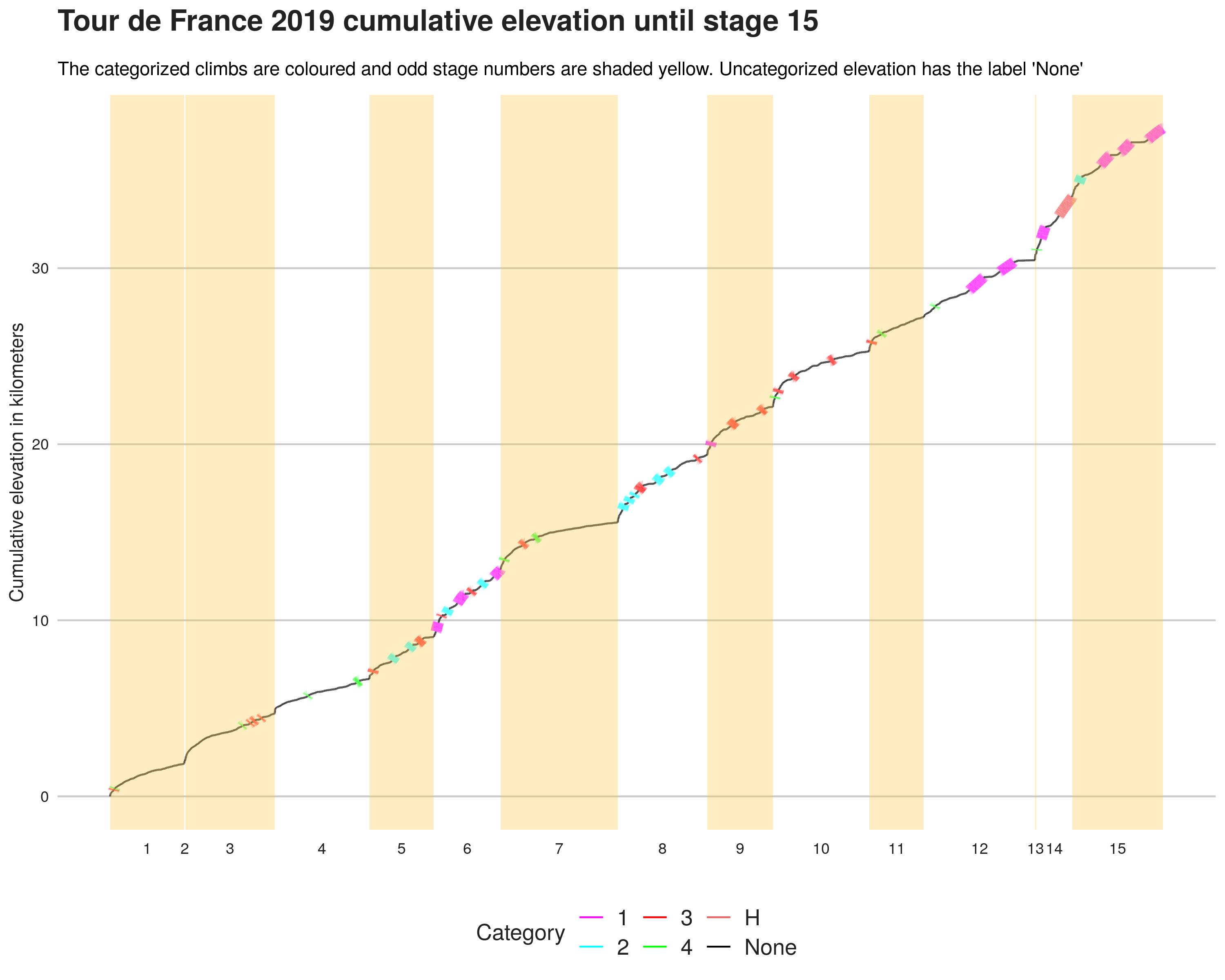
Figure 4: Tour de France 2019 cumulative elevation over all stages until now based on Thibaut Pinot and Sébastien Reichenbach Strava rides.

- Login or Register

How Are Those Mountain Climbs Classified In The Tour de France
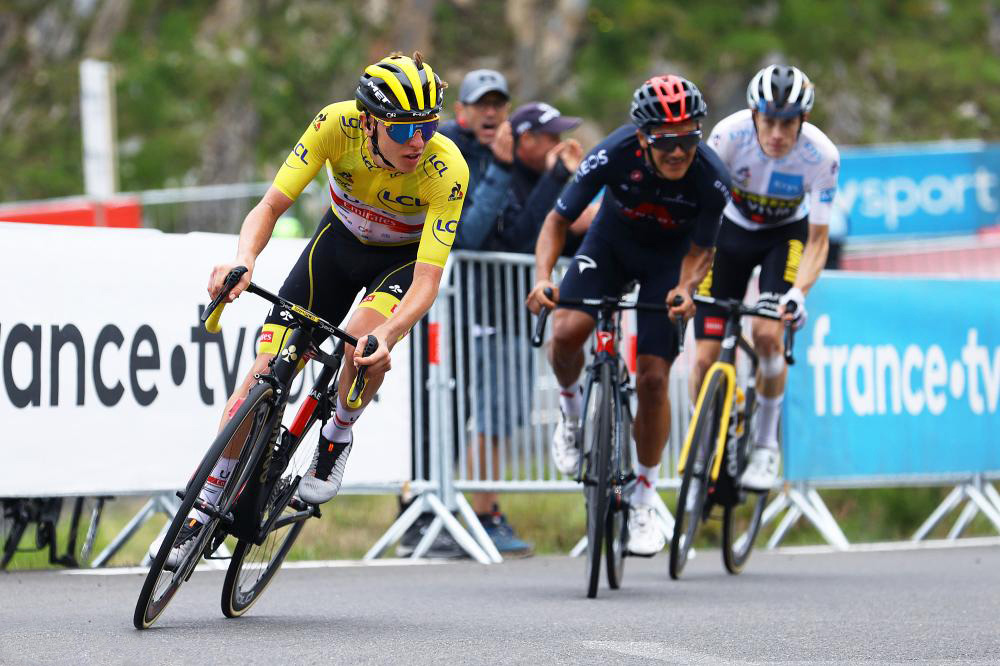
In this year’s Tour de France, in the eighth stage, Because Bogacha turned on the violent mode, and in the final climbing stage, he directly exceeded 17 people. Although not the segment champion, but still beat all opponents, the overall result rank first, he put on the yellow jersey as he wishes, the powerful output of the entire process absolutely absorbs countless fans.

The stage is the first alpine stage of this tour de France, the riders will pass one category 3 climb, one category 4 climb and three category 1 climbs for a total of 150.8km. It is a combination of different climbing stages. So how is the classification of climb divided in the tour of France and how did it come about ? Let me show you now.
It is said that in the early stage of last century, cars were not as powerful as they are today, if a hill can be climbed by a 35-horsepower car in 4th gear,it is called grade 4 climb. A hill that can be climbed in 3rd gear, it is called grade 3 climb, so on and so forth to grade 1. If it is a hill that a car can not climb, it is grade HC. Believe it or not, this statement indicates the difficulty of the relevant climbing levels. So how are these climbing classes classified today?
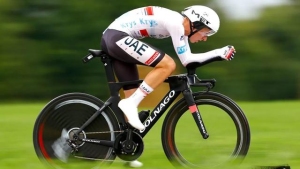
At the first Tour de France in 1933, there was only one class for the hilltop finish, with 10 points awarded to the first person to pass. After World War Two in 1947, there were two classes for the hill top finish, with the first and second finishers receiving 10 and 5 points each. In 1962, the difficulty of climbing was divided into 4 levels.The four levels climbing category could not meet the requirements of the event and the level HC(Hors Categorie) came into being and was added to the tour de France climbing level division.

How to classify the climbing levels.
In fact, the current tour de France climbing grade is based on the height of the mountain, climbing distance, the average slope and other factors to divide into 5 grades, respectively 4, 3, 2, 1 and HC level, the difficulty of grade 4 is the easiest, the smaller the number, the higher the difficulty,HC level is the highest and most difficult level.
Grade HC is short for French”Hors Categorie”, it is a term used in cycling, refer in particular to the climbing of beyond the level. HC was used to refer to the mountain road that car can not pass, we can see the difficulty of climbing and steepness from the literal meaning.
Slope calculation formula of tour de France
((Average slope (%))^(3/2)* Altitude climb (m))/100
20 < grade 3 ≦50
50 < grade 2 ≦120
120 < grade 1 ≦200
Grade HC > 200
Calculate with an average slope of 5% and a total climb of 1200 meters above sea level, which is:5^(3/2)*1200/100=134. 134 is between 120 and 200, it belongs to grade 1, then we can conclude that the difficulty rating of the climb is grade 1.
Climbing points
Grade HC: 25-20-16-14-12-8-6-4-2-1 points.
Grade 1: 10-8-6-4-2-1 points
Grade 2: 5-3-2-1 points
Grade 3: 2-1 points
Grade 4: 1 pint.
The first rider to pass the hill gets the highest points, and the remaining riders who pass the hill get the remaining points. The rider with the highest total climbing points over the 21 stages of the Tour de France will wear the King of Climbs polka dot shirt.
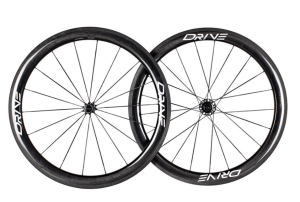
The new series Drive 50V of Elitewheels use carbon spoke, weighing only 1367g. It provides better aerodynamics and excellent stability, giving you the edge in full sprint and powerful climb. If you are preparing for the championship, this will be the best helper. Maybe we’ll see you in the Tour de France next year.
Check out Drive 50V here.
Leave a comment Cancel reply
Save my name, email, and website in this browser for the next time I comment.
Sign up for special offers!
You May Also Like
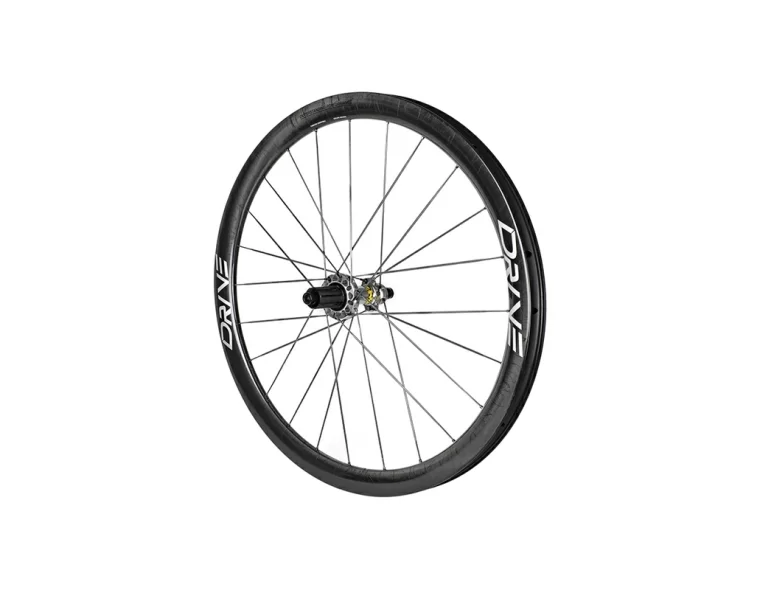
Why 2:1 Lacing pattern? 2:1 triple lacing pattern DRIVE carbon spoke Elitewheels various benefits and advantages.
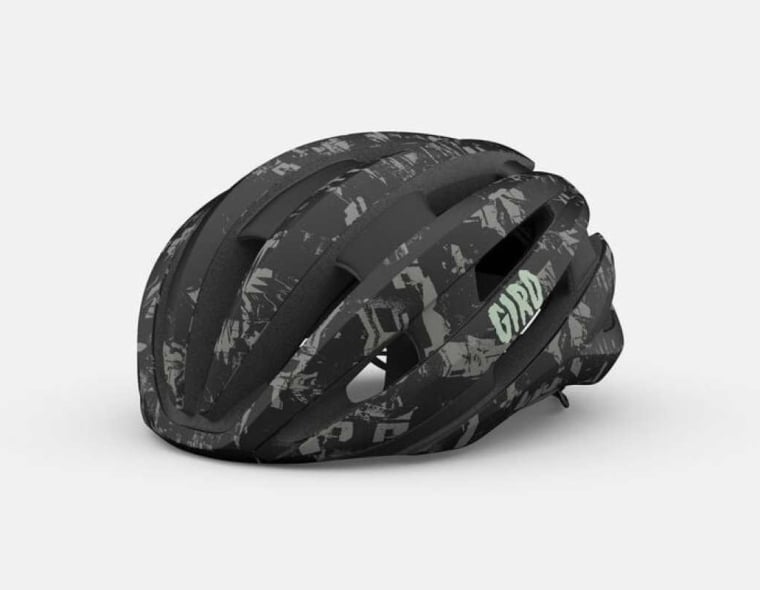
The Top 5 Road Bike Helmets of 2023
Home Explore France Official Tourism Board Website
- Explore the map
Tour de France 2023: our selection of the most beautiful mountain stages
Inspiration
Cycling Tourism Nature and Outdoor Activities Sporting Activities Mountains

Reading time: 0 min Published on 4 December 2023, updated on 15 April 2024
The most famous cycle race in the world, the Tour de France will be taking to the skies once again this year, as the 3,404km and 21 stages will take in all 5 of France's mountain ranges! The Pyrenees, the Auvergne volcanoes, the Jura mountains, the Alps and the Vosges massif... The peloton has plenty of pedalling to do and plenty of climbing to do. The grandiose landscapes, the high altitude finishes and the dizzying descents promise to be emotional highs. To experience the highs (and lows) of the Grand Loop, saddle up with our selection of the most beautiful mountain stages.
From Tarbes to Cauterets-Cambasque, the Pyrenees take centre stage

After 3 stages on the Spanish side, welcome to the French Pyrenees! First there's Bayonne and the Basque country, Dax and its thermal baths, Pau and its beautiful castle where King Henry IV was born. And then there's Tarbes, with its breathtaking views of the surrounding mountains, its palm-lined streets (yes, yes!) and its gourmet markets. The riders of the 2023 Tour de France will need a lot of courage to tear themselves away from this gentle way of life and tackle the climbs of the Aspin and terrible Tourmalet cols . The reward for all this climbing is a finish on the Cambasque plateau, overlooking the charming resort of Cauterets, in the heart of the Pyrenees National Park, where the Pic du Midi is enthroned. Want to cool off? Try the hike to the peaceful Lac d'Ilhéou . In a green setting with magnificent views and waterfalls, picnics and swimming...
The Puy de Dôme, a feast for the eyes in Auvergne

The ascent of Puy de Dôme, the undisputed star of the Auvergne, will be one of the highlights of the 2023 Tour de France! The youngest and highest volcano in the Puys chain has not featured on the itinerary for 35 years. Taking on this fearsome and majestic peak and finishing with a 360° view over the gentle rolling hills of the Parc naturel régional des Volcans d'Auvergne is sure to motivate many a rider! But did you know that you can also climb this peaceful giant by mule track or on board the Panoramique des Dômes, a picturesque little cogwheel train? In just 15 minutes, you'll be transported to an altitude of 1,465 m, with the 80 volcanoes of the Puy range and the Limagne fault (listed as a UNESCO World Heritage site at your feet. To complete a stage that's full of fireworks, the Vulcania Park is not far away! Who can beat that?
Breathtaking escapes in the Jura

Expect to fall under the spell of Châtillon-sur-Chalaronne! Just 1 hour from Lyon and the Monts du Beaujolais, this small town in the Ain département, from which the Tour de France 2023 peloton will set off on 14 July, is a delightful medieval town. With its pink stone houses, flower-bedecked bridges and old market hall housing one of France's most popular traditional markets, it is also the gateway to the Dombes region, a paradise for fish farmers and birdwatchers with its landscapes of water and ponds. Take advantage of this area on foot, by boat or, ideally, by bike (it's flat!), before taking to the heights of the Montagnes du Jura , just a stone's throw away. The Pyramide du Bugey, from the top of which you can see Mont Blanc and Lake Geneva, is a must-see. The Tour de France riders attack it via the Col du Grand Colombier. At top speed. Take your time, the panorama is well worth it!
In the Alps, between lakes and legendary passes

It's doubtful that the riders will enjoy the view of Lake Geneva as they take their first pedal to the metal in the Alps at Annemasse on stage 14 of the Tour de France 2023. We recommend this one, though, as well as the view of Lake Annecy and its turquoise waters. Then it's time for a series of twists and turns and climbs to the legendary passes of the Alps, including the famous Col du Feu, an unprecedented climb for the peloton. At an altitude of 1,000 metres, in the heart of the Portes du Soleil ski area, the stage finish in Morzine won't dampen the spirits of those who love nature. In summer, the little village resort in the Alps is an ideal playground for lovers of outdoor activities : a stroll along the Dérêches river, swimming in Lake Montriond, canyoning or via ferrata... the hardest thing will be to choose.
From Gets to Saint-Gervais, Mont Blanc in your sights

For the first time since its creation, the Tour de France will start from Les Gets. Well-known to mountain bikers (the World Championships were held there in 2022), the pretty Alpine resort will kick off a 15th stage during which you'll need to have plenty of breath. The Col de la Forclaz-Montmin is on the programme. So allow yourself a break at its belvedere for a bird's-eye view of Lake Annecy before setting off again for Saint-Gervais, at the foot of Mont-Blanc. If you want to reach the highest peak in the Alps, this village resort, with its well-preserved heritage and traditions, is the ideal place to stop. And its thermal baths, renowned for the many benefits of their waters, set the well-being at the summit in a magnificent green setting.
Courchevel, star of the Alps

The regulars call it Courch' and they come and go summer and winter as connoisseurs, just like the Tour de France caravan which is visiting the Savoyard resort for the 4th time. Welcome to the pinnacle of top-of-the-range skiing in the Alps, at the heart of the Three Valleys ski area. Courchevel tops the list not only for the size of its ski area (Méribel and Val Thorens are its famous neighbours) but also for its range of hotels (no fewer than 5 mountain palaces , from the Apogée to the Cheval Blanc, not forgetting the K2 Palace, Airelles and the Hôtel Barrière Les Neiges) and restaurants. So, with its 6 hamlets and the surrounding area, the resort has a lot to offer. Take a selfie at the top of La Saulire, take a stroll down to Lac de la Rosière, cycle down the Bike Park, spend the night in the Lacs Merlet refuge or hike through the heart of the Vallée des Avals... You're going to love it!
Full steam ahead in the Vosges

Between the Lorraine plateau and the Alsace plain, the Vosges massif lives up to its reputation: a perfect blend of nature, wide open spaces, traditions and local produce, crafts and fine cheeses. Between the Grand Ballon d'Alsace and the Petit Ballon, via the famous Col de la Schlucht, the Tour de France 2023 will be taking a break from the normality of the mountains, with a new finish on the slopes of the Markstein, in the welcoming family resort of Marlstein Fellering. In the heart of the Ballons des Vosges Regional Nature Park , you can enjoy bucolic hikes, tobogganing in the mountain pastures, paragliding with a view, and mountain biking (or mountain bikes) in a landscape of absolute serenity. And for those with a sweet tooth, July is the peak of blueberry season (and the season for tarts in the farm inns).
And (finally) Paris.... and the Olympics!

Will the riders be in Olympic form for the triumphant finish on the Champs-Elysées on 23 July 2023? Just one year ahead of the 2024 Olympics in Paris , the route will certainly provide a magnificent prologue to the sporting event. Starting in Saint-Quentin en Yvelines, all the future Olympic venues in the Yvelines département will be on the peloton's final route. A gigantic loop will join the Colline d'Elancourt (where the mountain bike events will take place), the Golf National in Guyancourt and the Château de Versailles , which will host the equestrian events and part of the modern pentathlon competitions. A prestigious line-up of finishers for a Tour de France 2023 that's sure to be at the top of its game!
Find out more:
More information on the route of the Tour de France 2023 and nearby tourist attractions
5 minutes to find out all about the Tour de France 9 mountain skills to discover

By Rédaction France.fr
The magazine of the destination unravels an unexpected France that revisits tradition and cultivates creativity. A France far beyond what you can imagine…
Un bain de forêt dans les Vosges, ça vous dit ?
Vosges Mountains

5 unusual activities to unwind in the Alps this summer
summer perched
Alps - Mont Blanc

Discover a beautiful lake at the end of a hike in the Pyrénées
Fresh water

Get in touch with Nouvelle-Aquitaine in South West of France
Biarritz-Basque Country

Loire Valley, Champagne and beyond, The perfect blend
Alsace and Lorraine

Along La Loire à Vélo
Loire Valley

Discovering the most beautiful beaches of the Pays de la Loire, by Natigana
#ExploreFrance
Atlantic Loire Valley

Cycling in Hauts-De-France
Northern France

Tour de France climbs into the Alps - Preview
Back-to-back days in the mountains await the Tour peloton
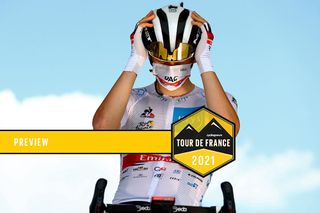
After seven stages of nervous racing, crashes, polemics, sprints and even the yellow jersey joining the breakaway on the road to Le Creusot, the Alps appear high on the horizon during the weekend with two mountain stages to Le Grand Bornand and then Tignes, which should finally establish a more traditional Tour de France GC hierarchy.
Mathieu van der Poel (Alpecin-Fenix) will start stage 8 to Le Grand Bornand wearing the yellow jersey and will surely put up a fight to extend his time as the race leader to a sixth day, but doubts remain over if he can do it. The Dutchman has near superhuman cycling talents but the mountains will surely be his kryptonite and see him passed by an eternal rival, and better climber, Wout van Aert (Jumbo-Visma).
If both explode after their efforts of the first week, then Tadej Pogačar (UAE Team Emirates) is waiting in the wings after emerging from the hectic first week to be the best-placed GC rider, and the favourite to win a second consecutive Tour de France.
Van Aert needs to distance Van der Poel by just 30 seconds to take yellow, but after his efforts of stage 7 he will need superb recovery to be able to climb well in the Alps and stop Pogačar from leapfrogging him and snatching the yellow jersey.
Tour de France 2021: The essential race guide Tour de France 2021: 5 key stages Van Aert joins forces with Van der Poel in pursuit of Tour de France yellow
Pogačar is a significant 3:13 down on Van Aert but appears on form and poised for race leadership. His rivals are not yet beaten and UAE Team Emirates are not yet a super team, but his most dangerous rivals are falling by the wayside day after day.
Primož Roglič (Jumbo-Visma) suffered from his crash injuries and lost four minutes on Friday, taking him out of contention and possibly out of the race. Geraint Thomas (Ineos Grenadiers) is also suffering and on the defensive after he crashed and dislocated his shoulder. He is 1:46 down on Pogačar but could lose more time in the high mountains due to the pain of his battered body.
Richard Carapaz appears to be Ineos Grenadiers’ best hope of victory even if he is the worst time triallist of the four pre-race leaders. His old enemy Movistar helped pull back his late attack on Friday and may do the same in the Alps as the Spanish team rides for Enric Mas. Carapaz is 1:36 down on Pogačar after a poor time trial but seems fresh and is set to be aggressive in the Alps.
Get The Leadout Newsletter
The latest race content, interviews, features, reviews and expert buying guides, direct to your inbox!
The rest of the top 10 and the list of outside contenders is still in flux and wide open to whoever can climb well in the Alps.
Can Julian Alaphilippe (Deceuninck-QuickStep) keep French hopes alive and fly in the mountains as he first did in 2019? Probably not. He was climbing well at the Tour de Suisse but seems to be lacking his wings so far on home turf.
Jonas Vingegaard will be Jumbo-Visma’s best hope for the final GC in Paris now that Roglič has lost time. He proved in Laval that he can time trial but is racing into the unknown on his Tour de France debut.
Rigoberto Uran (EF Education-Nippo) has been flying below the radar and avoiding the crashes so far but nobody has forgotten his impressive results at the Tour de Suisse. He is closer to Pogačar than Thomas and other rivals, making him one to watch.
Nibali is not expected to survive in the Alps as he focuses on preparing for the Tokyo Olympic Games but Wilco Kelderman seems to be consistent and always present after his switch to Bora-Hansgrohe. Mas has a great opportunity to shine, while David Gaudu (Groupama-FDJ) could bounce back, win a mountain stage and perhaps return to the top ten overall.
All the GC riders will be tested during the next two stages in the Alps with long, high climbs, a descent to the finish in Le Grand Bornand, and the risk of thundershowers on Saturday, then the mountain finish up to Tignes on Sunday after the Col du Pre and then the Cornet de Roseland.
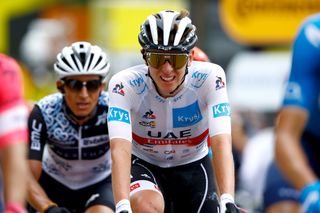
Taking the race up another level
Both stages are relatively short, Saturday at 151 kilometres and Sunday at 145 kilometres, but will surely shake up the race. We have enjoyed a week of intense action and drama but the Alps will take the Tour to another level.
Stage 8 starts in Oyonnax with an uncategorised climb offering the perfect launchpad for breakaway attacks. The big climbs come in the final third of the stage after a ride from the Jura south into Haute-Savoie.
The Alps raise their heads with the Cote de Mont-Saxonnex. It is far more than a simple cote and is a category 1 climb that lasts 5.7km at 8.3 per cent. After a week in the big ring, some may find the transition to the little ring a little uncomfortable.
All the climbs of the stage are unusually over eight per cent, perhaps suiting the featherweight climbers and stage hunters like Nairo Quintana (Arkèa-Samsic), Gaudu, Miguel Angel Lopez (Movistar), and Sergio Higuita (EF Education-Nippo).
The Col de Romme and Col de la Colombière combination featured in the 2009 and 2018 Tour. The Romme kicks up viciously from the valley floor on a spectacular road hacked out of the cliff face. It is 8.8km long and climbs at 8.9 per cent average, with the steepest section at the start.
If Roglič and Thomas lose contact here their losses could be massive.
The Romme-Colombière is a real double whammy, with the Col de la Colombière - 7.5km of climbing at 8.5 per cent, creating a total of 20 kilometres of climbing with only a slight interlude of recovery on a short descent.
The fast sweeping and fast 15km drop into the finish at Le Grand-Bornand will be raced at the limit as the Tour awards the best descenders as well as best climbers.

Back to Tignes for the first mountain finish
Sunday’s ninth stage from Cluses south and up to Tignes is the first time the Tour has ever finished at the historic ski resort.
The finish in 2019 was famously abandoned following a freak storm that washed out the roads on the descent from the lofty Iseran pass and saw Egan Bernal awarded the stage victory and the yellow jersey because he was away alone at the summit of the Iseran.
The Tour promised to quickly make amends and returns this year but via the Col du Pre and then the Cornet de Roseland instead of the lofty Iseran.
There are five categorised climbs on the full 144.9km menu. The second-category Côte de Domancy is the first and is renowned for providing the springboard for Bernard Hinault’s victory in the 1980 World Championships in Sallanches.
The Col des Saisies (9.4km at 6.2 per cent) follows before a long descent into Beaufort.
The Hors Category Col du Pré comes next and earns its status due to a hard 12.6km at 7.7 per cent. From the summit, the road descends to the Roselend reservoir and crosses the dam at the bottom end, before climbing the Cormet de Roselend, which is not far short of 2,000 metres high. Another long descent leads down into Bourg-Saint-Maurice and the start of the long and gradual climb up the Tarentaise valley towards Tignes.
It’s a steady 21km at 5.6 per cent on wide roads, so teammates could be vital here if there are attacks to drive home or to chase down.
The stage does not officially count as a summit finish because the final two kilometres to the line are flat, but it is the first mountain finish of this year's Tour and the high point of the Alps before the first rest day on Monday. By the time the riders enjoy their day off, the 2021 Tour de France will surely look far different than it does now.

Thank you for reading 5 articles in the past 30 days*
Join now for unlimited access
Enjoy your first month for just £1 / $1 / €1
*Read any 5 articles for free in each 30-day period, this automatically resets
After your trial you will be billed £4.99 $7.99 €5.99 per month, cancel anytime. Or sign up for one year for just £49 $79 €59

Try your first month for just £1 / $1 / €1

Stephen is the most experienced member of the Cyclingnews team, having reported on professional cycling since 1994. He has been Head of News at Cyclingnews since 2022, before which he held the position of European editor since 2012 and previously worked for Reuters , Shift Active Media , and CyclingWeekly , among other publications.
Pogačar like Pantani – 26 years on, the Giro d'Italia-Tour de France double is possible
The fight goes on: WADA, doping, and the biological passport - part 1
'Main objective is win stages' – Visma-Lease a Bike take new approach at Giro d'Italia
Most Popular

2024 Tour de France Jun 29 - Jul 21
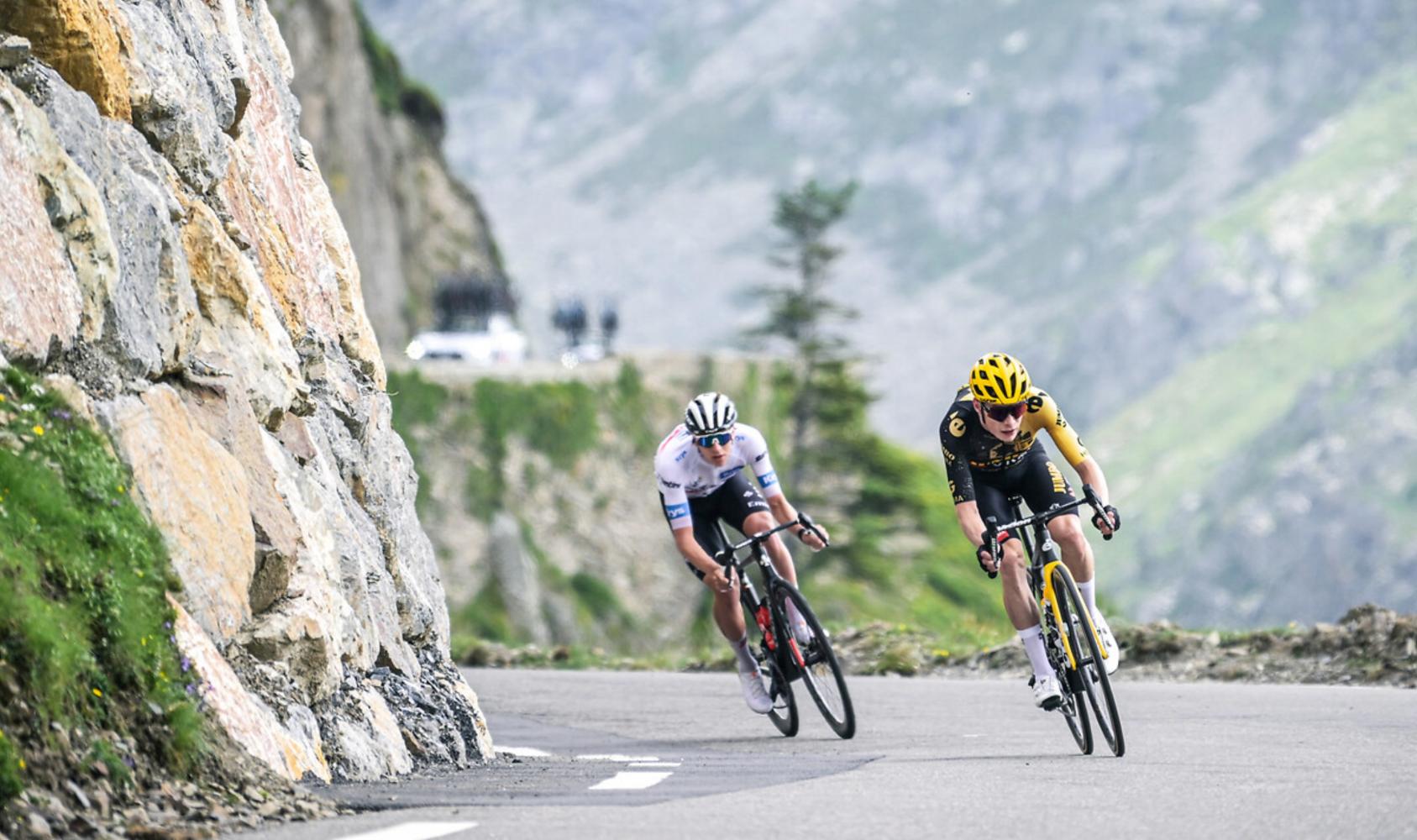
Statistics:
Total climbs: 70, top 100 world: 70, avg. fiets (top 5) : 8.9, sort by attribute:, showing all 70 climbs, pjamm trips adventure starter bundles, member comments.
2024 Tour de France: June 29 to July 21, 2024
Also visit our: (1) All Time Hardest Tour de France Climbs , (2) Most Legendary and Famous Climbs of the Tour de France , and, (3) 10 Highest Climbs in Tour de France History pages for more Tour de France inside information.
https://www.letour.fr/en/overall-route
2024 TdF Stage Statistics
Col du Tourmalet -- Stage 13: July 6, 2024
Since 1910 - 90 appearances in the TdF - more than any other climb.
Official post-race summary for Stage 1 (June 29) - Letour.fr - Stage 1 - TBD
TOP 10 MOST FREQUENT CLIMBS OF THE TOUR DE FRANCE
(AND 10 FAMOUS ONES AFTER THAT)
©PJAMMCycing.com
Interesting 2023 TdF Facts (2024 Coming Soon)
- This is the 111th Tour de France;
- Start: Florence, Italy on Saturday, June 29, 2024 - this is the first time the Tour has ever started in Italy.;
- Finish: Nice, France on July 21, 2024 - this is the first time the tour has ever finished outside Paris.
- The tour is not finishing in Paris because of a conflict with the 2024 Summer Olympics which will be centered in Paris from late July to early August.
- 22 teams, 8 riders each - 176 total riders starting in Florence.
- Countries visited: Italy (3 stages), Republic of San Marino (1), France (19) and Monaco (1)
- Mountain ranges included in the 2024 TdF: The French and Italian Alps, Apennines (Italy) Pyrenees (France) and Massif Central (France);
- Categorized climbs: Not yet named.
- Col du Tourmalet returns for the 90th time, by far more than any other climb featured in the Tour.
- Other notable climbs appearances:
- Col du Galibier (64 appearances - fifth all time)
- Col de Peyresourde (69 appearances - number 4 all time)
- Col de Portet Aspet (59 appearances)
- Distance: 3,492 kilometers (2,170 miles) - the longest tour was in 1926 at 5,745 kilometers (3,570 miles);
- Longest stage: Stage 3 - Piacenza to Turin, Italy 227 km / 141 miles);
- Total Elevation gained: 51,737 m / 169,741 ’(well below 2023 at 57,378m/188,248’ but above 2022 at 47,861m / 157,024’);
- Most elevation gained on a stage: Stage 15 (4,901 m / 16,079’’; includes Peyresourde and Plateau de Beille);
- Most elevation gained on a climb: Cime de la Bonette at 1,586 meters (5,203’) over 24 kilometers (15 miles);;
- Highest point on the 2024 TdF is Cime de la Bonette (Stage 19) at 2,802 meters (9,192’)
- This is the highest the Tour de France has ever gone.
- Cime Bonette has been featured 5 times in the TdF.
- This is the first time Bonette has appeared in the Tour since 2008.
- Steepest climb: Col de Portet d’Aspet 4.4 kilometers at 9.9% (Stage 15);
- Steepest segments: (you can filter yourself using the sorting tool in to the left of the map, above)
- 1 kilometer: 14% Pla d’adet (Stage 14)
- 2 kilometers: 12.5% Puy Mary (Stage 11)
- 5 kilometers: 103% Pla d’Adet (Stage 14)
- 10 kilometers 8.6% Plateau de Beille (Stage 15)
- 1 mile: 12.7% Pla d’Adet (Stage 11)
- 5 miles: 9.1% Pla d’Adet (Stage 14);
- This is the 111th Tour de France since its first edition in 1903:
- No TdF 1915-1918 (WWI)
- No TdF 1940-1946 (WWII)
- TdF postponed from 27 June 2020, to 29 August 2020 due to COVID-19 pandemic;
- 7 mountain stages (4 summit finishes)
- 4 hilly stages;
- 8 flat stages;
- 2 individual time trials
- Two rest days (one after Stage 9 and one after Stage 15);
- There is an individual time trial on the final day of the Tour, the first TT on the last day since 1989 when Greg LeMond edged Laurent Fignon by 8 seconds to win his second of three titles.
- There are four summit finishes:
- Saint-Lary-Soulan Pla d’Adet - Stage 14, July 13
- Plateau de Beille - Stage 15, July 14
- Isola 2000 - Stage 19, July 19
- Col de la Couillole - Stage 20, July 20
- The five hardest climbs of the 2024 Tour de France are:
- Cime Bonette (24 km at 6.55)
- Col du Tourmalet (18.7 km at 7.1%)
- Plateau de Beille (15.3 km at 7.9%)
- Isola 2000 (16.2 km at 7.1%)
- Col de la Couillole (15.9 km at 7.2%) ;
- Time bonuses will be awarded at the finish of each stage: 10 seconds (first), 6 seconds (second), and 4 seconds (third).
- There will also be bonus seconds that will be located on climbs at strategic points: 8, 5, and 2 seconds for first through third riders past those points;
- 14 gravel segments on Stage 9 (Troyes to Troyes) with 32 of the total 199 kilometers consisting of strade bianche (white or gravel roads).
- No cobbles on this year’s Tour.
- HC & Category Climb: TBD
- Prize money: Total $2,300,000 euros ($500,000 to the overall winner).
Historical Tour de France Facts of Interest
- Climb most often featured in the Tour: Tourmalet - 90 times as of 2024 with Col d’Aspin second as of 74.
From Campan: 16.9 km gaining 1267m at 7.5% average grade.
From Luz Saint Sauveur: 18.7 km gaining 1319m at 7.1%.
- Highest point ever reached in the Tour de France: Cime de la Bonette, at 2,802 meters
Cime de la Bonette is the highest point ever reached by the Tour de France.
2,802 meters - Stage 18 1962 (passed again in 1964, 1993, 2008, 2024).
Five highest points the Tour de France has ever reached.
Also see Top 10 Highest Points of the TdF
- Highest point of first (1903) TdF: Col de la République (1,161m).
- Most TdF wins:
- Yellow Jersey - overall winner:
- 5 Jacques Anquetil (1957, 1961-1964)
- 5 Eddy Merckx (1969-1972, 1974)
- Merckx has the most Grand Tour wins of anyone (11 - 5 TdF, 5 Giro, 1 Vuelta)
- 5 Bernard Hinault (1978-1979, 1981-1982, 1985)
- Has the second most Grand Tour wins (10 - 5 TdF, 3 Giro, 2 Vuelta)
- 5 Miguel Indurain (1991-1995)
- 4 Chris Froome : (2013, 2015-2017)
- Polka Dot (King of the Mountains - since 1933):
- 7 Richard Virenque : 1994-1997, 1999, 2003, 2004 (best tour finish #2 1997)
- 6 Frederico Bahamontes : 1954, 1958, 1959, 1962, 1963, 1964; nine in Grand Tours
- Green Jersey (most points; since 1953)
- 7 Peter Sagan
- 6 Erik Zabel : 1997-2001
- Most days wearing the yellow jersey:
- 111 Eddy Merckx
- 79 Bernard Hinault
- 60 Miguel Indurain
- Most days wearing yellow jersey in a single TdF:
- 21: Jacques Anquetil 1961 - held the yellow jersey from day one.
- Most stage wins:
- 34 Eddy Merckx
- 34 Mark Cavendish
- 28 Bernard Hinault
- Most stage wins in a single tour:
- 8 Charles Pélissier , 1930
- 8 Merckx 1970, 1971
- 8 Freddy Maertens 1975
- Most times atop the podium (top three TdF finish):
- 8 Raymond Poulidor
- First mountain stage and climbs in the Tour:
- Stage 10 July 21, 1910: Luchon to Bayonne
- 326 kilometers
- Circle of Death: Col de Peyresourde, Col d’Aspin, Col du Tourmalet, and Col d’Aubisque
- On arriving at the top of Col d’Aubisque Octave Lapize (TdF 1910 winner) yelled to tour organizers what is variously reported as: “murderers,” “assassins,” or “criminals.” He also said he would quit the tour after descending to Laruns, but he rallied to complete the stage and go on to win the 1910 Tour de France.
Circle of Death
Tourmalet was the highest point the tour had ever reached as of 1910 (2115m)
Previous high point had been Col de Porte (1326m).
- First mountain-top stage finish: Alpe d’Huez (Dutch Mountain/The Alpe) was the first mountain-top finish in the history of the Tour de France in 1952, Stage 10.
- Country wearing the yellow jersey most:
- France (709)
- Belgium (434)
Frenchmen have been in the maillot jaune (yellow jersey) far more than any other country.
- Winning TdF in first appearance:
- 11 between 1903 - 1983, but none since Laurent Fignon (1983) until 2020 and Tadej Pogačar
- Youngest winner of the Tour:
- Henri Cornet : France, age 19 (1904)
- Tadej Pogačar: Slovenia, age 21 (2020)
- Oldest TdF winner:
- Firmin Lambot: Belgium, age 36 (1922)
- Most TdF appearances:
- 18 Sylvain Chavenel (2001-2018 age 42; top finish 19 2009)
- King of the Mountains: Mountain Classification victories (first recognized in 1933; jersey introduced 1975)
“Symbol of the mountains, of a rider pushing beyond their limits and of courage, the red polka dot jersey, which is sponsored by Carrefour, is awarded to the Tour de France’s leader of the best climber classification. Although this classification was introduced in 1933, its symbol, the polka dot jersey, appeared in 1975, which was also the year the Tour first finished on the Champs-Élysées and was won by Bernard Thévenet. It owes its appearance to track racing specialist Henri Lemoine, who competed between the 1930s and 1950s, and that Félix Lévitan, co-director of the Tour with Jacques Goddetwhich, had particularly noticed. While Belgium’s Lucien Van Impe was its first winner and claimed the mountains classification six times, just like his illustrious predecessor, Spain’s Federico Bahamontes, the so-called “Eagle of Toledo”, Frenchman Richard Virenque holds the record for victories with seven titles” ( Tour de France, Polka Dot Jersey ).
- Richard Virenque : 7 (1994-1997, 1999, 2003, 2004; best tour finish #2 1997)
- Frederico Bahamontes : 6 (1954, 1958, 1959, 1962, 1963, 1964; nine in Grand Tours)
- Triples (none ever in the same year): Frederico Bahamontes and Louis Herrera .
- Doubles same year (TdF+Giro): Fausto Coppi , Charly Gaul , Lucien Van Impe , Claudio Chaippucci
King of the Mountains is designated by the red polka dot jersey.
- Most green jerseys (total points):
- 7 - Peter Sagan
- Most white jerseys (best young rider):
- 3 - Jan Ullrich (1996-1998),
- 3 Andy Schleck (2008-2010)
- Least finishers:
- Shortest margin of victory:
- 8 seconds: Greg Lemond over Laurent Fignon in 1989. Lemond overcame 50 seconds in the final time trial using aero bars for the first time in the TdF.
- Greatest margin of victory:
- 2h49’21” in 1903 between Maurice Garin and Lucien Pothier .
- Country with most wins:
- France (36)
- Belgium (18)
- Britain (6)
- Luxembourg (5)
- USA and Denmark (3)
- Hardest climb ever in the Tour de France: Col de la Loze (Meribel).
- See our All Time Top 10 Tour de France Climbs page.
EXPLANATION OF KING OF MOUNTAIN, KOM POINTS, AND BONUS POINTS
FOR THE 2024 TOUR DE FRANCE
KOM DEFINED : Climb-related points are accumulated during the race. The rider with the most accumulated points at the beginning of the stage wears the red polka dot jersey that day, and the rider with the most points at the end of the race is crowned that year’s Tour de France King of the Mountains.
“ Category ”: When the mountain classification (King of the Mountains) was introduced in 1933, there were points given to the first 10 riders over the summit (10 for first, 1 for tenth). In 1947, the Tour introduced two climb “categories” with a certain amount of points for the second category and twice as many as for the first category. Over the years “categories” were added, in addition to an “Above” category (Hors or HC) and since 1979 there have been a HC (hardest), Category 1 (second hardest) on down to Category 4 (least difficult climb).
The category of the climb is significant for two reasons:
- The points awarded for the TdF KOM for each climb is based upon the category of climb - thus, “category” is the basis for the points that are used to determine each year’s King of the Mountains.
- Most cycling fans, particularly Grand Tour fans, are very interested in the climb “category” because that tells them how hard each climb on a stage is, where the riders will struggle more, and the point in a stage where that day, or even the entire tour, will be won or lost.
KOM HISTORY :
- King of the Mountains : Mountain Classification victories (first recognized in 1933; jersey introduced 1975)
- 2020 & 2021 King of the Mountains: Tadej Pogačar , Slovenia (also won the TdF and the Young Rider classification)
- 2022 - Jonas Vingegaard (NED) - also won TdF.
- 2023 - Giulio Ciccone (ITA)
POINTS : KOM points are awarded in three ways on the Tour de France:
- To riders first over the summit of categorized climbs (in descending order HC, 1-4).
- The higher the category the more riders receive points (HC points are awarded to eight riders, while CAT 4 points are awarded to only one rider).
- Bonus point (see below).
- Points for altitude finishes.
TDF POINTS FORMULA : Wikipedia has the best summary and graph we’ve seen for TdF KOM points distribution:
The points gained by consecutive riders reaching a mountain top are distributed according to the following classification:
Wikipedia - Mountains Classification - Tour de France
BONUS POINTS : These points go towards the King of the Mountain designation and are awarded to the first (8 points), second (5 points), and third (2 points) riders reaching designated summits in the race.
- There are no KOM bonuses in the 2022 Tour de France.
MONEY PRIZES FOR KING OF THE MOUNTAINS
- Prize for first to eighth place:
- Winner = €25,000
- 2nd = €15,000
- 3rd = €10,000
- 4th = €4,000
- 5th = €3,500
- 6th = €3,000
- 7th = €2,500
- 8th = €2,000
- Daily prize for wearing the Polka Dot jersey = €6,000
- Per category climb:
- Souvenir Henri Desgrange €5000 first to Col du Galibier pass Stage 11.
The maximum amount the KOM winner could earn if he won every stage and wore the jersey from Stage 2 to the finish is $60,300 Euros (62,773 USD)
Loading Document

5 Iconic Climbs in the Tour de France
Share this:.
- Click to share on Facebook (Opens in new window)
- Click to email a link to a friend (Opens in new window)

Every year, the Tour de France riders navigate 2,000 miles or more as they race across 21 stages of some of the most challenging terrain in the world.
The tour includes various landscapes that assault riders in different ways. Sprints create exciting finishes where athletes often win by microscopic margins. Time trials force riders to give all-out performances that leave fans marveling at their sheer power. Hilly stages are sometimes wild cards where racers can take risks and push themselves in different ways.
But nothing blows the pack of the Tour de France apart like mountainous stages. The Tour de France sends riders on some of the most challenging climbs in cycling .
By the race’s end, riders usually climbed somewhere in the neighborhood of more than 150,000 feet. The most demanding climbing stages significantly affect who walks away in the yellow jersey.
The Tour de France route changes every year. The total number of climbs can vary, and tour organizers can specify different and unfamiliar climbs. Some, however, have become so iconic that they are synonymous with the tour.
Here are five of the most infamous climbs the Tour de France has ever seen.
Alpe d’Huez: A Queen Stage of the Tour de France

The Alpe d’Huez is among the most famous climbs in the Tour de France. The climb is composed of 21 tight switchback turns and runs for just more than 8 miles with an average grade of about 8%.
Riders see a total elevation gain of more than 3,500 feet during the climb. Each of the 21 corners takes its name from a previous stage winner, so it is steeped in the tour’s history.
This route also is a favorite vantage point for fans to come out and watch the race. As they fight to the top, huge crowds line the roadway to cheer on their favorite cyclists.
Alpe d’Huez landed on Stage 12 in 2022. It once again became a venue for race leaders to jockey for position for the yellow jersey. British rider Tom Pidcock became the youngest rider to ever win the stage after putting on a descending clinic earlier on the route. Jonas Vingagaard and Tadej Pogačar hung together in a tough battle to finish neck and neck, though Vingagaard held his lead and the yellow jersey.
Col du Galibier
The Col du Galibier also appeared in Stage 12 of the 2022 Tour de France as the first climb of the day ahead of the Col de la Croix de Fer and the aforementioned Alpe D’Huez. The climb marked the highest point in the Tour de France this year.
The Col du Galibier runs for about 20 miles at an average grade of about 5%. It includes around 4,000 feet of elevation gain. The first 7 or so miles of the 2022 stage featured a steady, shallow climb to an early intermediate sprint. After that, the route pitched dramatically upward to the Col du Lautaret, and then onward to the summit of Galibier.
Anthony Perez of team Cofidis powered up the climb this year to reach the summit first.
Mont Ventoux: One of the Most Popular Climbs of the Tour de France

Mont Ventoux is iconic for its beauty, difficulty, and tragic history. The climb ascends about 13.3 miles with an average grade of 7.6% for a total elevation gain of more than 5,000 feet.
The top of the climb features an exposed, rocky landscape allowing sweeping views of the countryside beneath. But it also allows riders to see the long, upward pathway fade into the distance, which presents a daunting mental battle as they struggle up the mountain.
The exposed nature of the route often leads to high winds that make the ascent even more difficult and uncertain.
British cyclist Tom Simpson collapsed near the summit of Mont Ventoux during the 1967 Tour de France. Emergency crews flew him to a local hospital for care but were unable to save his life. A memorial to Simpson still sits near the summit of the stage.
Mont Ventoux is not included in the 2022 Tour de France.
Col du Tourmalet: The Tall Boy
The Col du Tourmalet is the highest mountain pass in the French Pyrenees, so you know it gets spicy.
It covers around 10 miles with a total elevation gain of about 4,300 feet at a grade of 7.1%. However, portions of the climb reach up to 9.7%. The climb is consistent and lung-busting, offering no reprieve for riders to catch their breath before the summit.
The Col du Tourmalet has been included in the Tour de France more than any other climb. Its last appearance came in the 2021 race. It is not included in this year’s Tour de France.
Col d’Aubisque
The Col d’Aubisque has earned its place in history as one of the significant climbs of the race.

First used in 1910, the climb runs for around 10 miles at an average grade of 7.2%.
The Col d’Aubisque presents one of the final mountain challenges for the 2022 race. It is the first “super category” climb of Stage 18, which runs for 88 miles from Lourdes to Hautcam.
With only two flat stages and an individual time trial remaining, the Aubisque pass could become a make-or-break section and the last chance for a rider to attack and pull back time in the mountains.
Even completing one of these climbs is a feat for most cyclists. They could take an average rider a couple of hours to grind out, and they’ll hurt.
It’s pretty astounding that Tour de France riders often hit them back to back over more than 100 miles of racing. But aside from punishing riders, these climbs showcase the stunning landscapes of the French Alps and Pyrenees and make the Tour de France such a celebrated event.

Wout van Aert Borrows a Pump From a Fan and Gives Him the Tour de France Green Jersey
When a fan helped him out with a predicament after Stage 11 of the Tour de France, Wout van Aert returned the favor with the literal shirt off his back. Read more…

Don't Let the Yellow Jersey Fool You — The Tour de France Is Won by a Team
Riders who claim the yellow, green, polka dot, and white jerseys in the Tour de France may get all the glory, but the race is a team sport. Read more…

Mark Wilson is a freelance journalist for GearJunkie and BikeRumor. Mark has been writing about cycling, climbing, outdoor events and gear for more than a year. Before that, he spent more than a decade as a journalist at major daily newspapers in Texas covering crime, public safety and local government. Mark spent every free moment during that time carving up singletrack and gravel, or climbing with friends and family in Texas, Colorado and Mexico. Based in Texas, Mark is always looking for new trails, crags and gear to help navigate the outdoors. As a new dad, he is particularly interested in learning how to share his love of the outdoors with his son.
Follow Us On
Subscribe Now
Get adventure news and gear reviews in your inbox!
Join Our GearJunkie Newsletter
Gear Top Stories Deals

Climbs of the 2022 Tour de France
In this short summary of the climbs of the 2022 Tour de France, we include all the information you need to prepare for the various stages. This edition of the Tour de France, sees the riders tackling climbs in three mountain ranges, the Jura, the Alps, and the Pyrenees. We will see some of the iconic Tour de France climbs including Alp d’Huez, Col du Galibier, and Col du Peyresourde which will be fantastic to watch.
Our tables list out all the officially categorized climbs with information such as climb length, average gradient, distance from the stage start, and categorization. Where possible we have also included the gradient profile for these climbs. We have also included the estimated time the first riders will hit the top of each of the climbs. This is handy information if you will be watching the tour either in person or on TV.
We also have a separate article with lots of information about all the stages of the 2022 Tour de France which you can access here . If you are planning on watching the Tour de France by the roadside for the first time you can see our tips for watching it in person.
Our site also has plenty of information about visiting France for a cycling holiday, so make sure you check it out. The Practical section has all the necessary information about things like visa requirements, using your mobile phone, how to get money out etc while our Destination section includes information about where to stay and how to get to various cycling destinations as well as cycling routes for you to ride.
A brief history of the mountains in the Tour de France
In most editions of the Tour de France, the mountain stages are where the race is won or lost. A single bad day for a rider in the mountains can see them lose minutes to rivals and an end to their title bid. On long mountain climbs, there is nowhere to hide and any little chinks in a rider’s armor are usually found out. Over the years climbs such as Alpe d’Huez, Col du Galibier, Mont Ventoux, Col du Tourmalet and Col d’Aubisque have become synonymous with the race.
The mountain stages are some of the most popular for people to watch the race and there are many iconic images of riders navigating a sea of spectators. It is estimated that many hundreds of thousands of fans line the mountain roads as they twist and turn their way to the summit. On rare occasions, fans get a little too close and bring a rider down.
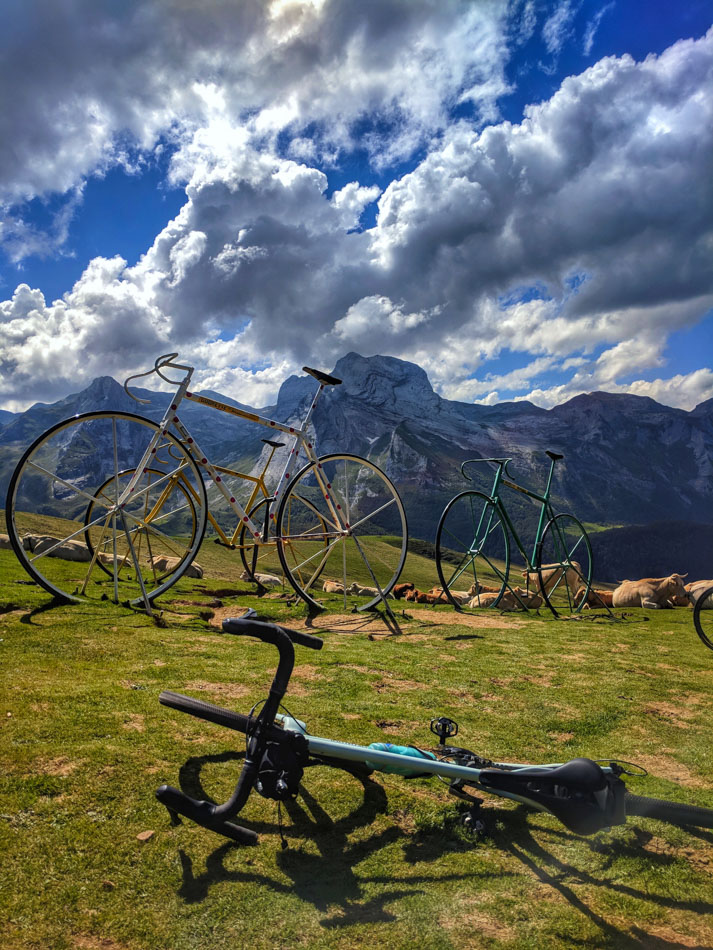
First mountain stage in the Pyrenees
The mountains first entered the Tour de France in the 8th edition in 1910. In that year stage 10 started in the Pyrenean town of Bagneres de Luchon and climbed Col du Peyresourde, Col d’Aspin, Col du Tourmalet and Col d’Aubisque before finishing 326km later in Bayon. Octave Lapize finished the stage first in a time of 14hrs 10mins. No mean feat given that all the mountain passes were dirt roads back in those days and the bikes had nowhere near the range of gears modern bikes now have.
Inclusion of the French Alps
While the organizers deemed the addition of the mountains to be successful the riders were less impressed and there were protests in 1910 about the stage. Nevertheless, in 1911 the French Alps were added to the race with the inclusion of Col du Galibier, Col de Castillion, and Col de Braus. This was in addition to the stage in the Pyrenees.
Since those early days, both the Pyrenees and French Alps have featured in the race annually. In later years climbs in other regions such as the Jura, the Vosges, and the Massif Central have been added to the race. The Pyrenees and French Alps have generally taken turns in being featured in the all-important last week of the race. In 2021 it is the Pyrenees that will close out the mountain stages for this edition of the race.
2022 Tour de France climb stats
The 2022 Tour de France includes 11 stages with categorized climbs, five of which includes a summit finish; Stage 7 La Super Planche de Belle Filles, Stage 11 Col du Granon, Stage 12 Alpe d’Huez, Stage 17 Peyragudes, and Stage 18 Hautacam. The race includes 25 categorized climbs on 24 different mountains with Col du Galibier being climbed twice by the riders over consecutive days.
There are four climbs over 2,000m in the 2022 Tour de France with the highest being Col du Galibier at 2,642m (climbed twice), followed by Col du Granon at 2,413m and Alpe d’Huez at 2,067m. The longest climb is the climb to Col de la Croix de Fer from St Jean de Maurienne which is 29km at an average gradient of 5.2%. The shortest climb on the 2022 Tour de France is the first categorized climb, Côte de Pulventeux, which averages 12.3% for 800m on stage 6.
At the time of putting this table together, there is some information not yet publicly released by ASO about the route, which means there may be some blanks in the table. As it becomes available we will include it so be sure to check back.
Categorization of Tour de France climbs
Each of the climbs is given a categorization which is an indication of the difficulty of the climb. Hors category (HC) are the toughest climbs followed by category 1, category 2, category 3, and category 4. A category 1 climb will be harder than a category 3 climb so the lower the number the harder the climb. A climb can change categorization based on how far into a stage it might be. For example, a climb could be considered a category 2 climb if it comes early on in the stage when riders have fresh legs, or a category 1 climb if it comes towards the end.
The climb categorization also comes into play when awarding points in the Polka Dot jersey competition. For example on an HC climb the first rider over the top will be awarded 20 points while on a category 4 climb the first rider will be awarded 1 point. On an HC climb points are awarded for the first 8 riders while on a category 4 climb only the top rider receives any points. There is a sliding scale of points and positions between HC and category 4.
Planning your own cycling holiday to France
If you are planning a trip to France to ride some of these climbs and the many more on offer our site includes lots more information. We have written guides on the Best base for cycling in the Pyrenees and Where to stay in the French Alps with lots of information about these two areas. Our Destination guide page has more detailed information about The Pyrenees, The French Alps, The Alpes Maritimes, The Jura, and Provence and Luberon.
We also have lists of cycle hotels , airline luggage rules , cycle tour companies , and bike travel cases to help you plan your trip.
- Skiing into Spring
10 legendary mountain passes and climbs
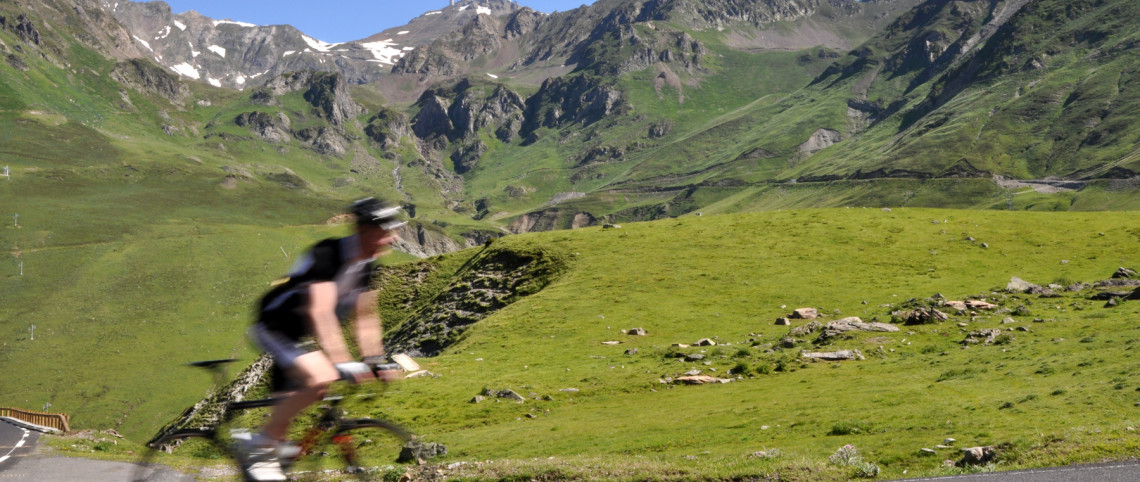
Mise à jour le --> 21.06 2023 --> --> --> --> Discovery
Regularly used by the Tour de France, every summer they attract cyclists from all over the world. However, you’ll need at least some training to follow in the wake of the top cycling champions, but the stunning landscapes revealed along the way make it well worth the effort.
Le Portet d’Aspin (1,489 metres)
Like Tourmalet, le Col d’Aspin is a real classic for the Tour de France, which has climbed it 71 times. Thomas Voeckler was the last to conquer it in the lead, during the 16th stage of the 2012 Tour de France (Pau / Bagnères-de-Luchon), a race he went on to win after leading the day’s four challenges (Aubisque, Tourmalet, Aspin and Peyresourde). The most difficult climb starts at Arreau (12 kilometres at 6.7%). It’s unusual because of the unevenly spaced hardwood trees alongside the road, which zig zags up through picturesque mountain pastures. The climb is more irregular from Sainte-Marie-de-Campan (12 kilometres at 5%) with a harder final section (from the ski resort and Lac de Payolle, at 1,100 metres in altitude).
Le Col du Grand Colombier (1,498 metres)
Despite only featuring in the Tour de France once (in 2012), le Col du Grand Colombier is nonetheless formidable. Its four access routes all represent an almost two-hour climb for the average cyclist: 15.9 kilometres at 7.87% from Artemare; 18.3 kilometres at 6.89% from Culoz; 15.7 kilometres at 7.97% from Anglefort and 19.2 kilometres (at 6.75% on the last 15 kilometres) from Champagne-en-Valromey. This Jura giant – situated on the border of the Savoie department – provides breath-taking views over Lac du Bourget from its summit.

Col de Peyresourde (1,569 metres)
Situated near the ski resort of Peyragudes, le Col de Peyresourde is characterised by the blanket of moss covering the Alpine pastures through which its road snakes. According to the former director of the Tour de France, Jean-Marie Leblanc, “this climb makes you want to lie down and sleep in the grass, next to the sheep and cows”! Climbed 65 times by Tour de France competitors, it offers a 9.9 kilometre stretch on the west side (at an average incline of 6.6%) and 15.3 kilometres on the east side (at an average incline of 6.1%). Beware though, its irregular incline (with 12% stretches on each side) and frequent gusts of wind make this climb a more delicate operation than the numbers alone suggest.
Alpe d’Huez (1,803 metres)
It’s hard to imagine it today, but the first time the Tour de France came to Alpe d’Huez in 1952, only a handful of fans were in attendance. Thereafter, the climb went on to become a highlight of the world’s biggest cycling race. Now some 500,000 people gather along the climb’s 21 numbered hair-pin bends – each road sign featuring the name of an Alpe d’Huez stage winner and the corresponding year of their victory – happily arriving several days in advance to set up. In summer, around 1,000 cyclists (5,000 a day during the week of the Tour) set off every day to tackle the 13.1 kilometre climb, at an average of 8.19%. Internationally, Alpe d’Huez is more famous for its access road’s 21 hair-pin bends than for its 250 kilometres of ski runs!

Le Mont Ventoux (1,912 metres)
Visible for 100 kilometres in all directions, the Mont Ventoux summit appears to be permanently snow-capped, even at the height of summer. This almost lunar look, a consequence of repeated forest fires and deforestation that began back in the Middle Ages, is why it’s been nicknamed “Mont Bald”. Despite only looking slightly more difficult on paper (21.5 kilometres at 7.22%, versus 21.2 kilometres at 7.15%), the climb from Bédoin, on the south side, is unquestionably more famous than that on the north side, from Malaucène. It’s worth noting that 12 of the 15 Tour de France climbs started at Bédoin, compared to 2 on the north side and just 1 on the east side, from Sault. The latter, by far the easiest (25.7 kilometres at 4.5%), joins the Bédoin road at the level of the Reynard chalet, 6 kilometres from the summit.
Le Col de la Croix de Fer (2,067 metres)
It’s not only the average gradient (27.53 kilometres at 4.7% on the Isére side from Verney Dam; 30 kilometres at 5.07% from Saint-Jean-de-Maurienne on the Savoie side) but also its irregularity and length that make La Croix-de-Fer such a difficult climb. Cyclists who gamely attempt this Tour de France classic (which has featured in the event 16 times since 1947) are however rewarded by a succession of stunning landscapes: waterfalls plunging down into the valley, the Grand-Maison Dam, the Aiguilles de l’Argentière on the Isére side; the Aiguilles d’Arves and the Belledonne chain on the climb from Saint-Jean-de-Maurienne.
Le Col du Tourmalet (2,115 metres)
Despite having a name that seems to translate from French as the “bad trip”, this Pyrenean giant remains the most-climbed Col in the history of the Tour de France (79 times). The first time “La Grande Boucle” paid it a visit in 1910, Octave Lapize – who carried out a large part of the climb on foot, pushing his bike – felt entirely justified in labelling its organisers “killers”. Today, the climb will take an average cyclist around two hours to complete, either on its west side (17.2 kilometres at 7.4% from Sainte-Marie-de-Campan, via the resort of La Mongie) or its east side (18.8 kilometres at 7.4% from Luz-Saint-Sauveur, via Barèges).
Le Col de l’Izoard (2,360 metres)
When you think of Izoard, the first thing that comes to mind is the barren scree slopes overlooking the road, which, like Mont Ventoux, give the place a lunar feel. The presence of cargneule peaks (a local sepia-coloured rock) reinforces the austere look of the so-called “Casse Déserte” situated just over 2 kilometres from the Col on the south side. Of the 33 times the Tour de France has been through here, it has been the most-climbed section (15.9 kilometres at 6.9%). In 2011, Andy Schleck, then 4th in the General Classification, launched an attack 60 kilometres from the start, which went on to deliver him first place in the stage. The Col’s north side, from Briançon, offers a 19.2 kilometre climb at an average gradient of 5.92%.
Le Col du Galibier (2,642 metres)
Climbed 58 times, le Col du Galibier numbers among the Tour de France’s “classic climbs”. This year once again it will be the highest summit the peloton passes through, during the Modane – Alpe d’Huez stage. If the south side (8.52 kilometres at 6.9% from le Col du Lautaret) is far from a bed of roses, what can be said about the north side, with 18.1 kilometres at 6.9%, and the most difficult kilometres bunched towards the end? It was on these slopes that Marco Pantani laid the foundations for his final victory in 1998.

Le Col de l’Iseran (2,770 metres)
This Col, which connects the Maurienne and Tarentaise Valleys, prides itself on being the highest Col road in the Alps. Before the road – which opened in 1937 – was built, the Col de l’Iseran the site of so many mysteries and dramas that in Bonneval-sur-Arc (the starting point of the south face climb) it gave rise to the following adage: “If everyone who died on Iseran stood hand in hand, they would stretch from here to Val d’Isère”. Today, the Col de l’Iseran is a prime tourism site. It provides access to Val d’Isère’s summer ski area (on the Pisaillas glacier), and of course two superb cycling climbs: 48 kilometres at 4.1% from Bourg-Saint-Maurice on its north side (including 16 kilometres at 5.8% from Val d’Isère) or 13.4 kilometres at 7.3% from Bonneval-sur-Arc, on the south side.
Col de l'Izoard ©Martin Léger
Col du Galibier ©ASO
Montée du mont Ventoux ©A.S.O
peloton montée au Col du Glandon ©A.S.O
Montée vers l'Alpe d'Huez ©A .S.O
Col de la Croix-de-fer© A.Gros
You might also like these articles
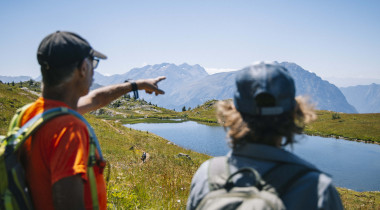
Flocon Vert label: for resorts who are committed to sustainable development in the mountains
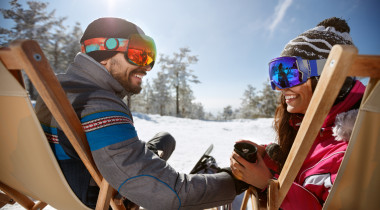
10 reasons to head for the mountains of France this winter!
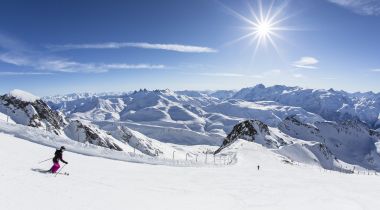
6 legendary ski runs

10 (deeply) beautiful landscapes to admire this summer
CURRENT PRICES END MAY 12
Outside Festival feat. Thundercat and Fleet Foxes.
FROM JUST $44
Powered by Outside
Tour de France
Tour de france stage 4: back to france and into the high alps, the first major exam for the tour general classification contenders as the race visits two legendary climbs..
Heading out the door? Read this article on the new Outside+ app available now on iOS devices for members! >","name":"in-content-cta","type":"link"}}'>Download the app .
Stage 4 — Tuesday, July 2 Pinerolo to Valloire Distance: 139.6km (87 miles) Profile: Mountain stage
Stage 4: The first major exam for the Tour general classification contenders
The shortest stage outside of the two individual time trials will be a testing one, with the route from Pinerolo in Italy to Valloire in the Alps crossing three major climbs, and ensuring hardly a kilometer of level ground during the 139.6 kilometers of racing.
The road rises as soon as the flag drops in Pinerolo, with the summit of Sestrières located 50.4km after the start. Fausto Coppi took a famous victory here in the 1952 Tour, having earlier triumphed in Pinerolo during the 1949 Giro. He also won both races overall.
The 39.9km climb, which also saw a defiant victory by Claudio Chiappucci ahead of Miguel Indurain in the 1992 Tour, is the first over 2,000 meters in this year’s race. It is followed 21km later by the summit of the Col de Montgenèvre, with this Tour’s second-highest peak in turn located 49km later.
The Col du Galibier is one of the most famous climbs in cycling. It first featured in the 1911 Tour de France and has featured no less than 31 times since 1947. In 2011 it was used for the first time as a stage finish, with Andy Schleck triumphing there after a 60km solo break.
At 23km in length and 2,642 meters above sea level, it is one of the most ferocious climbs in this year’s race. While 19km of descent remains after the summit, those first over the top have a huge chance of the stage win and, potentially, the yellow jersey.
The view of Tour de France race director Christian Prudhomme: “The race leaves Italy after a long climb to the resort of Sestrières, where Coppi triumphed in 1952, the border subsequently reached at the Col de Montgenèvre. Then, after ascending the Lautaret pass, the riders will tackle the 2,642-metre Galibier. This will be the first opportunity for the favorites to test themselves in the high mountains.”
- Tour de France 2024 Achievements
- Where are the mountain passes? achievement
Tour de France 2024
Sign in or sign up to start making your own lists.
- Create a list
- 0 want to boost

Where are the mountain passes? achievement in Tour de France 2024
Finish the Breizh Cup.
Have you got any tips or tricks to unlock this achievement? Add a guide to share them with the community.
Gear-obsessed editors choose every product we review. We may earn commission if you buy from a link. How we test gear.
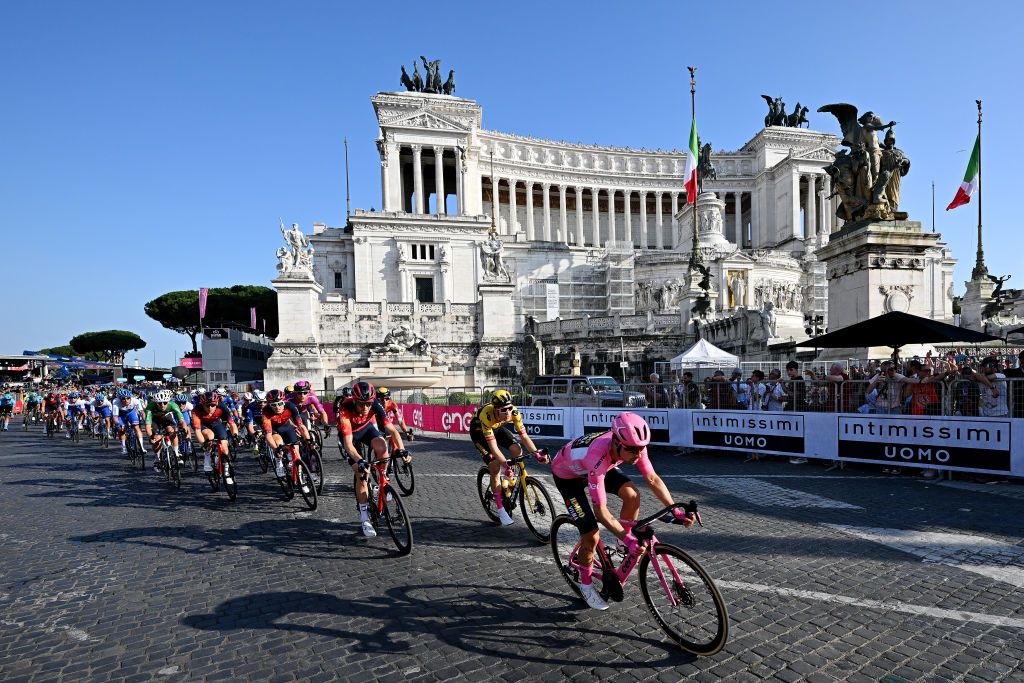
How to Watch 2024 Giro d’Italia
With a clear favorite, two time trials, and majestic mountain passes, cycling’s most beautiful Grand Tour promises a spectacle at its finest.
How to Watch the Giro d’Italia in Canada
How to watch the giro d’italia for free, what happened last year, riders to watch.
Here’s everything you need to know about the 2024 Giro d’Italia:
Dates: Saturday, May 4 - Sunday, May 26
How to Watch the Giro d’Italia in the U.S.
If you’re a Max subscriber ($9.99/month), then you have access to the streaming platform’s B/R Sports package, which is the only legal way to stream the Giro d’Italia in the USA. For now, the package is free to all regular Max subscribers, but at some point, it will cost an additional $9.99 each month. That’s not as affordable as GCN+ used to be, but considering everything else you get with the B/R Sports package (such as MLB, NHL, NBA, NCAA Men’s March Madness, U.S. Soccer, and 24 Hours of Le Mans coverage) it’s a pretty good deal.
Max has a user-friendly app for smartphones, streaming devices, game consoles, and smart TVs. There’s also an easy-to-navigate website, which is a helpful option for streaming the race from work. (Don’t worry, we won’t tell your boss.)
You could cancel your monthly subscription at the end of the race, but remember that Max will be offering live streams of many road, mountain, track, and cyclocross races throughout the rest of the year. If that floats your boat, consider getting an annual subscription for $99.99 (or $149.99 for ad-free streaming).
If you live in Canada, you can catch the action on FloBikes ($29.99 monthly or $150 for the year). Stream or cast from your desktop, mobile, or TV. The app is now available on Roku, Fire TV, Chromecast, and Apple TV. And live coverage starts at 7:45 AM EDT for most stages.
While we haven’t found legal ways to watch the Giro LIVE for free, you may be able to catch extended highlights on NBC/Peackock’s YouTube Channel a couple of hours after the events. However, where there is a will, there is a way. Just, “be careful with the ads.”
The 107th edition of the Giro d’Italia covers 3,386.7K (2,138 miles) over 21 stages, with two individual time trials, seven stages with uphill finishes, and six to eight stages expected to end with field sprints.
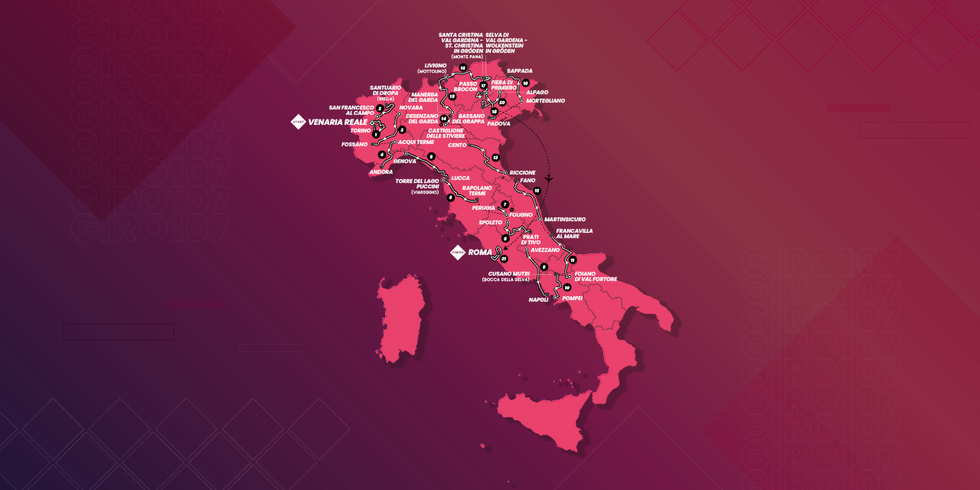
This year’s Grande Partenza takes place in Piemonte, near the French-Italian Alps, with two challenging road stages that will force the Giro’s GC contenders to be at their best right away. Stage 1, a 136K stage from Venaria Reale to Torino, features three categorized climbs–including the Superga and the Colle Maddalena–but it’s a short, punchy, uncategorized ascent just before the finish that could determine the stage winner.
Stage 2 begins in San Francesco al Campo and ends after 150K with this year’s first summit finish–on the Category 1 Santuario di Oropa, the climb on which deceased Italian legend Marco Pantani took one of his most famous stage wins in 1999. By the end of the first weekend, the GC battle will already be in full swing.
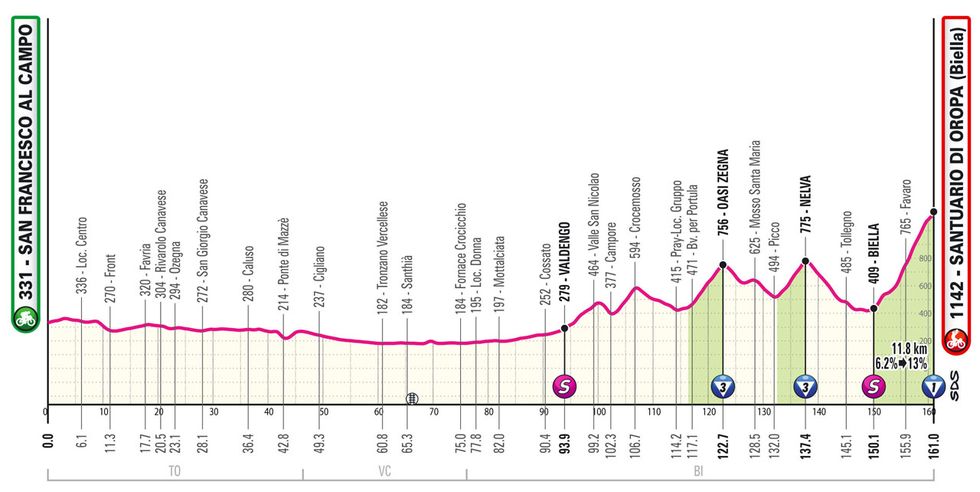
The race then begins working its way south, and Stages 3, 4, and 5—which finish in Fossano, Andora, and Lucca, respectively—should be days for the Giro’s sprinters. (Although the finishes of Stages 3 and 4 feature ramps inside the final 10K that could thwart the fast men.) Stage 6 brings the race from the coast into Tuscany (it finishes in Rapolano Terme) and features 12K of the strade bianche (“white gravel roads”) that give March’s Strade Bianche road race its name. If there’s one stage during the first week that has the potential to cause a few surprises, it’s this one.
Stage 7 is the first individual time trial of the Giro, and it’s a tough one: beginning in Foligno, the 37.2K race against the clock starts with over 30K of flat roads. But there’s a nasty sting in the course’s tail: a 6.5K climb to the finish line that starts steep and then ascends more gradually to the line. Riders who don’t pace themselves on the flat part of the course could explode on the final climb. There could be large time gaps here.
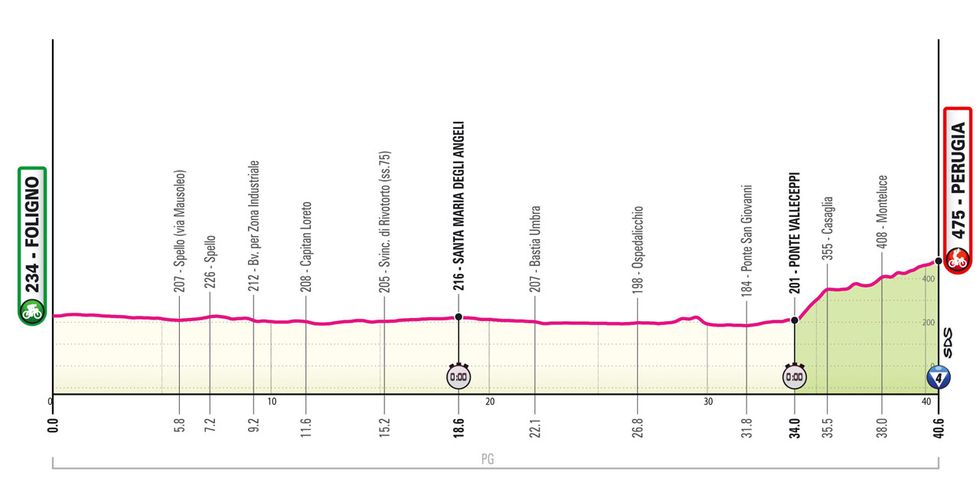
Starting in Spoleto, Stage 8 brings the second summit finish of the first week–on the Category 1 Prati di Tivo, a 14K climb in the Umbrian Apennines with an average gradient of 7%. With a field sprint expected in Napoli at the end of Sunday’s Stage 9 (after a 214K stage that starts in Avezzano), Stages 7 and 8 will determine which rider will wear the maglia rosa into the Giro’s first Rest Day.

The second week begins in Pompeii with Stage 10, a 142K stage that features a summit finish on a new climb, the Category 1 Bocca della Selva, a 20.9K climb with a deceiving 4.6% average gradient. The first few kilometers are actually downhill, so the climb is actually harder than its statistics suggest.
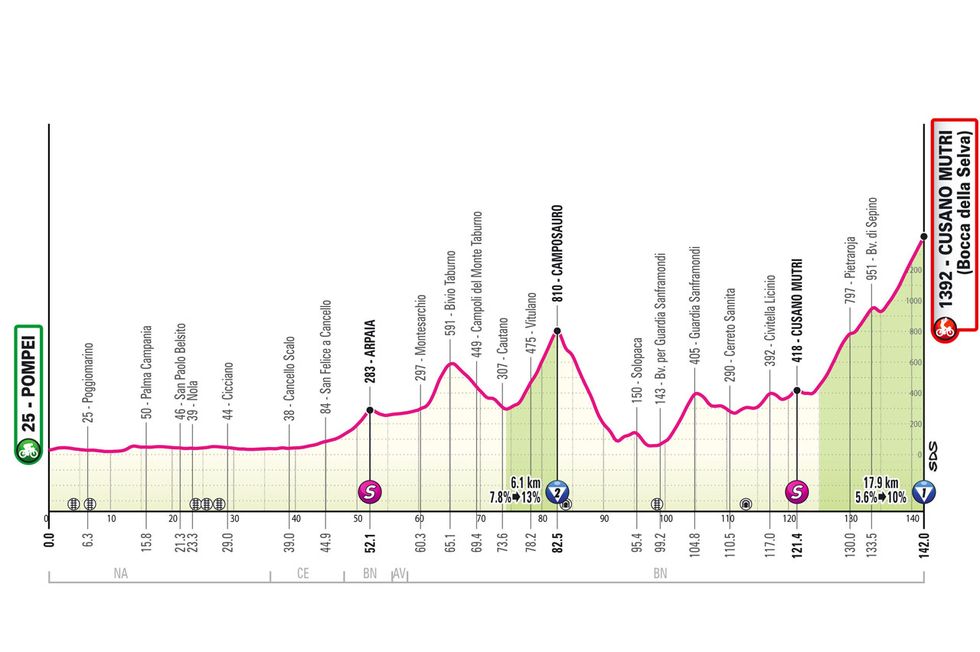
We expect Stage 11 (207K) to end with a field sprint in Francavilla al Mare, and Stage 12—with a jagged 190K stage through the Marche region (an area known for its muri or “walls”)—looks like the perfect day for a breakaway filled with puncheurs and riders who perform well in the spring classics. Friday’s Stage 13 is the flattest stage of this year’s race, which is probably a good thing considering the next two stages. This 179K stage from Riccione to Cento will be an active rest day for much of the peloton.
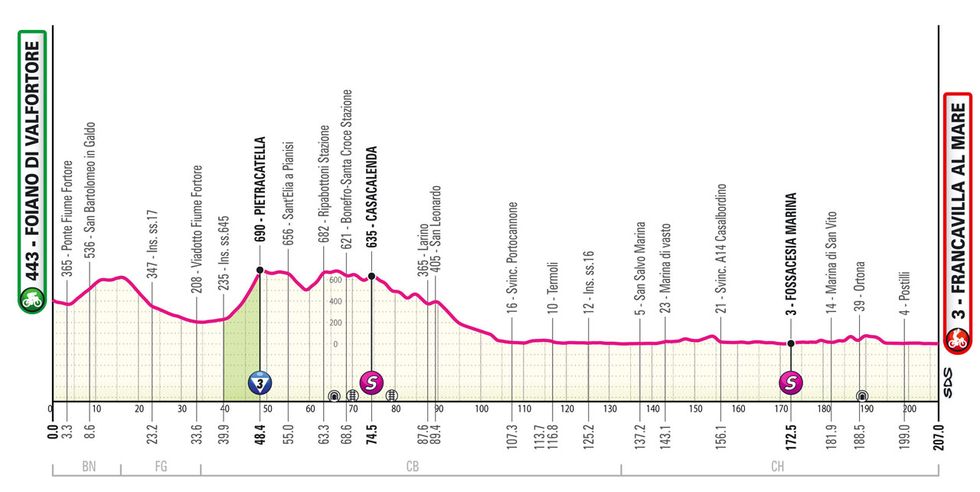
And they’ll need one because the third weekend begins with Stage 14–the Giro’s second individual time trial–a generally flat, 31K course from Castiglione delle Stiviere to Desenzano del Garda. This is a day for the Giro’s time trial specialists; the pure climbers will struggle to stay within shouting distance of their more powerful colleagues.
But they’ll have a chance for revenge on Sunday, when the race heads into the Alps for Stage 15, a 220K monster stage (the longest in this year’s race) with five categorized climbs, including back-to-back 2000m summits (both Category 1 ascents) at the end of the day, with a summit finish at the Mottolino ski resort just above Livigno. This weekend should blow the Giro wide open, leaving just a handful of riders still in contention to win the race overall.

The third week begins the same way the second week ends, with a 200K, high-altitude mountain stage. Stage 16 features the granddaddy of them all: the Stelvio, this year’s “Cima Coppi” as the highest summit in the race. Topping out at over 2700m, the climb comes early in the stage but will nonetheless offer a rude awakening to a peloton that’s coming out of the second Rest Day. After a long ride down into and through a valley, the day ends with the Category 1 Passo Pinei and then a summit finish on the Category 2 Monte Pana, in Santa Cristina in Val Gardena.
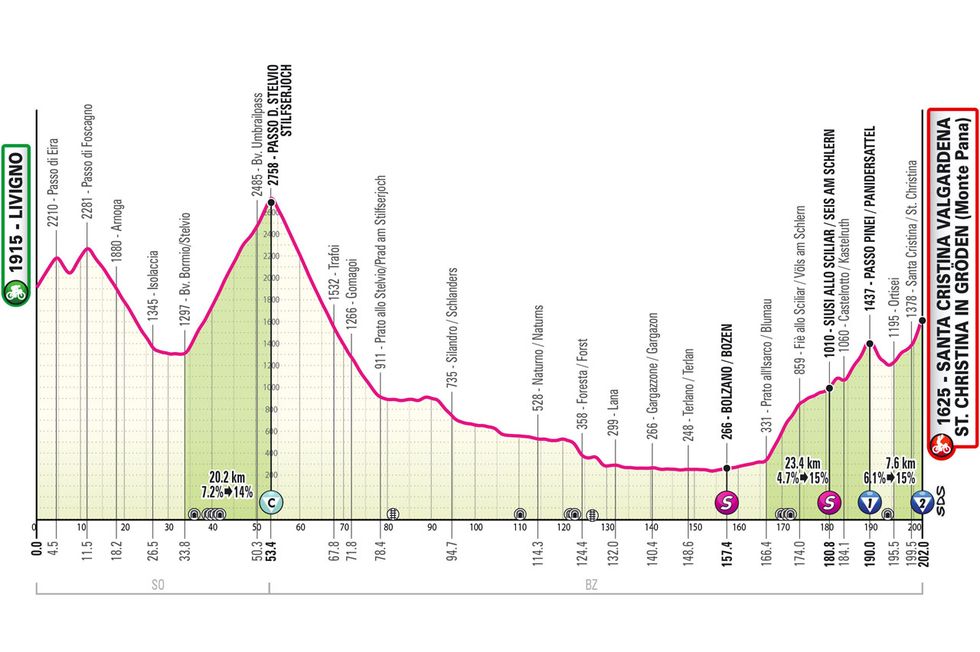
At “just” 159K, Stage 17 is much shorter than the previous two mountain stages, but it’s jammed with five categorized climbs, including the Category 2 Passo Sella and the Category 1 Passo Rolle. The day ends with two ascents of the Category 1 Passo Brocon, which the riders climb for a second time on their way to the finish line. This will be an intense stage, and it could pose a challenge for the team defending the pink jersey to control. The riders will be either climbing or descending from start to finish and if someone’s going to stage a third-week ambush, it could come here.
The next two stages offer a break from the mountains. Stage 18 brings a 166K downhill ride from Fiera di Primiero to Padua that should end with a field sprint. Stage 19 looks like the perfect chance for a small group of opportunists–who have likely been saving themselves in the high mountains–to escape and fight for a breakaway stage win in Sappada.
The 154K stage begins in Mortegliano and climbs steadily throughout the day, culminating with three categorized climbs in the second half stage, the last of which the riders summit just 7K from the finish. After so many days of intense climbing–and with one more day in the mountains still to come–the peloton could just sit back and let the break go all the way to the finish.
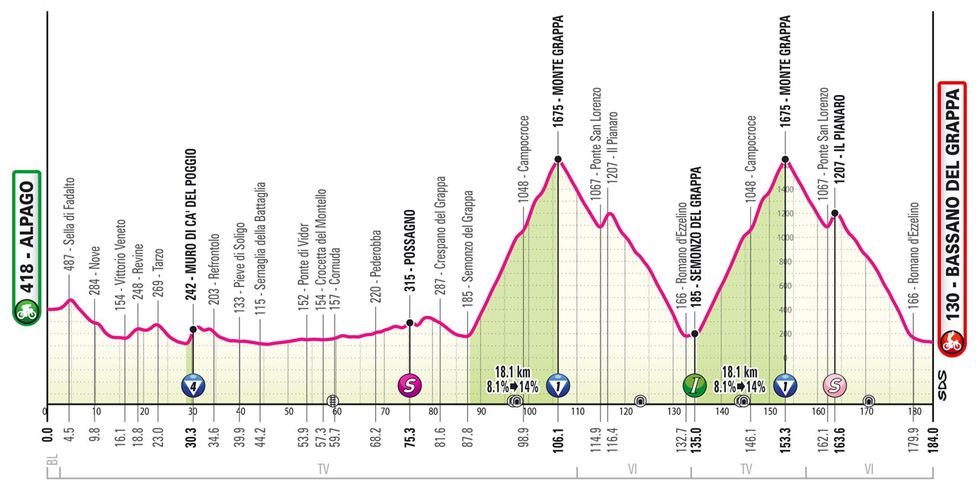
That sets the stage for Stage 20, the last chance for anyone hoping to steal the 2024 Giro d’Italia from whoever's been leading it. And–as the last two editions have shown us–that’s a realistic possibility. Starting in Alpago, the stage rolls along for about 85K before the first of two ascents of the Monte Grappa, an 18K climb with an average gradient of 8.1%–that’s steep . This isn’t a stage with a summit finish–the race finishes in Bassano del Grappa after a long descent from the top of the Monte Grappa down into the valley below–but even without one, the stage should still provide a dramatic conclusion to the Giro’s GC battle.
The race concludes Sunday in Rome with a 122K road stage featuring several circuits through the Eternal City. The day will begin with clinking glasses of prosecco, and end with one last chance for the sprinters to grab some glory.
You can find the elevation profiles and course maps for each 2024 Giro d’Italia stage here .
For the second year in a row, the 2023 Giro d’Italia was decided on the grand tour’s penultimate day. In 2022, Australia’s Jai Hindley (BORA-hansgrohe) took the pink jersey from Ecuador’s Richard Carapaz (INEOS Grenadiers) on Stage 20. Hindley won a mountain stage at the end of the grand tour’s first week, then hung around near the top of the General Classification before seizing his moment late in the Giro’s final mountain stage and winning the race overall.
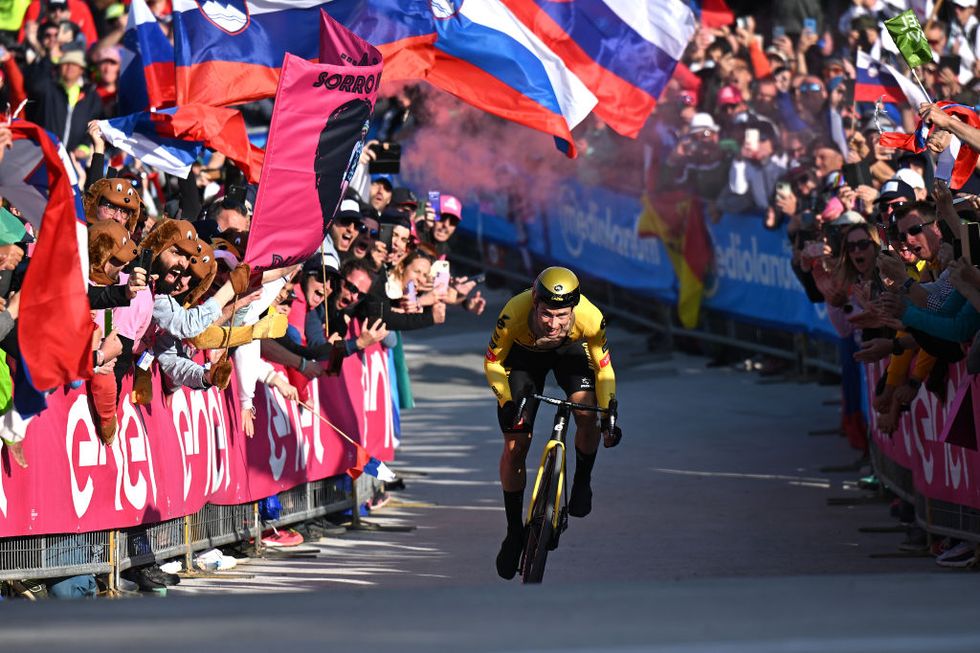
In 2023, Slovenia’s Primož Roglič (Jumbo-Visma) followed the same formula, albeit without an early-stage win. After Belgium’s Remco Evenepoel (Soudal-Quick Step)—who had won two stages and was wearing the pink jersey as the Giro’s overall leader—was forced to abandon the race after testing positive for Covid-19 on the eve of the Giro’s first Rest Day, Great Britain’s Geraint Thomas (INEOS Grenadiers) took the maglia rosa . With the exception of the two days straddling the second Rest Day, Thomas held the jersey for much of the second and third weeks.
But he cracked on Stage 20, an 18.6K uphill time trial from Tarvisio to the summit of the Monte Lussari. Roglič, who entered the day just 26 seconds behind Thomas on GC, won the stage by 40 seconds, taking the pink jersey–and the 2023 Giro–by a slim margin.
Thomas held on to finish second, and Portugal’s João Almeida (UAE Team Emirates) finished third. Italy’s Jonathan Milan (Bahrain-Victorious) won the Points Classification, France’s Thibaut Pinot (Groupama-FDJ) won the King of the Mountains Classification, and Almeida was the Giro’s Best Young Rider.
Tadej Pogačar (UAE Team Emirates)
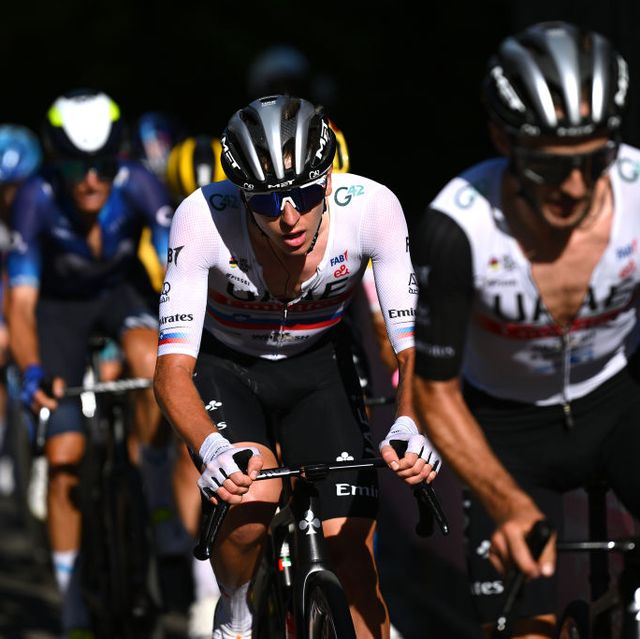
With most of the sport’s best grand tour riders (including Roglič) racing the Tour de France this summer, this year’s Giro has a short list of overall contenders, a list that’s headlined by one of the sport’s true superstars: Slovenia’s Tadej Pogačar (UAE Team Emirates).
The 25-year-old has never raced the Giro, and he takes the starting line this year as the favorite to win and dominate it. Then he’s planning to head to the Tour, where he’s hoping to become the first rider since Italy’s Marco Pantani in 1998 to win the Giro and the Tour in the same season.
Geraint Thomas (INEOS-Grenadiers)
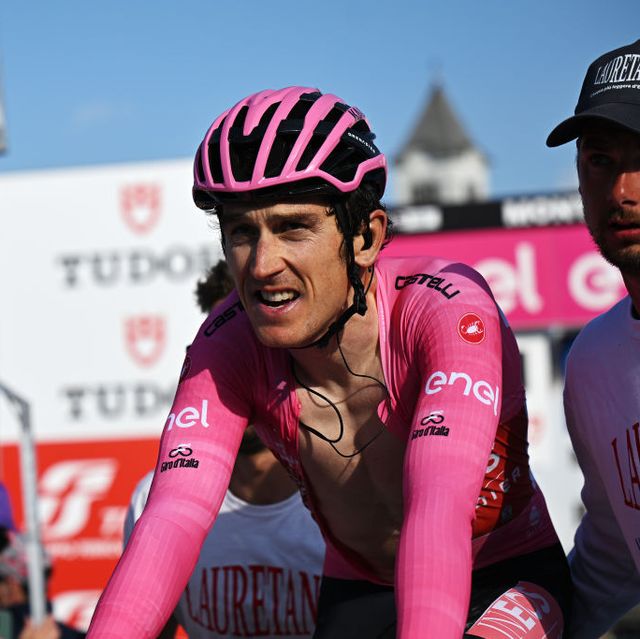
Pogačar’s biggest challenger will likely be Geraint Thomas, who’s coming back to the Giro after last year’s disappointment. The 37-year-old (he’ll turn 38 during the race) will have a strong and experienced team supporting him–and the course suits him–but he’ll have a hard time overcoming Pogačar.
Cian Uijtdebroeks (Visma-Lease a Bike)
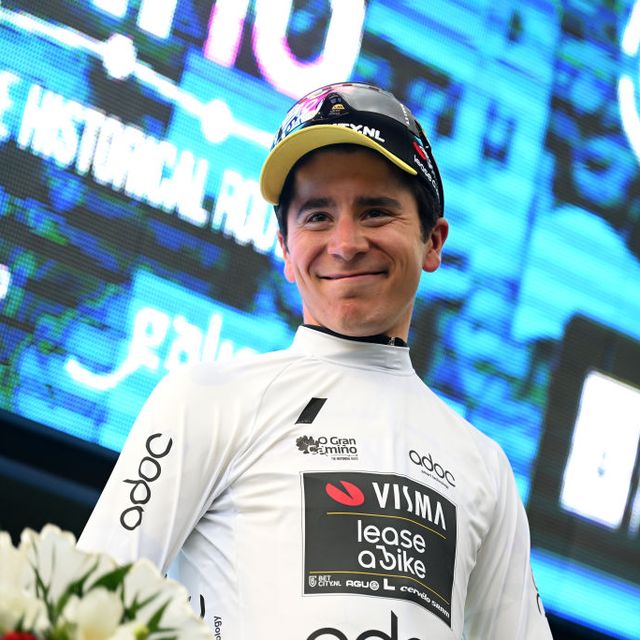
We’ll also be keeping an eye on Belgium’s Cian Uijtdebroeks (Visma-Lease a Bike), who made headlines last December when it was announced that he was breaking his contract with BORA-hansgrohe (who had recently signed Roglič away from Jumbo) to join the Dutch superteam.
The winner of the Tour de l‘Avenir in 2022, Uijtdebroeks just turned 21 and is widely considered to be a future grand tour contender. Without Belgium’s Wout van Aert, who’s skipping the Giro due to injuries he sustained in a crash at a race in Belgium a few weeks ago, Uijtdebroeks becomes the focus of the team’s Giro plans. And with a strong squad alongside him, he could finish on the podium and is the easy pick to become the Giro’s Best Young Rider.
Ben O’Connor (Decathlon AG2R La Mondiale)
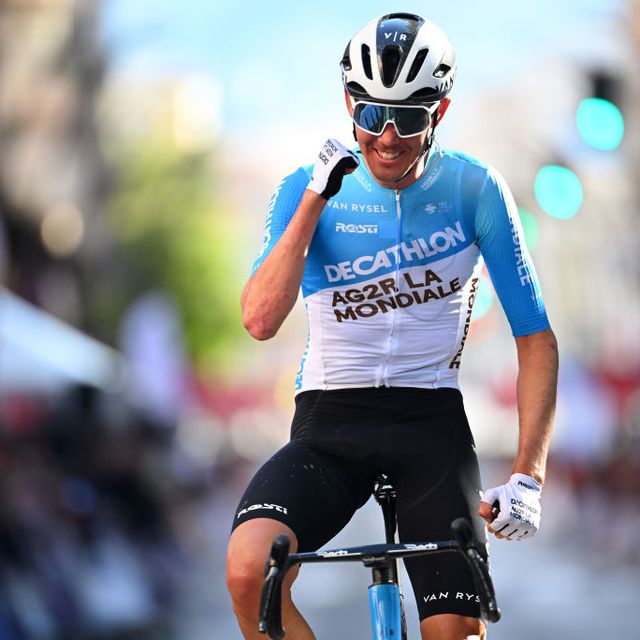
Other GC contenders include Australia’s Ben O’Connor (Decathlon AG2R La Mondiale), a former fourth-place finisher at the Tour de France and Giro stage-winner; Italy’s Damiano Caruso (Bahrain-Victorious), a former Giro podium-finisher; Colombia’s Daniel Martinez (BORA-hansgrohe), a former fifth-place finisher at the Giro; Great Britain’s Hugh Carthy (EF Education-EasyPost), a two-time top-10 finisher; and France’s Romain Bardet (Team dsm-firmenich PostNL), a former Tour de France podium finisher who was seventh at the Giro in 2021 but might be more of stage hunter this year.
Giulio Ciccone (Lidl-Trek)
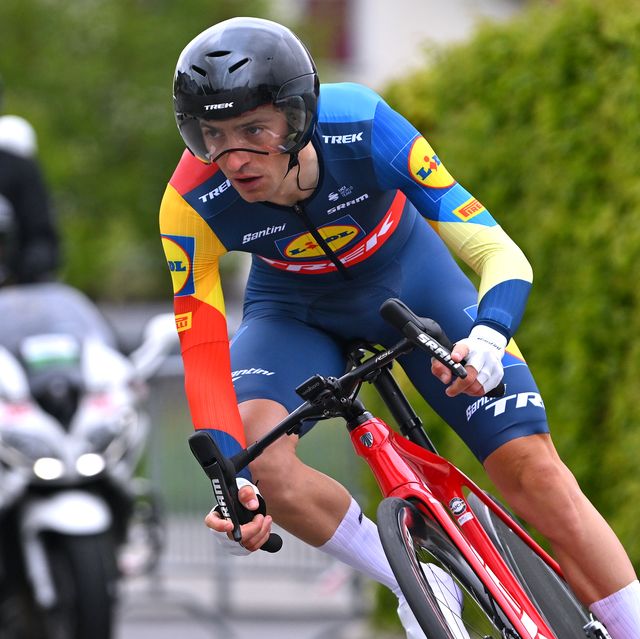
Other stage hunters include Italy’s Giulio Ciccone (Lidl-Trek), a three-time stage winner who was the Giro’s King of the Mountains in 2019; France’s Julian Alaphilippe (Soudal-Quick Step), who’s riding his first Giro; and Canada’s Michael Woods (Israel-PremierTech), who’s hoping to complete a hat-trick of grand tour stage victories with a win in Italy.
Nairo Quintana (Movistar)
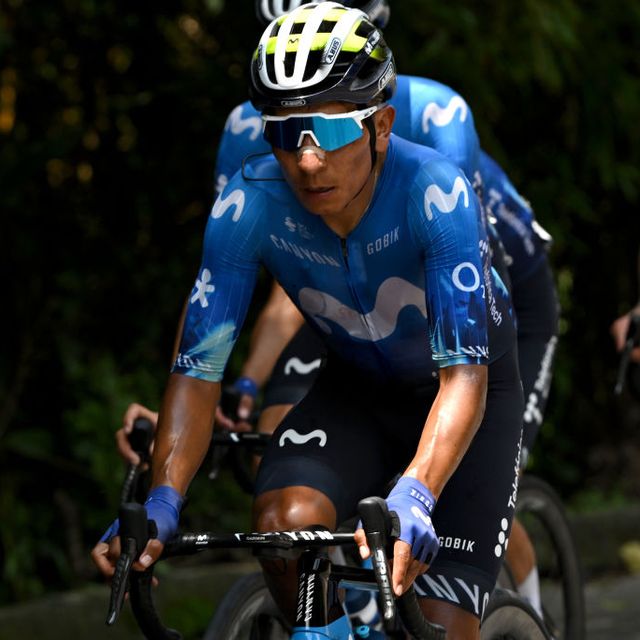
One of the most controversial riders in this year’s Giro will be Colombia’s Nairo Quintana (Movistar), winner of the Giro in 2014. But the 34-year-old hasn’t raced since finishing sixth overall in the 2022 Tour de France and then having his results disqualified after testing positive for tramadol, a painkiller that’s banned by the UCI (but not banned by WADA). He’s now back in the WorldTour with the team that made him famous. His return has not been a popular one , though, and it will be interesting to see how he’s received in Italy.
The Giro also offers several stage win opportunities for field sprinters, and that–plus the fact that the Tour de France is very not sprinter-friendly–means there will be lots of them taking the start, including Jonathan Milan (Lidl-Trek); Belgium’s Tim Merlier (Soudal–Quick Step); Dutch sprinters Olav Kooij (Visma-Lease a Bike) and Fabio Jakobsen (Team dsm-firmenich PostNL), and Australia’s Sam Welsford (BORA-Hansgrohe), Caleb Ewan (Jayco AlUla) and Kaden Groves (Alpecin-Deceuninck); and Eritrea’s Biniam Girmay (Intermarché-Wanty).
Last but not least, the Giro will see several North Americans taking the start, with Americans Larry Warbasse (Decathlon AG2R La Mondiale), Magnus Sheffield (INEOS Grenadiers), and Will Barta (Movistar) joining Woods on the starting line, with more expected to join them as teams finalize their rosters.

.css-1t6om3g:before{width:1.75rem;height:1.75rem;margin:0 0.625rem -0.125rem 0;content:'';display:inline-block;-webkit-background-size:1.25rem;background-size:1.25rem;background-color:#F8D811;color:#000;background-repeat:no-repeat;-webkit-background-position:center;background-position:center;}.loaded .css-1t6om3g:before{background-image:url(/_assets/design-tokens/bicycling/static/images/chevron-design-element.c42d609.svg);} 2024 Giro d'Italia

2024 Giro d’Italia Riders to Watch
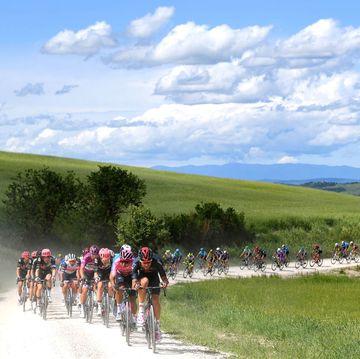
6 Must-Watch Stages of the 2024 Giro d’Italia
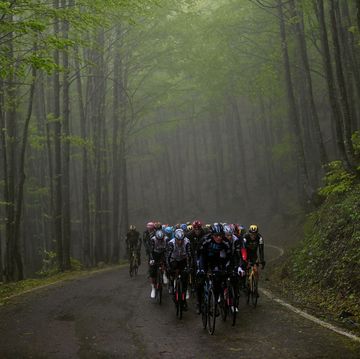
Is the Giro d’Italia the Tougher Grand Tour?
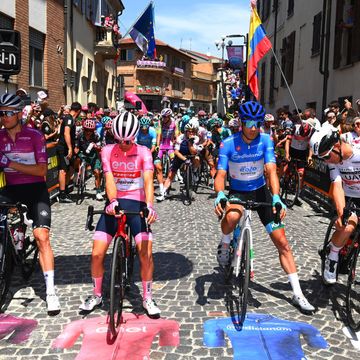
Giro d’Italia’s Jersey Colors: What They Mean

Luke Lamperti Gears Up for Giro d’Italia Debut
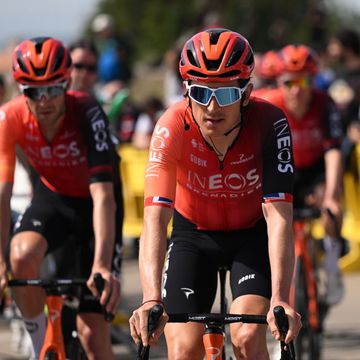
2024 Giro d’Italia | Geraint Thomas to Lead Ineos
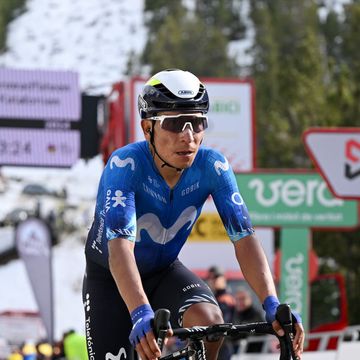
Nairo Quintana Will Focus on Stage Wins at Giro
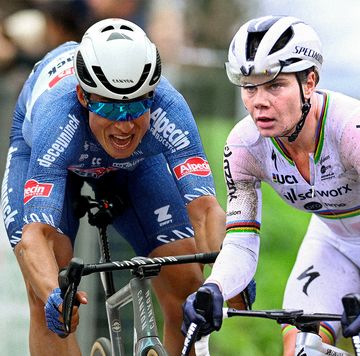
The Fastest Men and Women of the Grand Tours
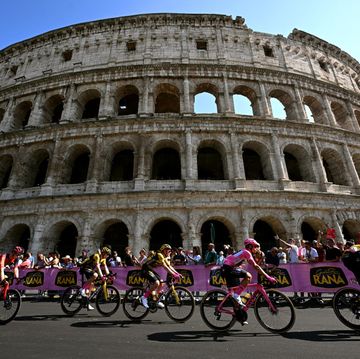
2024 Giro d’Italia | 6 Reasons to Be Psyched
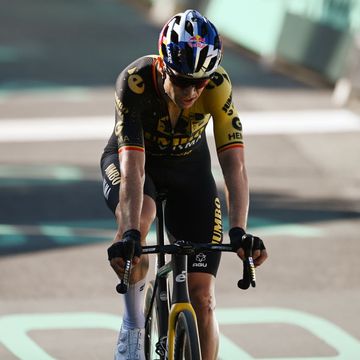
2024 Giro d’Italia | Van Aert Is Officially Out
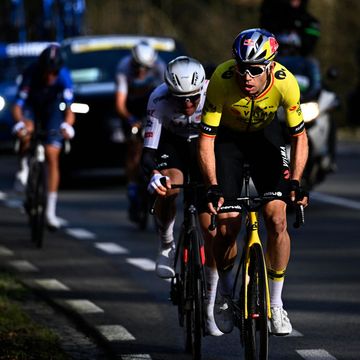
Van Aert’s Giro Dreams in Jeopardy

IMAGES
VIDEO
COMMENTS
How Are Tour de France Climbs Classified? Each of the mountain categories get increasingly more difficult from 4 to HC. The peeps in charge determine classifications based on gradient, distance, and max elevation: by Mikel Ortega. Category 4: The easiest climbs. Like pretty much a descent for the peloton.
The mountains classification is a secondary competition in the Tour de France, that started in 1933.It is given to the rider that gains the most points for reaching mountain summits first. The leader of the classification is named the King of the Mountains, and since 1975 wears the polka dot jersey (French: maillot à pois rouges), a white jersey with red polka dots.
In 1933, the Tour de France introduced the mountain classification. Riders received points when they were first to reach the summit, but at that time, there was only one category. Over the years, additional categories have been introduced, ranging from the most challenging Hors Catégorie ('beyond categorization') down to the 4th category.
Col du Platzerwasel - Stage 20. The 2023 Tour de France saves its final mountainous punch for Stage 20, a short, explosive stage through the Vosges mountains with a total of 3,600m of elevation ...
The 2014 Tour de France includes 25 climbs ranked Category 2 or higher of which six are Hors catégorie climbs, eleven Category 1 and eight are Second Category. There are seven "mountain top" finishes: at La Mauselaine (Category 3) and La Planche des Belles Filles in the Vosges, Chamrousse and Risoul in the Alps, and Saint-Lary Pla d'Adet and ...
Before the start of the Tour de France, the organization declares which stages are considered "flat", "medium mountain" or "high mountain". Flat stages typically have few or no categorized climbs (several 4th category and an occasional 3rd category), medium mountain stages have numerous climbs, typically 2nd and 3rd category, and high mountain ...
300-600 points - 1st category. 150-300 points - 2nd category. 75-150 points - 3rd category. Up to 75 points - 4th category. "I applied this [formula] to the Tour de France and went back over all the climbs about 15 years ago," says Gouvenou. "As it turned out, most of what had been done over the years fit within this framework.
category 1 = 10 category 2 = 6 category 3 = 14 category 4 = 22. This will be a long article. ... Its first appearance in 1986 was the highest mountain-top finish in Tour de France history (2413m ...
This year's route is quite mountainous, with mythical passes such as Galibier, Alpe d'Huez or Hautacam. In this article, we analysed all these climbs featuring in the 2022 Tour de France, including projected climbing times and watts. In total, there will be: 61 categorised climbs; 7 Hors Catégorie climbs; 10 category 1 climbs;
Following a quick dipping descent, it is back up again, this time for 8.1km Col de la Croix, a category 1 mountain. If the first two climbs hadn't shocked the legs enough, the Tour organizers threw in one last category 1 about 10km before the finish - the 15.4km Pas de Morgins at 1,377m in altitude.
The same holds for the hilly stages. Take for example stage 8 - hilly according to the Tour de France organization. With nearly 4000 meters of total elevation it is comparable with mountain stages 6 and 15. The only difference is that this elevation is of a lower category. This leaves us with the mountain stages 6, 12, 14 and 15.
The stage is the first alpine stage of this tour de France, the riders will pass one category 3 climb, one category 4 climb and three category 1 climbs for a total of 150.8km. ... the current tour de France climbing grade is based on the height of the mountain, climbing distance, the average slope and other factors to divide into 5 grades ...
Each hill or mountain in the Tour de France is placed into one of five categories based on difficulty. The toughest mountains will score 20-15-12-10-8-6-4-2 points, respectively, for first eight riders across. But that can fall to just one point to only the first rider for the smallest of hills. White jersey (maillot blanc)
The second Tour de France stage in Denmark runs past fjords and over some hills. Three category 4 mountain classifications - between race kilometres 60 and 85 - will determine the first winner of the mountain jersey at the end of the stage.
The race in 2023 visits 5 of France's mountain ranges, the Pyrenees, Massif Central, the Jura, the Alps, and the Vosges. There are only 2 climbs over 2,000m in the 2023 Tour de France with the highest being Col de la Loze at 2,304m, followed by Col du Tourmalet at 2,115m. Col de la Loze is also the longest climb of the 2023 Tour de France at ...
Reading time: 7 min Published on 4 December 2023, updated on 15 April 2024. The most famous cycle race in the world, the Tour de France will be taking to the skies once again this year, as the 3,404km and 21 stages will take in all 5 of France's mountain ranges! The Pyrenees, the Auvergne volcanoes, the Jura mountains, the Alps and the Vosges ...
The Tour de France included Mont Ventoux in 16 stages between 1951 and 2016, and it has been the finish on 10 of those, most recently in 2016 (as of 2020). "Mont Ventoux has become legendary as the scene of one of the most grueling climbs in the Tour de France bicycle race, which has ascended the mountain fifteen times since 1951.
Back-to-back days in the mountains await the Tour peloton. ... Tadej Pogacar (UAE Team Emirates) at the 2021 Tour de France (Image ... It is far more than a simple cote and is a category 1 climb ...
2024 Tour de France Jun 29 - Jul 21. 2024 Tour de France. This page provides a map of stage routes and categorized climbs, cols, and côtes in the 2024 Tour de France. Our dynamic "list" (center top of TdF map below) allows you to organize the climbs by stage number, difficulty, altitude gained, highest finish, distance, steepest, and more.
The average HC climb in the Tour de France from 2012 to 2016 is 16.1 kilometers long and has a grade of 7.4%. There are around 7 HC climbs per Tour. ... the mountains were divided into two categories, the first and the second category. The first category mountains gave 10 points to the first cyclist, similar to before 1939, and the second ...
The Col du Mollard is a mountain pass in the French Alps. It is located in the Savoie department, between the villages of Saint-Jean-de-Maurienne and Mont-de-Lans. The col du Mollard is one of the most famous mountain passes of Le Tour de France because it has been used many times in the race, most recently in 2013.
Mont Ventoux is iconic for its beauty, difficulty, and tragic history. The climb ascends about 13.3 miles with an average grade of 7.6% for a total elevation gain of more than 5,000 feet. The top ...
The longest climb is the climb to Col de la Croix de Fer from St Jean de Maurienne which is 29km at an average gradient of 5.2%. The shortest climb on the 2022 Tour de France is the first categorized climb, Côte de Pulventeux, which averages 12.3% for 800m on stage 6. At the time of putting this table together, there is some information not ...
Le Portet d'Aspin (1,489 metres) Like Tourmalet, le Col d'Aspin is a real classic for the Tour de France, which has climbed it 71 times. Thomas Voeckler was the last to conquer it in the lead, during the 16th stage of the 2012 Tour de France (Pau / Bagnères-de-Luchon), a race he went on to win after leading the day's four challenges (Aubisque, Tourmalet, Aspin and Peyresourde).
Stage 19: Second-last mountain stage will play major part in GC battle. Tour de France organizers may be avoiding Paris for the first time ever, due to the Olympic Games being held there, but the final three days of the race will be suspenseful right up to the finish in Nice. Stage 19 will see the climbers go all out for success, with 4,500 ...
Stage 14: The GC battle accelerates with one of the race's hardest mountain stages. Fifty years after the first inclusion of Pla d'Adet in the Tour de France, the mountain will feature once again as a summit finish. On its first use Raymond Poulidor triumphed and while his grandson Mathieu van der Poel won't be able to match his ...
Profile: Mountain stage. Stage 4: The first major exam for the Tour general classification contenders. ... The view of Tour de France race director Christian Prudhomme: "The race leaves Italy after a long climb to the resort of Sestrières, where Coppi triumphed in 1952, the border subsequently reached at the Col de Montgenèvre. Then, after ...
Please post it in the Tour de France 2024 Forum. How to unlock the Where are the mountain passes? achievement in Tour de France 2024: Finish the Breizh Cup. This achievement is worth 15 Gamerscore.
With a clear favorite, two time trials, and majestic mountain passes, cycling's most beautiful Grand Tour promises a spectacle at its finest. If you're a Max subscriber ($9.99/month), then you ...